The many, many reasons space travel is bad for the human body
Leaving earth upends almost every system inside of us.
After the astronaut Scott Kelly spent a year on the International Space Station, he returned to Earth shorter, more nearsighted, lighter and with new symptoms of heart disease that his identical twin brother did not share. (Mark Kelly, now a U.S. senator, also spent a brief time in space.)
Even their DNA diverged, as nearly 1,000 of Scott Kelly’s genes and chromosomes worked differently. (On the upside, he aged about 9 milliseconds less that year, thanks to how fast the space station circled the Earth.)
Most of these effects cleared up within a few months, but not all — underscoring the potential health hazards of space travel, many of which are unknown. These will ratchet up during ambitious future trips, such as NASA’s planned Artemis mission to the moon and later travel to Mars.
Even a partial list of the likely physical and emotional consequences of deep space travel is daunting.
Your browser does not support the video element.
Space motion sickness sets in almost immediately. The nausea, dizziness, headaches and confusion can linger for days.
“Puffy Face Bird Leg Phenomenon” develops, as blood and other bodily fluids rush to the upper body in low gravity and stay there, swelling heads and shrinking legs.
Astronauts’ appearances can change as their faces swell. The astronauts may feel congested, as though they have a constant head cold.
Muscles atrophy by as much as 1 percent every week in weightlessness, especially in the legs.
Blood volume drops — and with less blood to pump, the heart weakens and loses its signature heart shape, growing more rounded.
Like any other muscle, the heart doesn’t need to work as hard in microgravity and will begin to atrophy without rigorous exercise.
Doused with radiation, many immune cells die and immunity is lowered. There’s also DNA damage, potentially upping cancer risk.
Inflammation spikes throughout the body, possibly contributing to heart disease and other conditions.
Bones thin by about 1.5 percent a month. Spinal discs harden.
In the head, parts of the eyeball can flatten, causing sharper distance vision and dimmer near vision.
Fluids flood the skull, diminishing smell and hearing.
Gene activity changes, including in the brain. In mice, 54 different genes in the brain worked differently after weeks in space.
Brain cells can be affected by radiation, diminishing memory and thinking (in mice).
Circadian rhythms falter, making insomnia common.
Finally, months or years of solitude — or close confinement with fellow astronauts — can lead to lasting psychological stress.
“Space is just not very hospitable to the human body,” said Emmanuel Urquieta, chief medical officer at the Translational Research Institute for Space Health in Houston, which partners with NASA to study the effects of deep space exploration.
Humans evolved in conditions of plentiful gravity and relatively slight background radiation, he said. Space is the reverse and it upends the operations of almost every biological system inside of us. —
Most of the potential health risks of space travel can be mitigated to some extent, scientists point out. Exercise, for instance, “is quite effective” at helping astronauts maintain muscle mass and bone density, said Lori Ploutz-Snyder, the dean of the University of Michigan School of Kinesiology. She was previously a researcher at NASA, where she led studies of exercise and space travel.

The New Space Age
On the space station, astronauts routinely work out for about an hour most days, she said, using specialized devices to run, cycle and lift weights, despite being weightless. But on lunar and Mars missions, which will involve smaller ships and possibly years-long durations, exercise equipment will need to be shrunk and astronauts’ willingness to keep up with the workouts enlarged.
[ To counter the effect of sitting too much, try the astronaut workout ]
The Earth’s magnetic field shields the relatively close-in space station as well from some of the worst deep-space radiation, but the lunar and Mars missions — higher and farther from Earth — will not enjoy that protection.
The moon and Mars journeys will demand advanced shielding, Urquieta said, together with drugs and supplements that might lessen some of the internal effects of the remaining — and inevitable — radiation. Antioxidants, such as vitamins C and E, could sop up a portion of the damaging molecules released after radiation exposure, while other protective drugs and nutrients are under investigation, he said.
Despite every available precaution and protection, deep space will remain a harsh, unwelcoming place for the human body. But it will also, and always, represent something else for the human imagination, Urquieta said — its endless sweep of sequined darkness sparking our ambitions, dreams and stories.
Which is why, even knowing better than most people the toll such a trip might take on him, he would go into space “in a heartbeat,” he said. “Absolutely. No question. It’s so inspiring. It’s space."
About this story
Additional design and development by Betty Chavarria. Editing by Kate Rabinowitz, Manuel Canales and Jeff Dooley. Copy editing by Wayne Lockwood.

Suggested Searches
- Climate Change
- Expedition 64
- Mars perseverance
- SpaceX Crew-2
- International Space Station
- View All Topics A-Z
Humans in Space
Earth & climate, the solar system, the universe, aeronautics, learning resources, news & events.
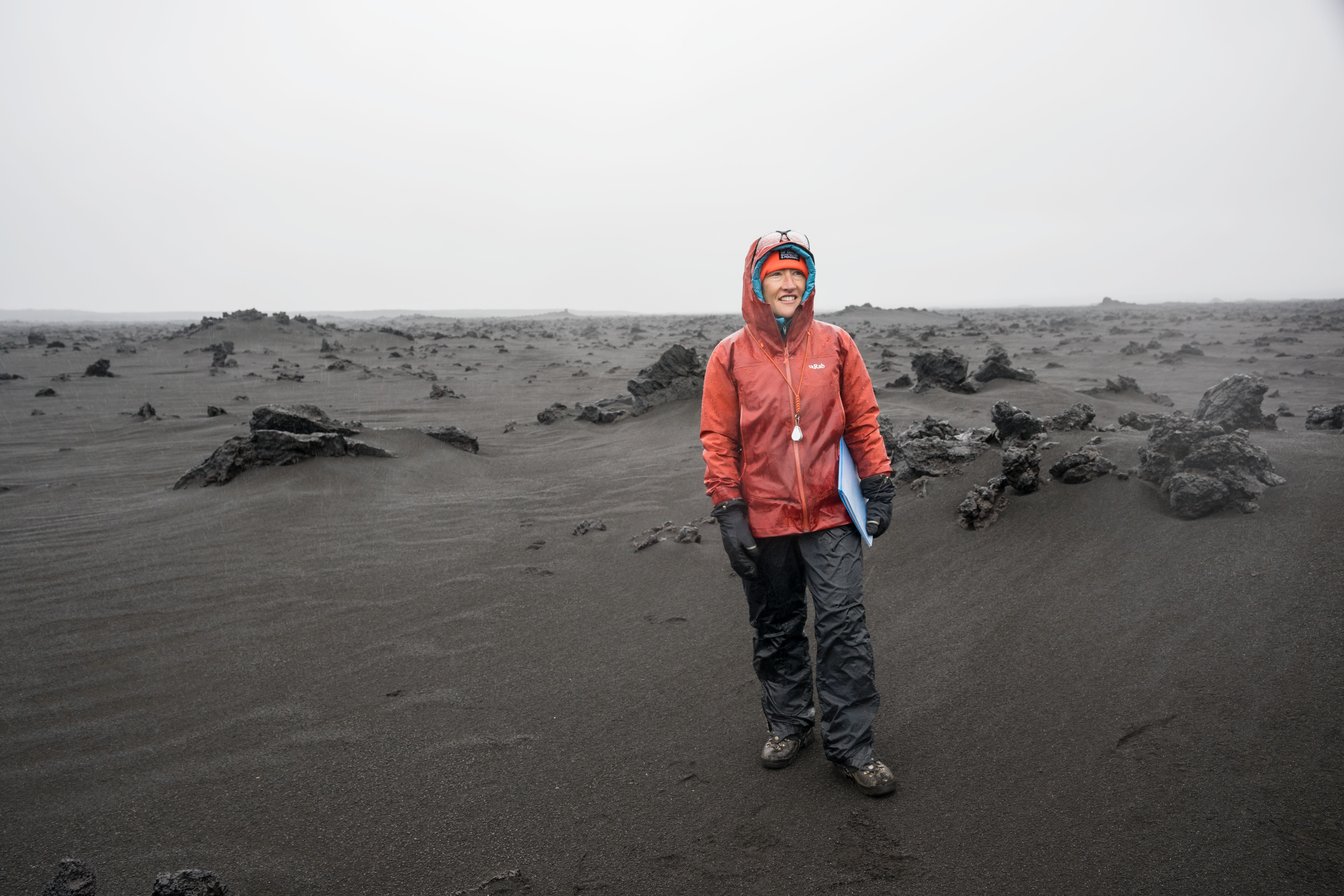
NASA’s Artemis II Crew Uses Iceland Terrain for Lunar Training
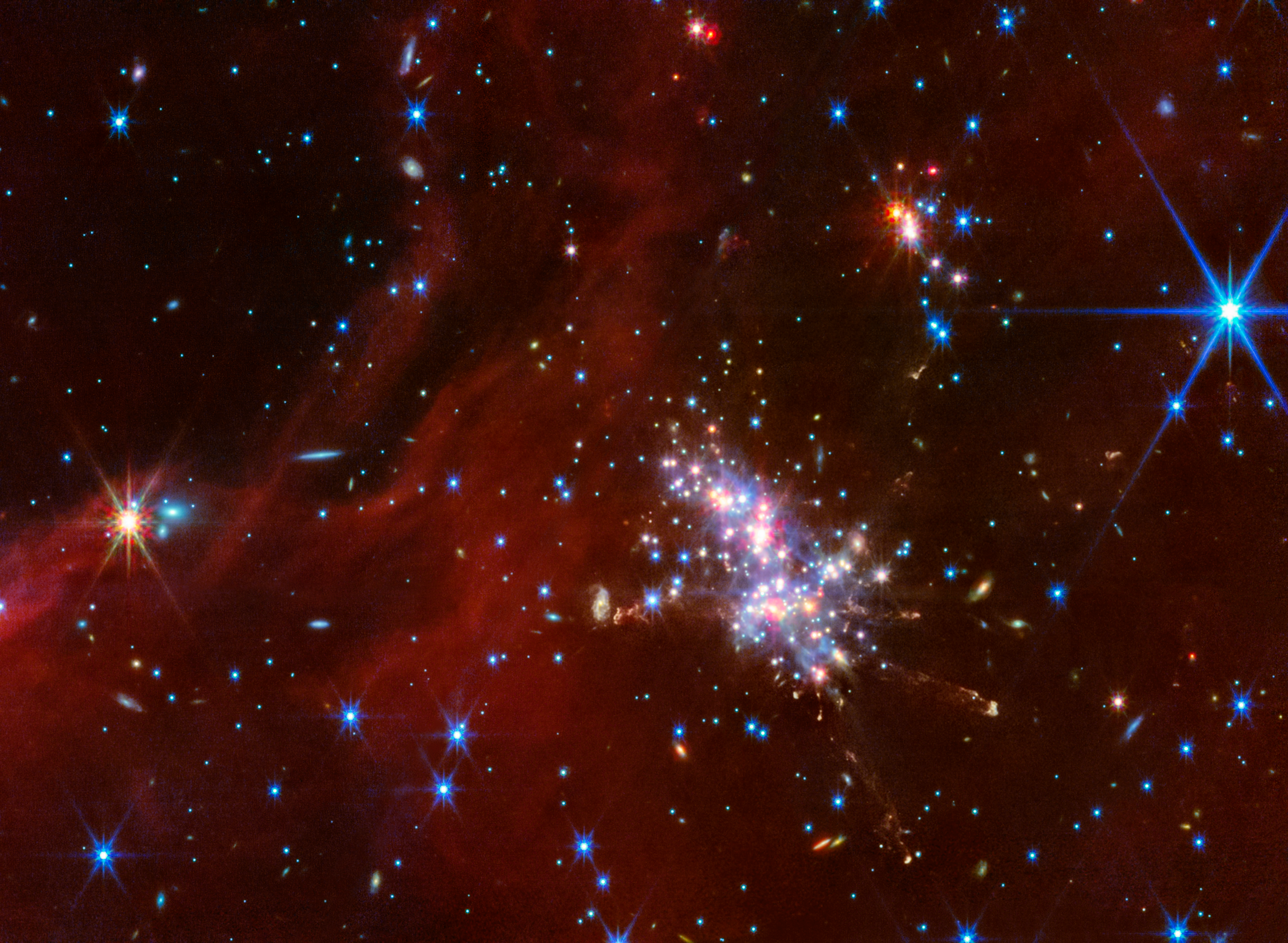
NASA’s Webb Peers into the Extreme Outer Galaxy

What’s Up: September 2024 Skywatching Tips from NASA
- Search All NASA Missions
- A to Z List of Missions
- Upcoming Launches and Landings
- Spaceships and Rockets
- Communicating with Missions
- James Webb Space Telescope
- Hubble Space Telescope
- Why Go to Space
- Commercial Space
- Destinations
- Living in Space
- Explore Earth Science
- Earth, Our Planet
- Earth Science in Action
- Earth Multimedia
- Earth Science Researchers
- Pluto & Dwarf Planets
- Asteroids, Comets & Meteors
- The Kuiper Belt
- The Oort Cloud
- Skywatching
- The Search for Life in the Universe
- Black Holes
- The Big Bang
- Dark Energy & Dark Matter
- Earth Science
- Planetary Science
- Astrophysics & Space Science
- The Sun & Heliophysics
- Biological & Physical Sciences
- Lunar Science
- Citizen Science
- Astromaterials
- Aeronautics Research
- Human Space Travel Research
- Science in the Air
- NASA Aircraft
- Flight Innovation
- Supersonic Flight
- Air Traffic Solutions
- Green Aviation Tech
- Drones & You
- Technology Transfer & Spinoffs
- Space Travel Technology
- Technology Living in Space
- Manufacturing and Materials
- Science Instruments
- For Kids and Students
- For Educators
- For Colleges and Universities
- For Professionals
- Science for Everyone
- Requests for Exhibits, Artifacts, or Speakers
- STEM Engagement at NASA
- NASA's Impacts
- Centers and Facilities
- Directorates
- Organizations
- People of NASA
- Internships
- Our History
- Doing Business with NASA
- Get Involved
NASA en Español
- Aeronáutica
- Ciencias Terrestres
- Sistema Solar
- All NASA News
- Video Series on NASA+
- Newsletters
- Social Media
- Media Resources
- Upcoming Launches & Landings
- Virtual Guest Program
- Image of the Day
- Sounds and Ringtones
- Interactives
- STEM Multimedia
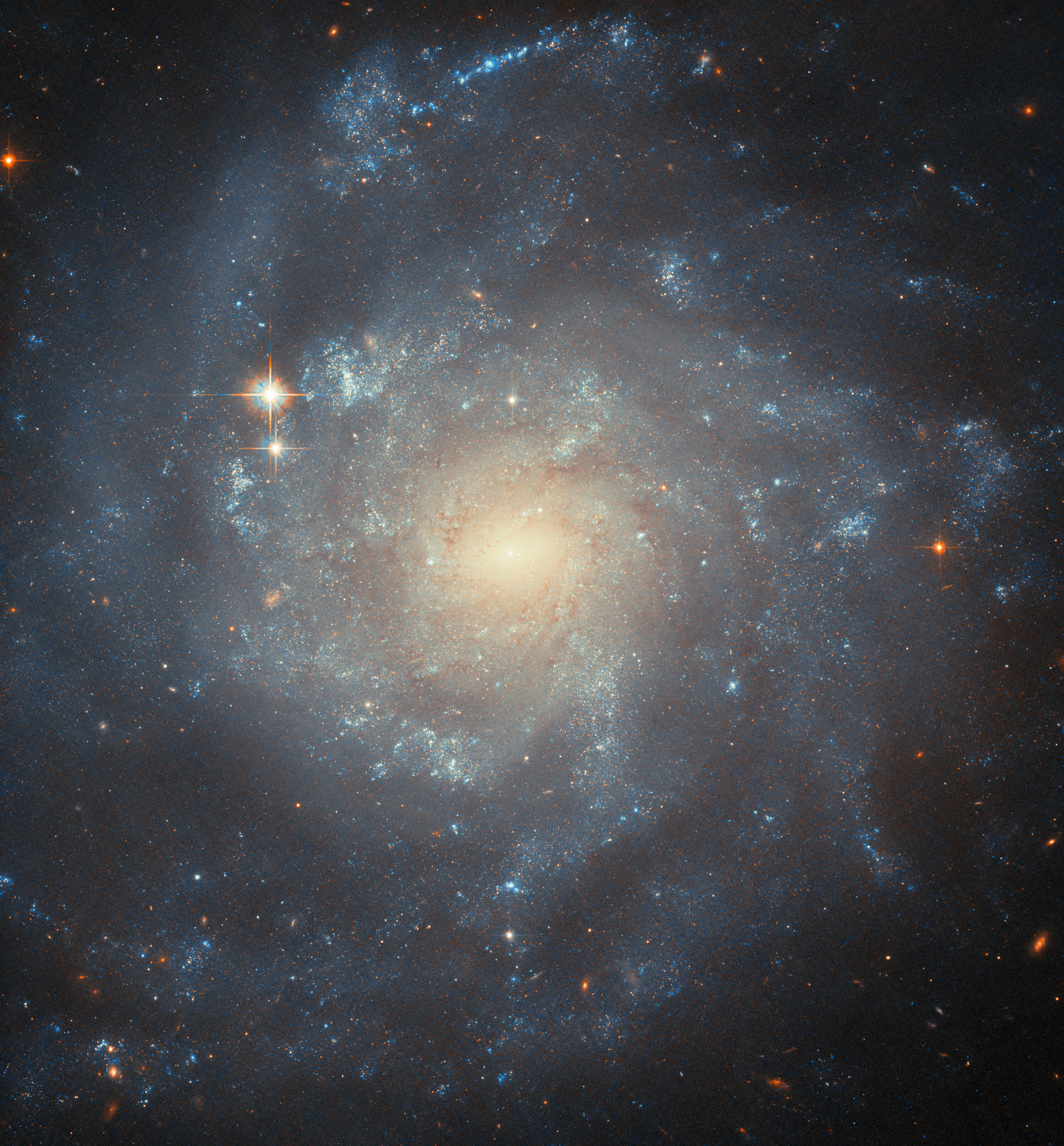
Hubble Examines a Spiral Star Factory
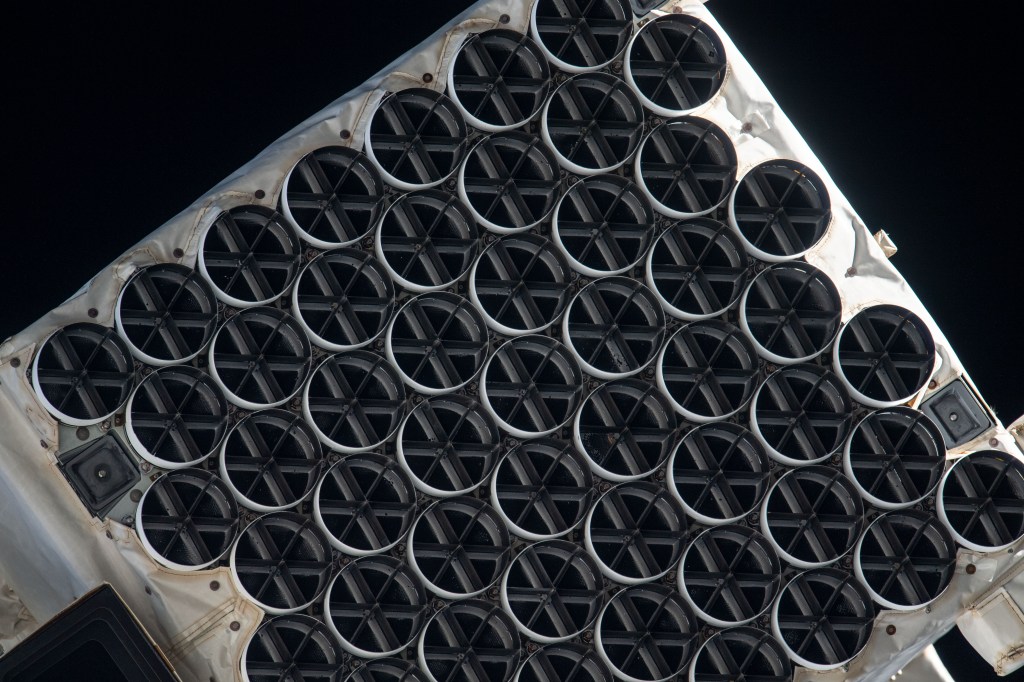
NASA’s SpaceX Crew-9 to Conduct Space Station Research

NASA Astronaut Tracy C. Dyson’s Scientific Mission aboard Space Station
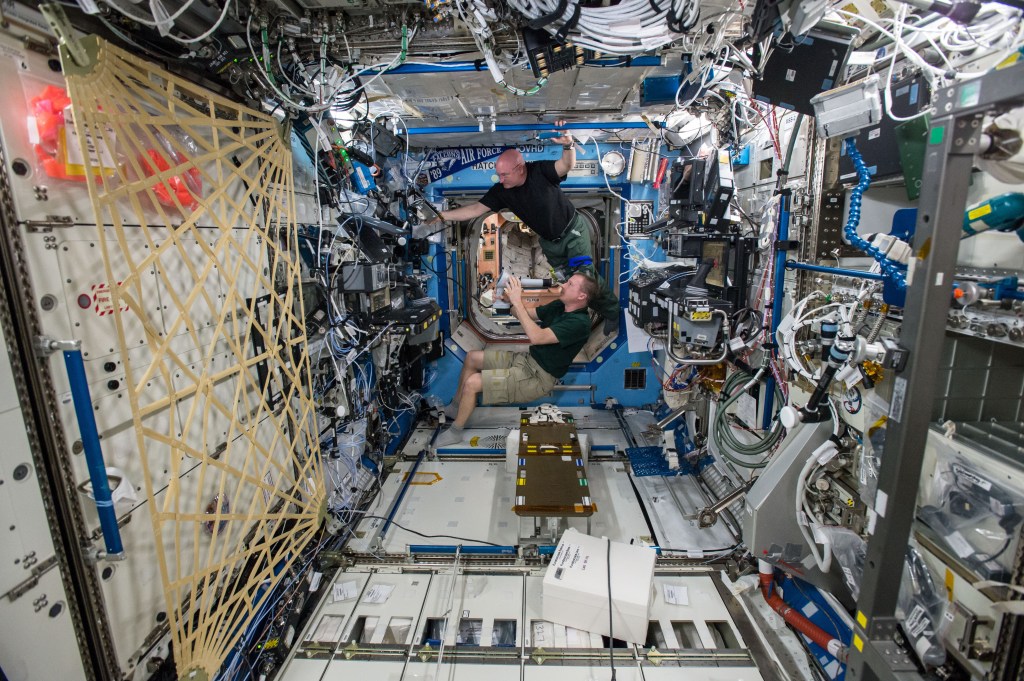
Station Science Top News: September 13, 2024
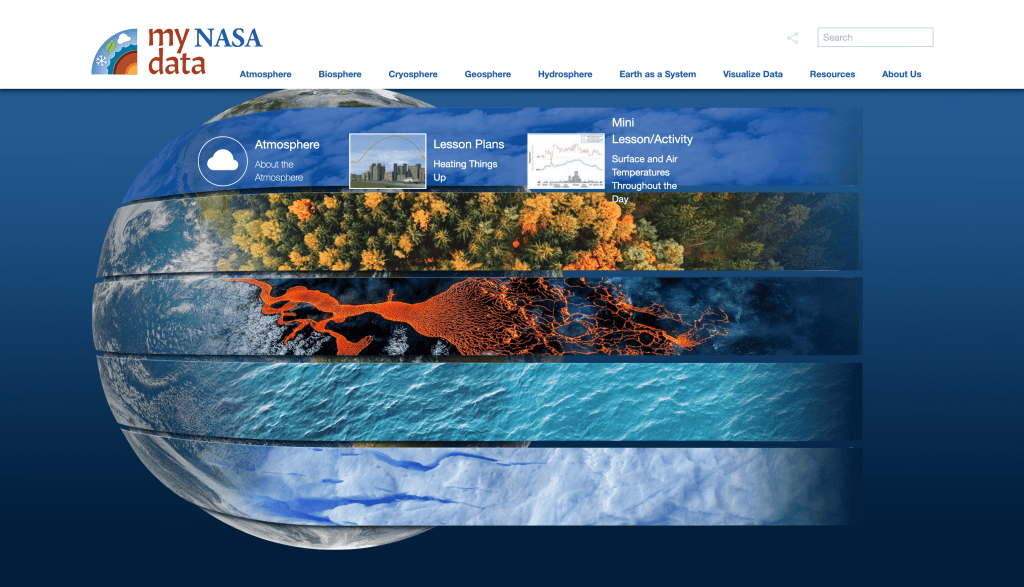
Going Back-to-School with NASA Data
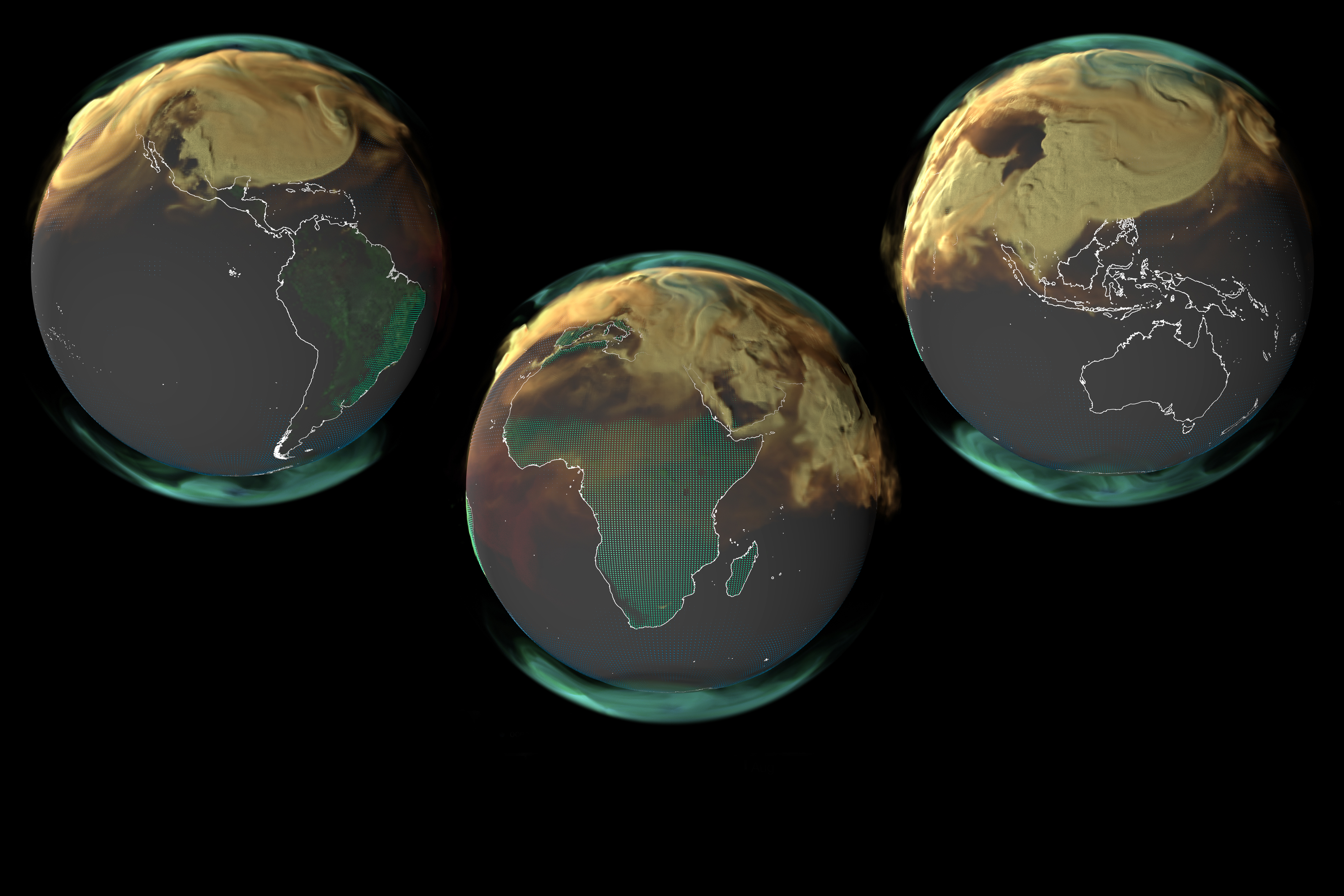
Amendment 48: A.5 Carbon Cycle Science Final Text and Due Dates.

NASA Finds Summer 2024 Hottest to Date
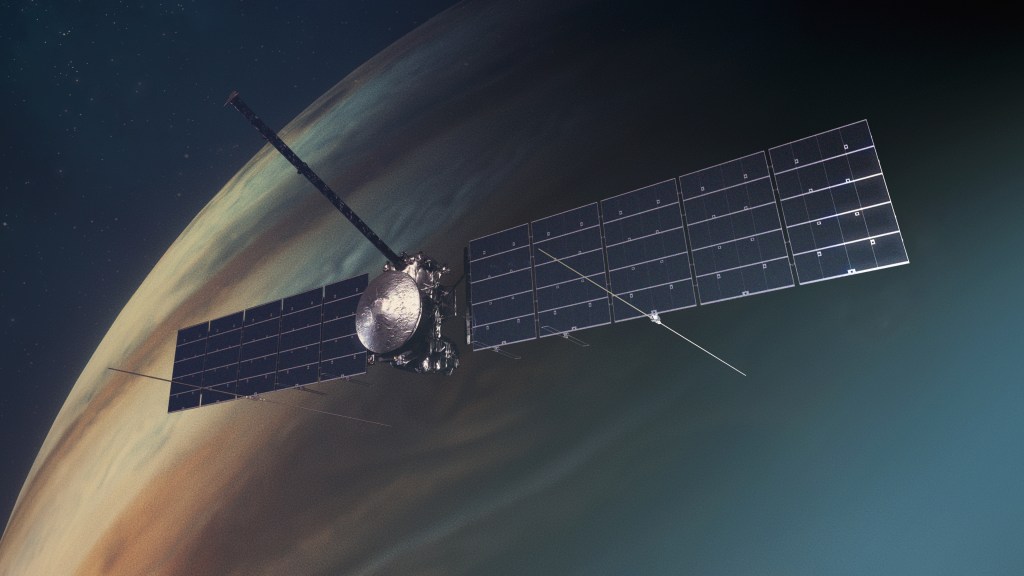
8 Things to Know About NASA’s Mission to an Ocean Moon of Jupiter
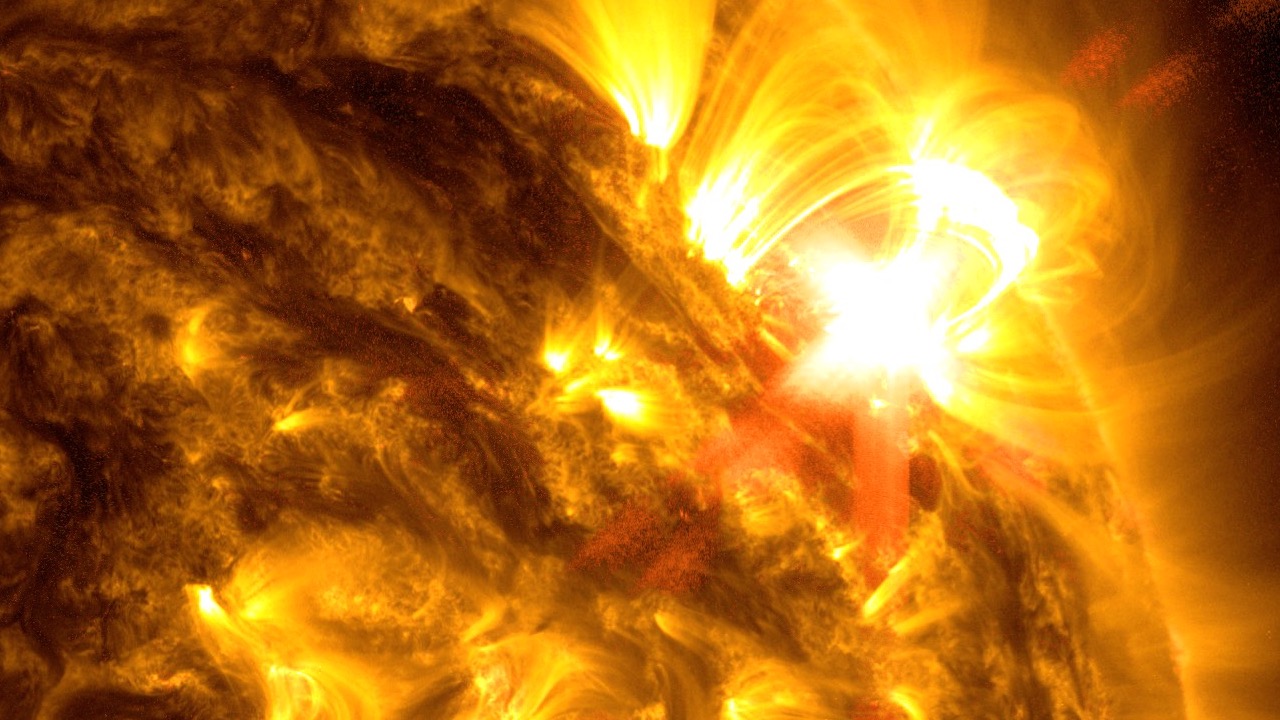
Solar Storms and Flares
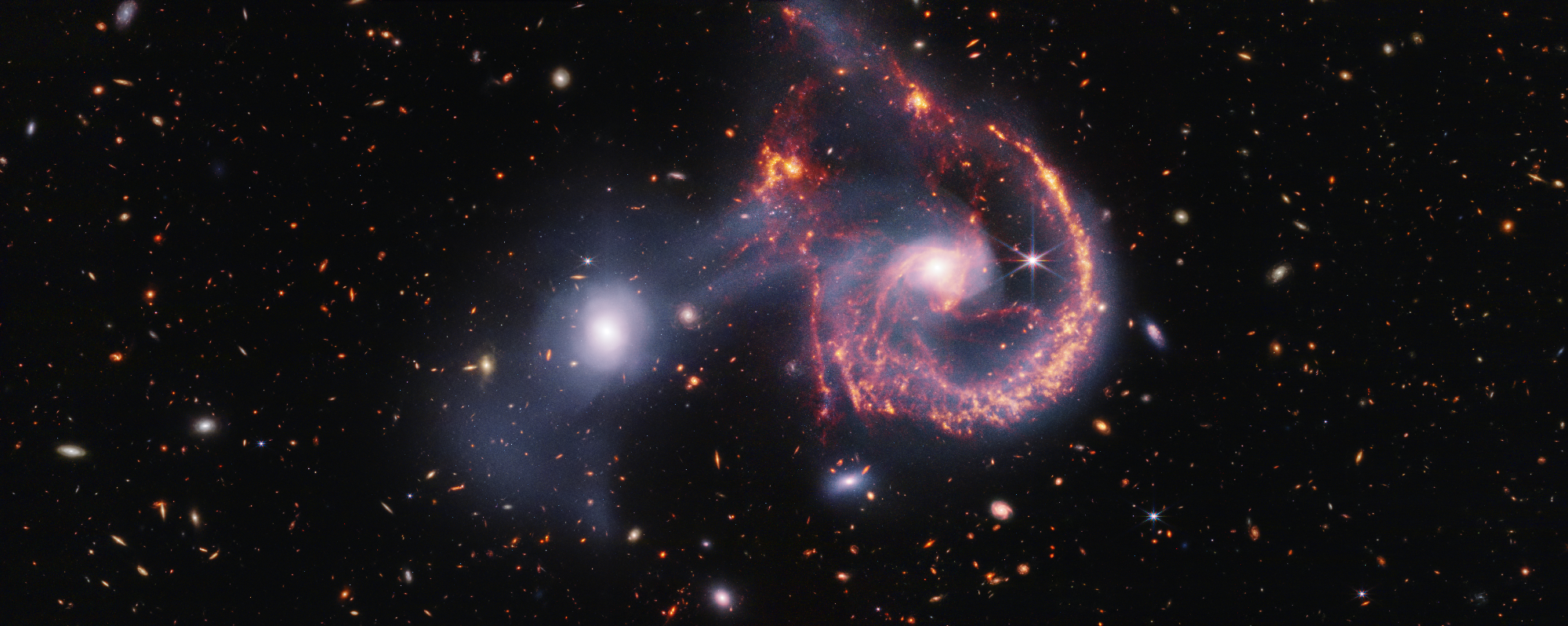
NASA’s Webb Provides Another Look Into Galactic Collisions
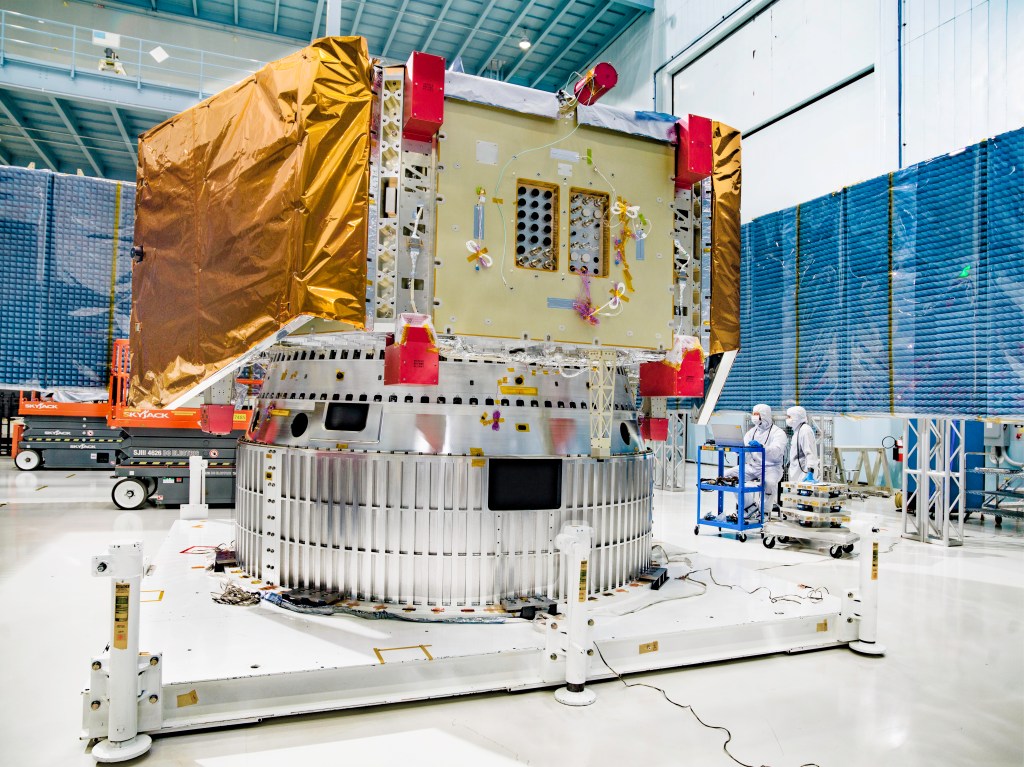
NASA Completes Spacecraft to Transport, Support Roman Space Telescope

NASA’s Hubble Finds More Black Holes than Expected in the Early Universe
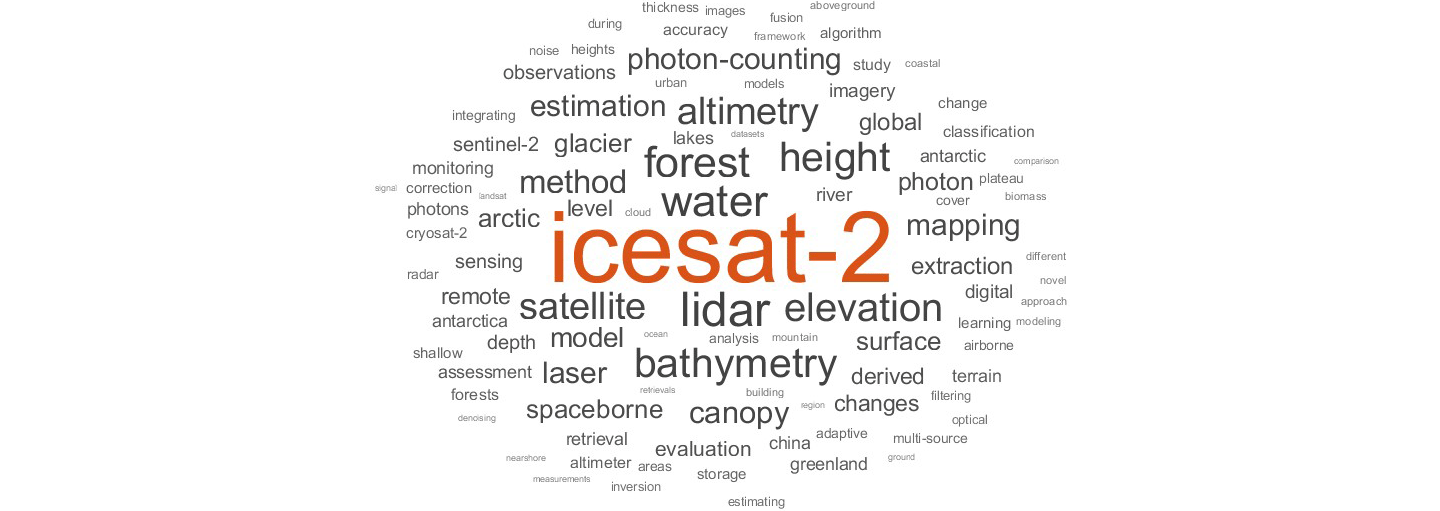
ICESat-2 Hosts Third Applications Workshop

Amendment 49: A.55 Decadal Survey Incubation Program: Science and Technology Final Text and Due Dates
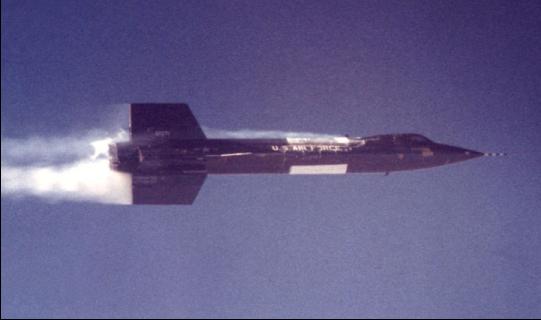
65 Years Ago: First Powered Flight of the X-15 Hypersonic Rocket Plane
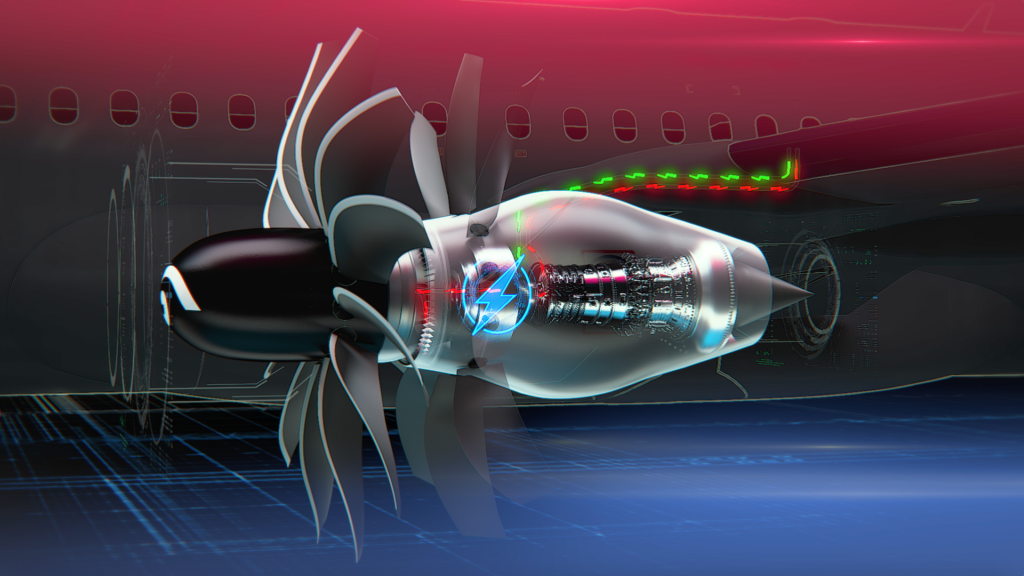
NASA, GE Aerospace Advancing Hybrid-Electric Airliners with HyTEC

NASA Tunnel Generates Decades of Icy Aircraft Safety Data
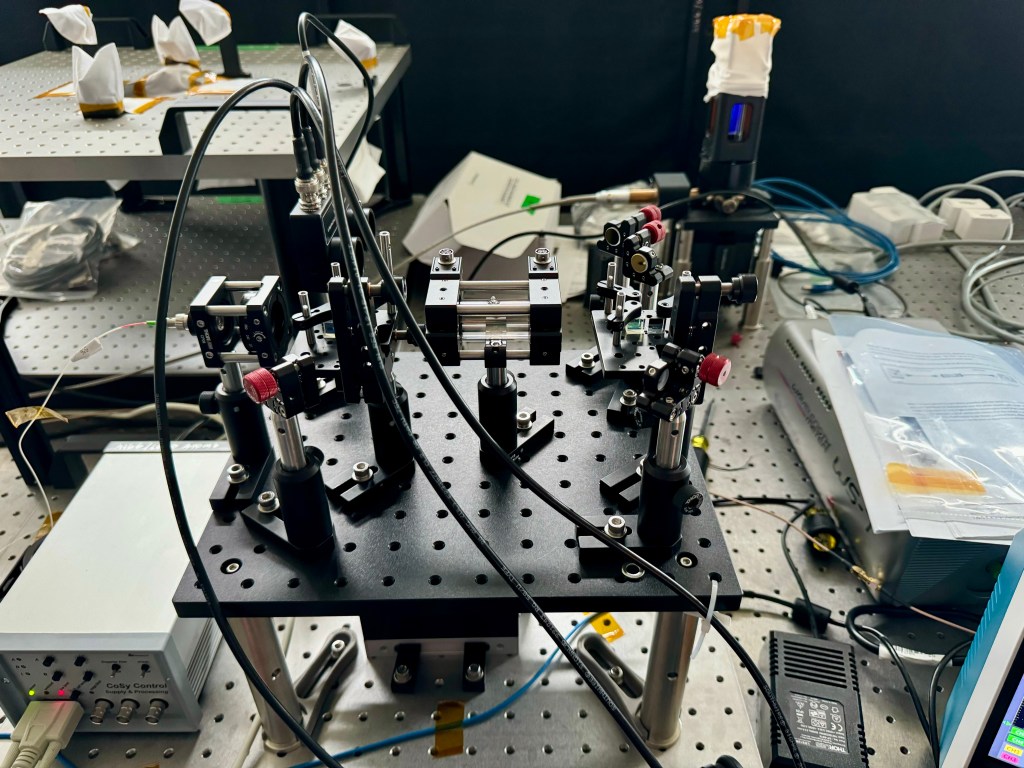
Reinventing the Clock: NASA’s New Tech for Space Timekeeping
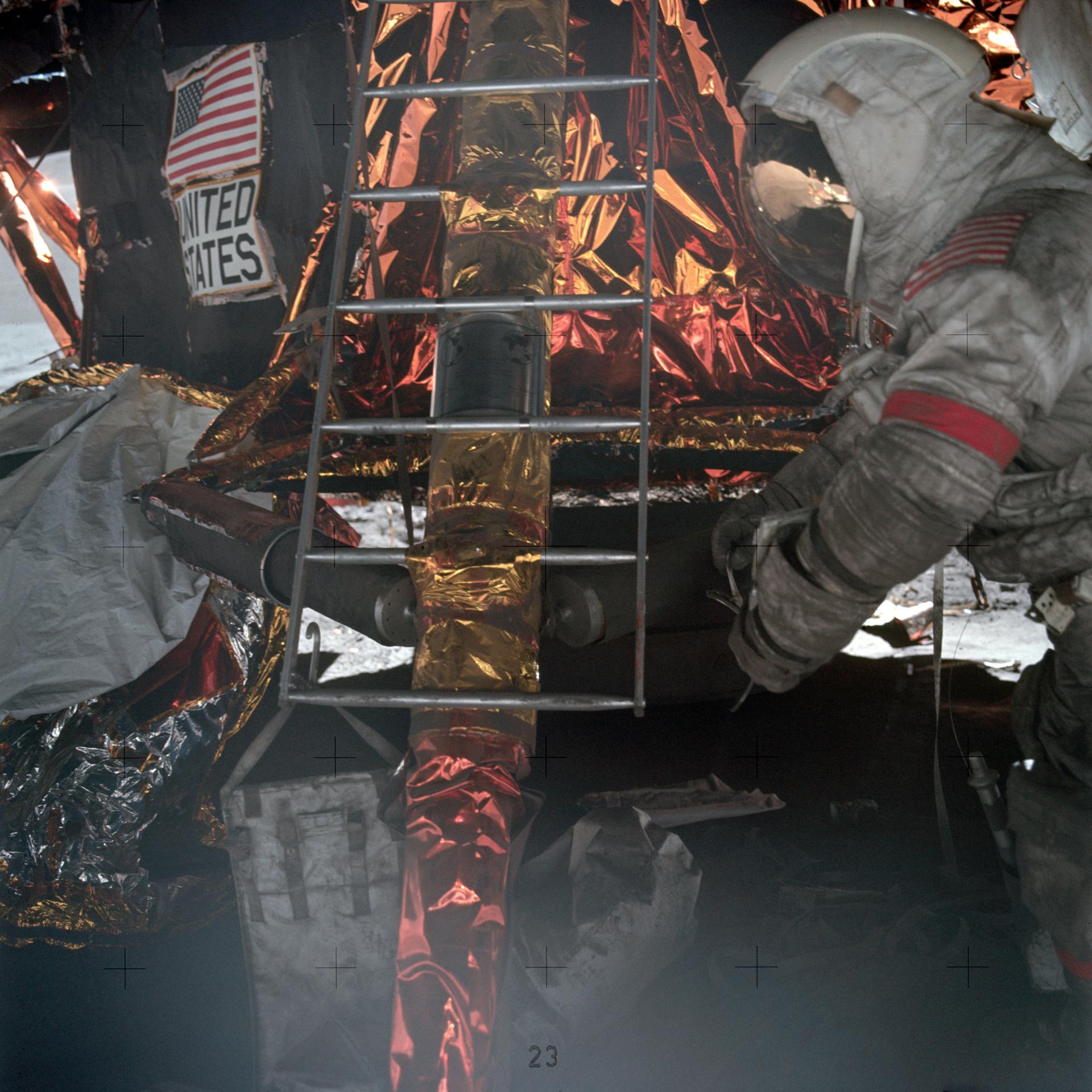
Measuring Moon Dust to Fight Air Pollution
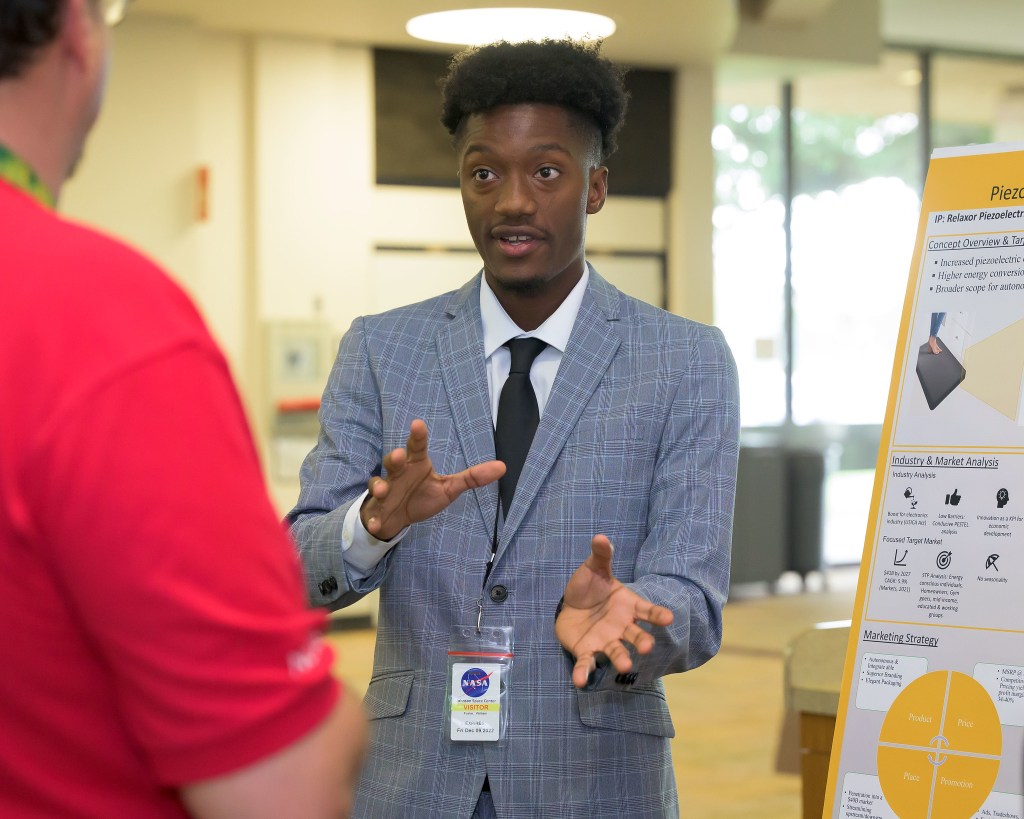
NASA Mobilizes Resource for HBCU Scholars, Highlighted at Conference

NASA Moon to Mars Architecture Art Challenge

Printed Engines Propel the Next Industrial Revolution

15 Years Ago: Japan launches HTV-1, its First Resupply Mission to the Space Station

La NASA invita a los medios al lanzamiento de Europa Clipper

El X-59 de la NASA avanza en las pruebas de preparación para volar

La NASA invita a creadores de las redes sociales al lanzamiento de la misión Europa Clipper
Five hazards of human spaceflight.

Educators, Students
Grade Levels
Grades 5-8, Grades 9-12, Higher Education
Life Science, Life Support, Living and Working in Space
Exploration to the Moon and Mars will expose astronauts to five known hazards of spaceflight:
- Space Radiation
- Isolation and Confinement
- Distance From Earth
- Gravity Fields
- Hostile Closed Environments
Watch a playlist of videos to explain each hazard and to learn what NASA’s Human Research Program is doing to protect humans in space.
Five Hazards of Human Spaceflight Playlist
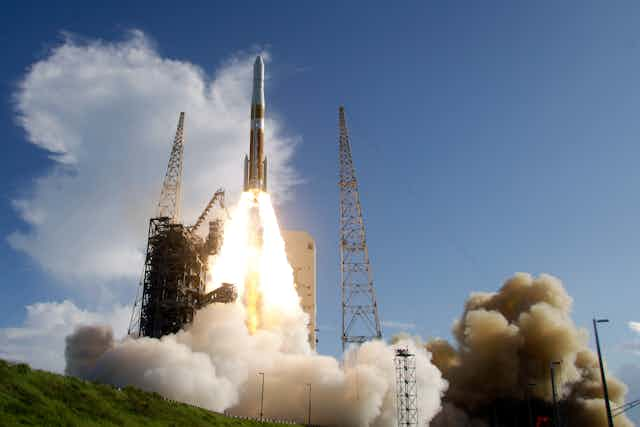
Spending time in space can harm the human body − but scientists are working to mitigate these risks before sending people to Mars
Professor of Applied Physiology & Kinesiology, University of Florida
Disclosure statement
Rachael Seidler receives funding from the National Aeronautics and Space Administration, the Translational Research Institue for Space Health, the National Science Foundation, the National Institutes of Health, and the Office of Naval Research.
University of Florida provides funding as a founding partner of The Conversation US.
View all partners
When 17 people were in orbit around the Earth all at the same time on May 30, 2023, it set a record. With NASA and other federal space agencies planning more manned missions and commercial companies bringing people to space, opportunities for human space travel are rapidly expanding.
However, traveling to space poses risks to the human body. Since NASA wants to send a manned mission to Mars in the 2030s, scientists need to find solutions for these hazards sooner rather than later.
As a kinesiologist who works with astronauts, I’ve spent years studying the effects space can have on the body and brain. I’m also involved in a NASA project that aims to mitigate the health hazards that participants of a future mission to Mars might face.
Space radiation
The Earth has a protective shield called a magnetosphere , which is the area of space around a planet that is controlled by its magnetic field . This shield filters out cosmic radiation . However, astronauts traveling farther than the International Space Station will face continuous exposure to this radiation – equivalent to between 150 and 6,000 chest X-rays .
This radiation can harm the nervous and cardiovascular systems including heart and arteries , leading to cardiovascular disease. In addition, it can make the blood-brain barrier leak . This can expose the brain to chemicals and proteins that are harmful to it – compounds that are safe in the blood but toxic to the brain.
NASA is developing technology that can shield travelers on a Mars mission from radiation by building deflecting materials such as Kevlar and polyethylene into space vehicles and spacesuits . Certain diets and supplements such as enterade may also minimize the effects of radiation. Supplements like this, also used in cancer patients on Earth during radiation therapy, can alleviate gastrointestinal side effects of radiation exposure.
Gravitational changes
Astronauts have to exercise in space to minimize the muscle loss they’ll face after a long mission. Missions that go as far as Mars will have to make sure astronauts have supplements such as bisphosphonate , which is used to prevent bone breakdown in osteoporosis. These supplements should keep their muscles and bones in good condition over long periods of time spent without the effects of Earth’s gravity .
Microgravity also affects the nervous and circulatory systems. On Earth, your heart pumps blood upward, and specialized valves in your circulatory system keep bodily fluids from pooling at your feet. In the absence of gravity, fluids shift toward the head.
My work and that of others has shown that this results in an expansion of fluid-filled spaces in the middle of the brain. Having extra fluid in the skull and no gravity to “hold the brain down” causes the brain to sit higher in the skull , compressing the top of the brain against the inside of the skull.
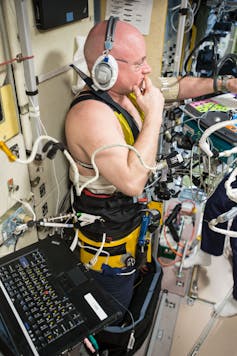
These fluid shifts may contribute to spaceflight associated neuro-ocular syndrome , a condition experienced by many astronauts that affects the structure and function of the eyes . The back of the eye can become flattened, and the nerves that carry visual information from the eye to the brain swell and bend. Astronauts can still see, though visual function may worsen for some. Though it hasn’t been well studied yet, case studies suggest this condition may persist even a few years after returning to Earth.
Scientists may be able to shift the fluids back toward the lower body using specialized “pants ” that pull fluids back down toward the lower body like a vacuum. These pants could be used to redistribute the body’s fluids in a way that is more similar to what occurs on Earth.
Mental health and isolation
While space travel can damage the body, the isolating nature of space travel can also have profound effects on the mind .
Imagine having to live and work with the same small group of people, without being able to see your family or friends for months on end. To learn to manage extreme environments and maintain communication and leadership dynamics, astronauts first undergo team training on Earth.
They spend weeks in either NASA’s Extreme Environment Mission Operations at the Aquarius Research Station , found underwater off the Florida Keys, or mapping and exploring caves with the European Space Agency’s CAVES program . These programs help astronauts build camaraderie with their teammates and learn how to manage stress and loneliness in a hostile, faraway environment.
Researchers are studying how to best monitor and support behavioral mental health under these extreme and isolating conditions.
While space travel comes with stressors and the potential for loneliness, astronauts describe experiencing an overview effect : a sense of awe and connectedness with all humankind. This often happens when viewing Earth from the International Space Station.
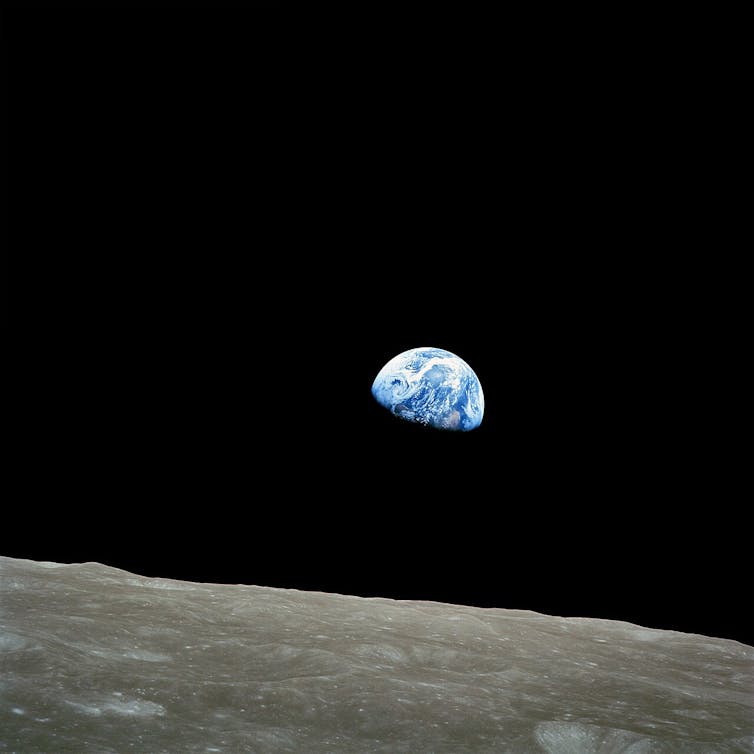
Learning how to support human health and physiology in space also has numerous benefits for life on Earth . For example, products that shield astronauts from space radiation and counter its harmful effects on our body can also treat cancer patients receiving radiation treatments.
Understanding how to protect our bones and muscles in microgravity could improve how doctors treat the frailty that often accompanies aging. And space exploration has led to many technological achievements advancing water purification and satellite systems .
Researchers like me who study ways to preserve astronaut health expect our work will benefit people both in space and here at home.
- Magnetosphere
- Cardiovascular health
- European Space Agency (ESA)
- Nervous system
- Artemis program
- International Space Station
- blood-brain barrier

Research Fellow Community & Consumer Engaged Health Professions Education

Professor of Indigenous Cultural and Creative Industries (Identified)

Communications Director

University Relations Manager

2024 Vice-Chancellor's Research Fellowships
Thank you for visiting nature.com. You are using a browser version with limited support for CSS. To obtain the best experience, we recommend you use a more up to date browser (or turn off compatibility mode in Internet Explorer). In the meantime, to ensure continued support, we are displaying the site without styles and JavaScript.
- View all journals
- My Account Login
- Explore content
- About the journal
- Publish with us
- Sign up for alerts
- Review Article
- Open access
- Published: 05 November 2020
Red risks for a journey to the red planet: The highest priority human health risks for a mission to Mars
- Zarana S. Patel ORCID: orcid.org/0000-0003-0996-6381 1 , 2 ,
- Tyson J. Brunstetter 3 ,
- William J. Tarver 2 ,
- Alexandra M. Whitmire 2 ,
- Sara R. Zwart 2 , 4 ,
- Scott M. Smith 2 &
- Janice L. Huff ORCID: orcid.org/0000-0003-4236-7698 5
npj Microgravity volume 6 , Article number: 33 ( 2020 ) Cite this article
97k Accesses
165 Citations
371 Altmetric
Metrics details
- Cardiovascular diseases
- Eye diseases
- Neurological disorders
- Psychiatric disorders
NASA’s plans for space exploration include a return to the Moon to stay—boots back on the lunar surface with an orbital outpost. This station will be a launch point for voyages to destinations further away in our solar system, including journeys to the red planet Mars. To ensure success of these missions, health and performance risks associated with the unique hazards of spaceflight must be adequately controlled. These hazards—space radiation, altered gravity fields, isolation and confinement, closed environments, and distance from Earth—are linked with over 30 human health risks as documented by NASA’s Human Research Program. The programmatic goal is to develop the tools and technologies to adequately mitigate, control, or accept these risks. The risks ranked as “red” have the highest priority based on both the likelihood of occurrence and the severity of their impact on human health, performance in mission, and long-term quality of life. These include: (1) space radiation health effects of cancer, cardiovascular disease, and cognitive decrements (2) Spaceflight-Associated Neuro-ocular Syndrome (3) behavioral health and performance decrements, and (4) inadequate food and nutrition. Evaluation of the hazards and risks in terms of the space exposome—the total sum of spaceflight and lifetime exposures and how they relate to genetics and determine the whole-body outcome—will provide a comprehensive picture of risk profiles for individual astronauts. In this review, we provide a primer on these “red” risks for the research community. The aim is to inform the development of studies and projects with high potential for generating both new knowledge and technologies to assist with mitigating multisystem risks to crew health during exploratory missions.
Similar content being viewed by others

Selected discoveries from human research in space that are relevant to human health on Earth
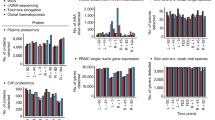
Molecular and physiological changes in the SpaceX Inspiration4 civilian crew
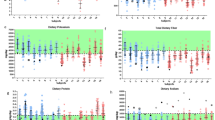
Impact of diet on human nutrition, immune response, gut microbiome, and cognition in an isolated and confined mission environment
Introduction.
Spaceflight is a dangerous and demanding endeavor with unique hazards and technical challenges. Ensuring the overall safety of the crew—their physical and mental health and well-being—are vital for mission success. These are large challenges that are further amplified as exploration campaigns extend to greater distances into our solar system and for longer durations. The major health hazards of spaceflight include higher levels of damaging radiation, altered gravity fields, long periods of isolation and confinement, a closed and potentially hostile living environment, and the stress associated with being a long distance from mother Earth. Each of these threats is associated with its own set of physiological and performance risks to the crew (Fig. 1a ) that must be adequately characterized and sufficiently mitigated. Crews do not experience these stressors independently, so it is important to also consider their combined impact on human physiology and performance. This “space exposome” is a unifying framework that reflects the interaction of all the environmental impacts on the human body (Fig. 1b ) and, when combined with individual genetics, will shape the outcomes of space travel on the human system 1 , 2 .
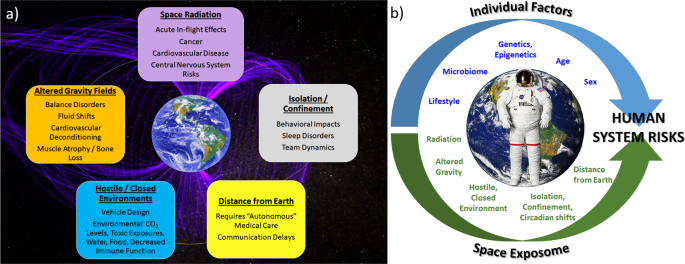
a The key threats to human health and performance associated with spaceflight are radiation, altered gravity fields, hostile and closed environments, distance from Earth, and isolation and confinement. From these five hazards stem the health and performance risks studied by NASA’s Human Research Program. b The space exposome considers the summation of an individual’s environmental exposures and their interaction with individual factors such as age, sex, genomics, etc. - these interactions are ultimately responsible for risks to the human system. Images used in this figure are courtesy of NASA.
The NASA Human Research Program (HRP) aims to develop and provide the knowledge base, technologies, and countermeasure strategies that will permit safe and successful human spaceflight. With agency resources and planning directed toward extended missions both within low Earth orbit (LEO) and outside LEO (including cis-lunar space, lunar surface operations, a lunar outpost, and exploration of Mars) 3 , HRP research and development efforts are focused on mitigation of over 30 categories of health risks relevant to these missions. The HRP’s current research strategy, portfolio, and evidence base are described in the HRP Integrated Research Plan (IRP) and are available online in the Human Research Roadmap, a managed tool used to convey these plans ( https://humanresearchroadmap.nasa.gov/ ). To determine research priorities, NASA uses an evidence-based risk approach to assess the likelihood and consequence (LxC), which gauges the level of each risk for a set of standard design reference missions (Fig. 2 ) 4 . Risks are assigned a rating for their potential to impact in-mission crew health and performance and for their potential to impact long-term health outcomes and quality of life. “Red” risks are those that are considered the highest priority due to their greatest likelihood of occurrence and their association with the most significant risks to crew health and performance for a given design reference mission (DRM). Risks rated “yellow” are considered medium level risks and are either accepted due to a very low probability of occurrence, require in-mission monitoring to be accepted, or require refinement of standards or mitigation strategies in order to be accepted. Risks rated “green” are considered sufficiently controlled either due to lower likelihood and consequence or because the current knowledge base provides sufficient mitigation strategies to control the risk to an acceptable level for that DRM. Milestones and planned program deliverables intended to move a risk rating to an acceptable, controlled level are detailed in a format known as the path to risk reduction (PRR) and are developed for each of the identified risks. The most recent IRP and PRR documents are useful resources for investigators during the development of relevant research approaches and proposals intended for submission to NASA HRP research announcements ( https://humanresearchroadmap.nasa.gov/Documents/IRP_Rev-Current.pdf ).
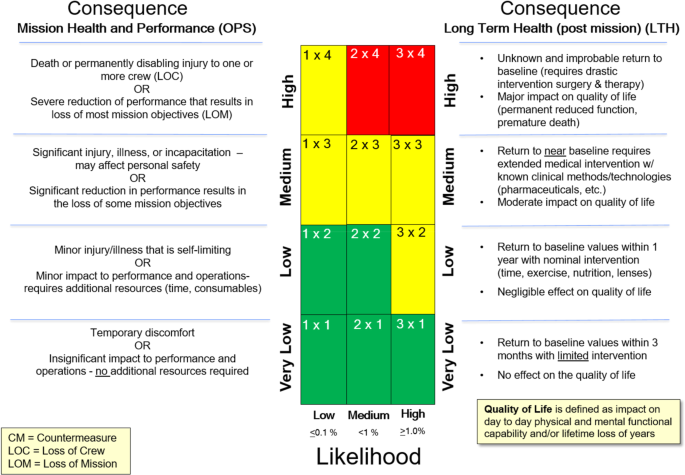
NASA uses an evidence-based approach to assess likelihood and consequence for each documented human system risk. The matrix used for classifying and prioritizing human system risks has two sets of consequences—the left side shows consequences for in-mission risks while the right side is used to evaluate long-term health consequences (Romero and Francisco) 4 .
This work reviews HRP-defined high priority “red” risks for crew health on exploration missions: (1) space radiation health effects that include cancer, cardiovascular disease, and cognitive decrements (2) Spaceflight-Associated Neuro-ocular Syndrome (3) behavioral health and performance decrements, and (4) inadequate food and nutrition. The approaches used to address these risks are described with the aim of informing potential NASA proposers on the challenges and high priority risks to crew health and performance present in the spaceflight environment. This should serve as a primer to help individual proposers develop projects with high potential for generating both new knowledge and technology to assist with mitigating risks to crew health during exploratory missions.
Space radiation health risks
Outside of the Earth’s protective magnetosphere, crews are exposed to pervasive, low dose-rate galactic cosmic rays (GCR) and to intermittent solar particle events (SPEs) 5 . Exposures from GCR are from high charge (Z) and energy (HZE) ions, high-energy protons, and secondary protons, neutrons, and fragments produced by interactions with spacecraft shielding and human tissues. The main components of an SPE are low-to-medium energy protons. In LEO, the exposures are from GCR modulated by the Earth’s magnetic field and from trapped protons in the South Atlantic Anomaly. The absorbed doses for crews on the International Space Station (ISS) on 6- to 12-month missions range from ~30 to 120 mGy. Outside of LEO, without the protection offered by the Earth’s magnetosphere, absorbed radiation doses will be significantly higher. Estimates for a 1 year stay on the lunar surface range from 100 to 120 mGy, and 300 to 450 mGy for an ~3-year Mars mission (transit and surface stay) 6 . The exact dose a crewmember will receive is highly dependent on exact parameters of a given mission, such as detailed vehicle and habitat designs, and mission location and duration 7 . Time in the solar cycle is also a large factor contributing to crew exposure, with highest GCR exposure occurring during periods of minimum solar activity. The lowest GCR exposures occur during periods of maximum solar activity when the heightened magnetic activity of the Sun diverts some cosmic rays; however, during maximum solar activity, the probability of an SPE is higher 8 , 9 . SPEs, which vary in the magnitude and frequency, will obviously also contribute to total mission doses so it is important to note that total mission exposures are only estimates. Further information on the space radiation environment that astronauts will experience is discussed in Simonsen et al. 5 and Durante and Cucinotta 10 .
An important consideration for risk assessment is that the types of radiation encountered in space are very different from the types of radiation exposure we are familiar with here on Earth. HZE ions, although a small fraction of the overall GCR spectrum compared to protons, are more biologically damaging. They differ from terrestrial forms of radiation, such as X-rays and gamma-rays, in both the amount (dose) of exposure as well as in the patterns of DNA double-strand breaks and oxidative damage that they impart as they traverse through tissue and cells (Fig. 3 ) 5 . The highly energetic HZE particles produce complex DNA lesions with clustered double-stranded and single-stranded DNA breaks that are difficult to repair. This damage leads to distinct cellular behavior and intracellular signaling patterns that may be associated with altered disease outcomes compared to those for terrestrial sources of radiation 11 , 12 , 13 . As an example, persistently high levels of oxidative damage are observed in the intestine from mice examined 1 year after exposure to 56 Fe-ion radiation compared to gamma radiation and unirradiated controls 14 , 15 . The higher levels of residual oxidative damage in HZE ion-irradiated tissue is significant because of the association of oxidative stress and damage with the etiology of many human diseases, including cancer, cardiovascular and late neurodegenerative disorders. These types of alterations are believed to contribute to the higher biological effectiveness of HZE particles 10 , 11 .
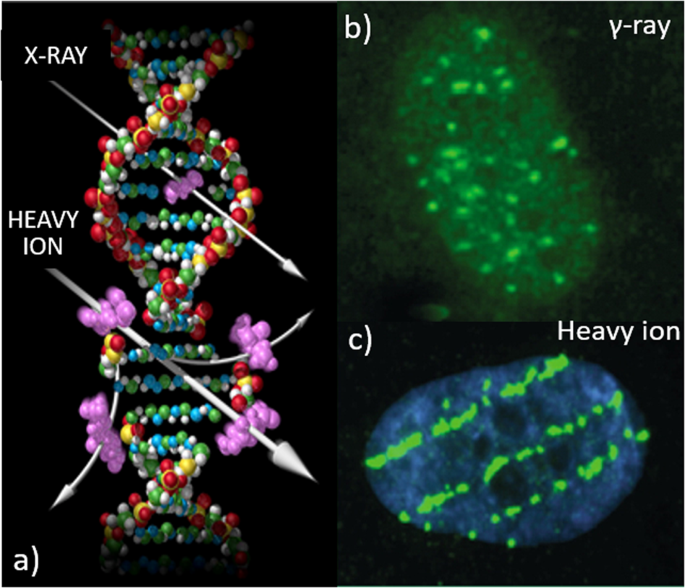
a HZE ions produce dense ionization along the particle track as they traverse a tissue and impart distinct patterns of DNA damage compared to terrestrial radiation such as X-rays. γH2AX foci (green) illuminate distinct patterns of DNA double-strand breaks in nuclei of human fibroblast cells after exposure to b gamma-rays, with diffuse damage, and c HZE ions with single tracks. Image credits: NASA ( a ) and Cucinotta and Durante 97 ( b and c ).
Within the HRP, the Space Radiation Element (SRE) has developed a research strategy involving both vertical translation and horizontal integration, as well as products focused on mitigating space radiation risks across all phases of a mission. Vertical translation involves the integration of benchtop research with preclinical studies and clinical data. Horizontal integration involves a multidisciplinary approach that includes a range of expertize from physicians to clinicians, epidemiologists to computational modelers 16 . The suite of tools includes computational models of the space radiation environment, mission design tools, models for risk projection, and tools and technologies for accurate simulation of the space radiation environment for radiobiology investigations. Ongoing research is focused on radiation quality, age, sex, and healthy worker effects, medical countermeasures to reduce or eliminate space radiation health risks, understanding the complex nature of individual sensitivity, identification and validation of biomarkers (translational, surrogate, predictive, etc.) and integration of personalized risk assessment and mitigation approaches. Owing to the lack of human data for heavy ion exposure on Earth and the complications of obtaining reliable data for space radiation health effects from flight studies, SRE conducts research at the NASA Space Radiation Laboratory (NSRL) at Brookhaven National Laboratory. The NSRL is a ground-based analog for space radiation, where a beamline and associated experimental facilities are dedicated to the radiobiology and physics of a range of ions from proton and helium ions to the typical GCR ions such as carbon, silicon, titanium, oxygen, and iron 5 , 17 , 18 .
Radiation carcinogenesis
Central evidence for association between radiation exposure and the development of cancer and other non-cancer health effects comes from epidemiological studies of humans exposed to radiation 19 , 20 , 21 , 22 . Scaling factors are used by NASA and other space agencies in the analysis of cancer (and other risks) to account for differences between terrestrial radiation exposures and cosmic radiation exposures 23 . The risk of radiation carcinogenesis is considered a “red” risk for exploration-class missions due to both the high likelihood of occurrence, as well as the high potential for detrimental impact on both quality of life and disease-free survival post flight. The major cancers of concern are epithelial in origin (particularly cancers of the lung, breast, stomach, colon, and bladder), as well as leukemias ( https://humanresearchroadmap.nasa.gov/Evidence/reports/Cancer.pdf ). Owing to the lack of human epidemiology directly relevant to the types of radiation found in space, current research utilizes a translational approach that incorporates rodent and advanced human cell-based model systems exposed to space radiation simulants along with comparison of molecular pathways across these systems to the human.
A key question that impacts risk assessment and mitigation is how HZE tumors compare to either radiogenic tumors induced by ground-based radiation or spontaneous tumors. As a unifying concept, NASA studies have sought to examine how space radiation exposure modifies the key genetic and epigenetic modifications noted as the hallmarks of cancer (Fig. 4 ) 24 , 25 , 26 , 27 . This approach provides data for development of translational scaling factors (relative biological effectiveness values, quality factors, dose-rate effectiveness factor) to relate the biological effects of space radiation to effects from similar exposures to ground-based gamma- and X-rays and extrapolation of results to large human epidemiology cohorts. It also supports acquisition of mechanistic information required for successful identification and implementation of medical countermeasure strategies to lower this risk to an acceptable posture for space exploration, and it is relevant for the future development of biologically based dose-response models and integrated systems biology approaches 25 . Cancer is a long-term health risk and although it is rated as “red”, most research in this area is currently delayed, as HRP research priorities focus on in-mission risks.
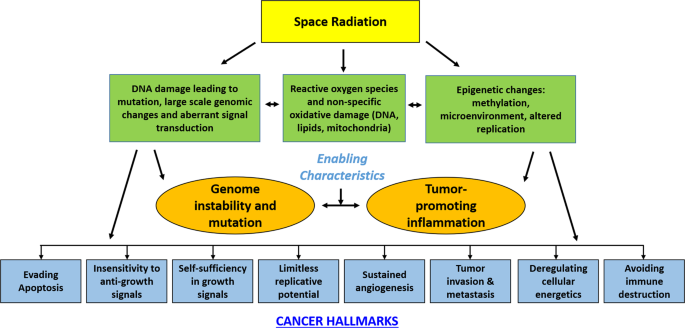
Shown are the enabling characteristics and possible mechanisms of radiation damage that lead to these changes observed in all human tumors. (Adapted from Hanahanand Weinberg) 24 .
Risk of cardiovascular disease and other degenerative tissue effects from radiation exposure and secondary spaceflight stressors
A large number of degenerative tissue (non-cancer) adverse health outcomes are associated with terrestrial radiation exposure, including cardiovascular and cerebrovascular diseases, cataracts, digestive and endocrine disorders, immune system decrements, and respiratory dysfunction ( https://humanresearchroadmap.nasa.gov/Evidence/other/Degen.pdf ). For cardiovascular disease (CVD), a majority of the evidence comes from radiotherapy cohorts receiving high-dose mediastinal exposures that are associated with an increased risk for heart attack and stroke 28 . Recent evidence shows risk at lower doses (<0.5 Gy), with an estimated latency of 10 years or more 29 , 30 , 31 . For a Mars mission, preliminary estimates suggest that circulatory disease risk may increase the risk of exposure induced death by ~40% compared to cancer alone 32 . NASA is also concerned about in-flight risks to the cardiovascular system ( https://humanresearchroadmap.nasa.gov/Evidence/other/Arrhythmia.pdf ), when considering the combined effects of radiation exposure and other spaceflight hazards (Fig. 5 ) 33 . The Space Radiation Element is focused on accumulating data specific to the space radiation environment to characterize and quantify the magnitude of the degenerative disease risks. The current efforts are on establishing dose thresholds, understanding the impact of dose-rate and radiation quality effects, uncovering mechanisms and pathways of radiation-associated cardiovascular and cerebrovascular diseases, and subsequent risk modeling for astronauts. Uncovering the mechanistic underpinnings governing disease processes supports the development of specific diagnostic and therapeutic approaches, is a necessary step in the translation of insights from animal models to humans, and is the basis of personalized medicine approaches.

In blue are the known risk factors for CVD and in black are the other spaceflight stressors that may also contribute to disease development. Image used in this figure is courtesy of NASA.
This information will provide a means to reduce the uncertainty in current permissible exposure limits (PELs), quantify the impact to disease-free survival years, and determine if additional protection or mitigation strategies are required. The research portfolio includes evaluation of current clinical standard-of-care biomarkers for their relevance as surrogate endpoints for radiation-induced disease outcomes. Studies are also addressing the possible role of chronic inflammation and increased oxidative stress in the etiology of radiation-induced CVD, as well as identification of key events in disease pathways, like endothelial dysfunction, that will guide the most effective medical countermeasures. Products include validated space radiation PELs, models to quantify the risk of CVD for the astronaut cohort, and countermeasures and evidence to inform development of appropriate recommendations to clinical guidelines for diagnosis and mitigation of this risk.
Elucidating the role that radiation plays in degenerative disease risks is problematic because multiple factors, including lifestyle and genetic influences, are believed to play a major role in the etiology of these diseases. This confounds epidemiological analyses, making it difficult to detect significant differences from background disease without a large study population 34 . This issue is especially significant in astronaut cohorts because those studies have small sample sizes 35 . There is also a general lack of experimental data that specifically addresses the role of radiation at low, space-relevant doses 36 . Selection of experimental models needs to be carefully considered and planned to ensure that the cardiovascular disease mechanisms and study endpoints are clinically relevant and translatable to humans 37 , 38 . Combined approaches using data from wildtype and genetically modified animal models with accelerated disease development will likely be necessary to elucidate mechanisms and generate the body of knowledge required for development of accurate permissible exposure limits, risk assessment models, and to develop effective mitigation approaches.
Risk of acute (in-flight) and late CNS effects from space radiation exposure
The possibility of acute (in-flight) and late risks to the central nervous system (CNS) from GCR and SPEs are concerns for human exploration of space ( https://humanresearchroadmap.nasa.gov/Evidence/reports/CNS.pdf ). Acute CNS risks may include altered neurocognitive function, impaired motor function, and neurobehavioral changes, all of which may affect human health and performance during a mission. Late CNS risks may include neurological disorders such as Alzheimer’s disease, dementia, or accelerated aging. Detrimental CNS changes from radiation exposure are observed in humans treated with high doses of gamma-rays or proton beams and are supported by a large body of experimental evidence showing neurocognitive and behavioral effects in animal models exposed to lower doses of HZE ions. Rodent studies conducted with HZE ions at low, mission-relevant doses and time frames show a variety of structural and functional alterations to neurons and neural circuits with associated performance deficits 39 , 40 , 41 , 42 , 43 , 44 . Fig. 6 shows an example of changes in dendritic spine density following HZE ion radiation. However, the significance and relationship of these results to adverse outcomes in astronauts is unclear, as similar decrements are not seen with comparable doses of terrestrial radiation. Therefore, scaling to human epidemiology data, as is done for cancer and cardiovascular disease, is not possible. It is also important to note that to date, no radiation-associated clinically significant operational or long-term deficits have been identified in astronauts receiving similar doses via long-duration ISS missions. It is clear that further development of standardized translational models, research paradigms, and appropriate scaling approaches are required to determine significance in humans 45 , 46 . In addition, elucidation of how space radiation interacts with other mission hazards to impact neurocognitive and behavioral health and performance is critical to defining appropriate PELs and countermeasure strategies. The current research approach is a combined effort of SRE, the human factors and behavioral performance element, and the human health countermeasures element in support of an integrated CBS (CNS/behavioral medicine/sensorimotor) plan ( https://humanresearchroadmap.nasa.gov/Risks/risk.aspx?i=99 ). Further information on this risk area is presented below in the Behavioral Health and Performance section and can also be found at the Human Research Roadmap.
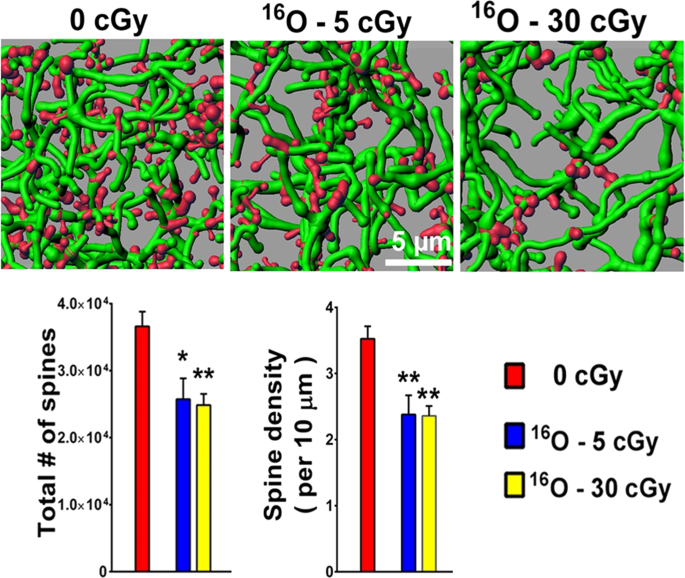
Representative digital images of 3D reconstructed dendritic segments (green) containing spines (red) in unirradiated (0 cGy) and irradiated (5 and 30 cGy) mice brains. Multiple comparisons show that total spine numbers (left bar chart) and spine density (right bar chart) are significantly reduced after exposure to 5 or 30 cGy of 16 O particles. Data are expressed as mean ± SEM. * P < 0.05, ** P < 0.01 versus control; ANOVA. Adapted from Parihar et al. 39 . Permission to reproduce open-source figure per the Creative Commons Attribution 4.0 International License. https://creativecommons.org/licenses/by/4.0 .
To summarize, the health risks posed by the omnipresent exposure to space radiation are significant and include the “red” risks of cancer, cardiovascular diseases, and cognitive and behavioral decrements. While research on the late health risk of cancer is currently delayed, research on the in-flight effects of radiation on the cardiovascular system and CNS within the context of the space exposome are considered the highest priority and are the focus of investigations. Major knowledge gaps include the effects of radiation quality, dose-rate, and translation from animal models to human systems and evaluation of the requirement for medical countermeasure approaches to reduce the risk.
Spaceflight-Associated Neuro-ocular Syndrome
The Risk of Spaceflight-Associated Neuro-ocular Syndrome (SANS), originally termed the Risk of Vision Impairment Intracranial Pressure (VIIP), was first discovered about 15 years ago. VIIP was the original name used because the syndrome most noticeably affects a crewmember’s eyes and vision, and its signs can appear like those of the terrestrial condition idiopathic intracranial hypertension (IIH; which is due to increased intracranial pressure). Over time, it was realized that the VIIP name required an update. Most notably, SANS is not associated with the classic symptoms of increased intracranial pressure in IIH (e.g., severe headaches, transient vision obscurations, double vision, pulsatile tinnitus), and it has never induced vision changes that meet the definition of vision impairment, as defined by the National Eye Institute. In 2017, VIIP was renamed to SANS, a term that welcomes additional pathogenesis theories and serves as a reminder that this syndrome could affect the CNS well beyond the retina and optic nerve.
SANS presents with an array of signs, as documented in the HRP Evidence Report ( https://humanresearchroadmap.nasa.gov/evidence/reports/SANS.pdf ). Primarily, these include edema (swelling) of the optic disc and retinal nerve fiber layer (RNFL), chorioretinal folds (wrinkles in the retina), globe flattening, and refractive error shifts 47 . Flight duration is thought to play a role in the pathogenesis of SANS, as nearly all cases have been diagnosed during or immediately after long-duration spaceflight (i.e., missions of 30 days duration or longer), although signs have been discovered as early as mission day 10 48 . Because of SANS, ocular data are nominally collected during ISS missions. For most ISS crewmembers, this testing includes optical coherence tomography (OCT), retinal imaging, visual acuity, a vision symptom questionnaire, Amsler grid, and ocular ultrasound (Fig. 7 ).
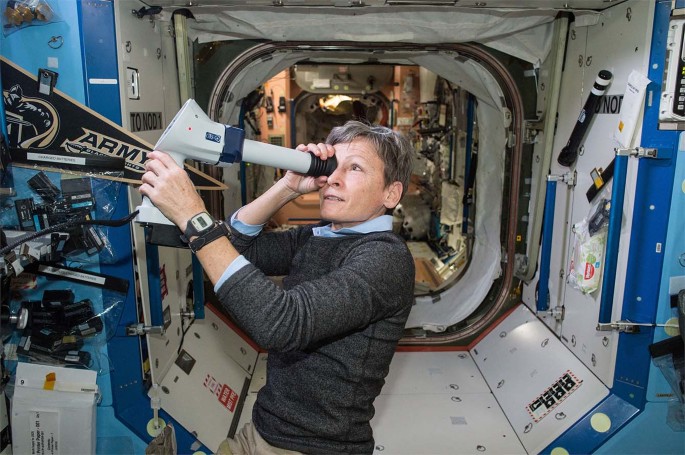
Image courtesy of NASA.
From a short-term perspective (e.g., a 6-month ISS deployment), SANS presents four main risks to crewmembers and their mission: optic disc edema (ODE), chorioretinal folds, shifts in refractive error, and globe flattening 49 . Approximately 69% of the US crewmembers on the ISS experience a > 20 µm increase in peripapillary retinal thickness in at least one eye, indicating the presence of ODE. With significant levels of ODE, a crewmember can experience an enlargement of his/her blind spots and a corresponding loss in visual function. To date, blind spots are uncommon and have not had an impact on mission performance.
If chorioretinal folds are severe enough and located near the fovea (the retina associated with central vision), a crewmember may experience visual distortions or reduced visual acuity that cannot be corrected with glasses or contact lenses, as noted in the SANS Evidence Report. Despite a prevalence of 15–20% in long-duration crewmembers, chorioretinal folds have not yet impacted astronauts’ visual performance during or after a mission. An on-orbit shift in refractive error is due to a shortening of the eye’s axial length (distance between the cornea and the fovea), and it occurs in about 16% of crewmembers during long-duration spaceflight. This risk is mitigated by providing deploying crewmembers with several pairs of “Space Anticipation Glasses” (or contact lenses) of varying power. On-orbit, the crewmember can then select the appropriate lenses to restore best-corrected visual acuity. Approximately 29% of long-duration crewmembers experience a posterior eyeball flattening, which is typically centered around the insertion of the optic nerve into the globe. Globe flattening can induce chorioretinal folds and shifts in refractive error, posing the respective risks described above.
From a longer-term perspective, SANS presents two main risks to crewmembers: ODE and chorioretinal folds. It is unknown if a multi-year spaceflight (e.g., a Mars mission) will be associated with a higher prevalence, duration, and/or severity of ODE compared to what has been experienced onboard the ISS. Since the retina and optic nerve are part of the CNS, if ODE is severe enough, the crewmember risks a permanent loss of optic nerve and RNFL tissue and thus, a permanent loss of visual function. It should be stressed that no SANS-related permanent loss of visual function has yet been discovered in any astronauts.
For choroidal folds, improvement generally occurs post-flight in affected crewmembers; however, significant folds can persist for 10 or more years after long-duration missions. Using MultiColor Imaging and autofluorescence capabilities of the latest OCT device, it was discovered recently that one crewmember’s longstanding (>5 years) post-flight choroidal folds have induced disruption to its overlying retinal pigment epithelium (RPE) 50 . The RPE is a monolayer of pigmented cells located between the vascular-rich choroid and the photoreceptor outer segments. This layer forms the posterior blood-brain barrier for the retina and is essential for maintaining the health of the posterior retina via the transport of nutrients and fluids, among other key functions. If the RPE is damaged, it could potentially lead to a degeneration of the local retina and progress to vision impairment.
Recent long-duration head-down tilt studies have shown potential for recreating SANS signs in terrestrial cohorts 51 . However, SANS is considered a pathology unique to spaceflight. In microgravity, fluid within the body is free to redistribute uniformly. This means that much of the fluid that normally pools in a person’s feet and legs due to gravity can transfer upward towards the head and cause a general congestion of the cerebral venous system. The central pathogenesis theories of SANS are based on these facts, but the actual cause(s) and pathophysiology of SANS are yet unknown 49 . The most publicized theory for SANS has been that cerebral spinal fluid outflow might be impeded, causing an overall increase in intracranial pressure (ICP) 47 , 52 . Other potential mechanisms (see Fig. 8 ) include cerebral venous congestion or altered folate-dependent 1-carbon metabolism via a cascade of mechanisms that may ultimately increase ICP or affect the response of the eye to fluid shifts 53 , 54 . Potential confounding variables for SANS pathogenesis include resistive exercise, high-sodium dietary intake, and high carbon dioxide levels.
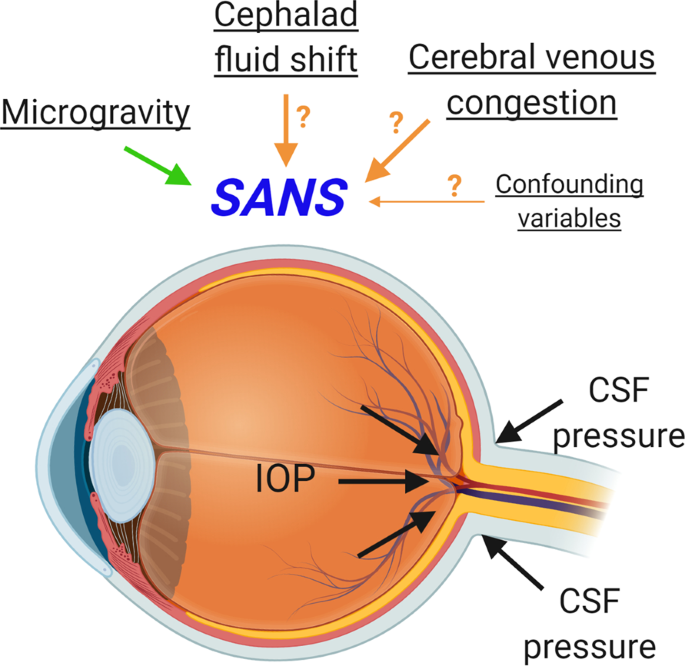
Image created with BioRender.com.
Discovering patterns and trends in the SANS population has been difficult due to the relatively low number of crewmembers who have completed long-duration spaceflight. This is especially true for female astronauts. However, there is now enough evidence to state—emphatically—that SANS is not a male-only syndrome. OCT has been utilized onboard the ISS since late 2013, and it has revolutionized NASA’s ability to objectively detect and monitor SANS and build a high-resolution database of retinal and optic nerve head images. Through this technology, it has been recently discovered that that a majority of long-duration astronauts (including females) present with some level of ODE and engorgement of the choroidal vasculature 48 , 55 . The trends and patterns of these ocular anatomical changes may hold the key to deciphering the pathophysiology of SANS 48 , 55 .
Beginning in 2009 in response to SANS, all NASA crewmembers receive pre- and post-flight 3 Tesla magnetic resonance imaging of the brain and orbits. Based on these images, there is growing evidence that brain structural changes also occur during long-duration spaceflight. Most notably, a 10.7–14.6% ventricular enlargement (i.e., approximately a 2–3 ml increase) has been detected in astronauts and cosmonauts by multiple investigators 56 , 57 , 58 , 59 . On-orbit and post-flight cognitive testing have not revealed any systemic cognitive decrements associated with these anatomical changes. Moreover, additional research is required to determine if spaceflight-associated brain structural changes are related to ocular structural changes (i.e., SANS) or if the two are initiated by a common cause. Thus, until a relationship is established, SANS will be defined by ocular signs.
Future SANS medical operations, research, and surveillance will focus on: 1) determining the pathogenesis of the syndrome, 2) developing small-footprint diagnostic devices for expeditionary spaceflight, 3) establishing effective countermeasures, 4) monitoring for any long-term health consequences, and 5) discovering what factors make certain individuals more susceptible to developing the syndrome.
In summary, SANS is a top risk and priority to NASA and HRP. The primary SANS-related risk is ODE, due to the possibility of permanent vision impairment; however, choroidal folds also present a short- and long-term risk to astronaut vision. Shifts in refractive error are relatively common in long-duration missions, but crewmembers do not experience a loss of visual acuity if adequate correction is available. SANS affects female astronauts, not just males, although it is not yet known if SANS prevalence is equal between the sexes. There are no terrestrial pathologies identical to SANS, including IIH. Long-duration spaceflight is also associated with brain anatomical changes; however, it is not yet known whether these changes are related to SANS. Finally, the pathogenesis of SANS remains elusive; however, the main theories are related to increased intracranial pressure, ocular venous congestion, and individual anatomical/genetic variability.
Behavioral health and performance
The Risk of Adverse Cognitive and Behavioral Conditions and Psychiatric Disorders (BMed) focuses on characterizing and mitigating potential decrements in performance and psychological health resulting from multiple spaceflight hazards, including isolation and distance from earth. Spaceflight radiation is also recognized as contributing factor, particularly relative to a deep space planetary mission. The potential of additive or synergistic effects on the CNS resulting from simultaneous exposures to radiation, isolation and confinement, and prolonged weightlessness, is also of emerging concern ( https://humanresearchroadmap.nasa.gov/Risks/risk.aspx?i=99 ).
The official risk statement in the BMed Evidence Report notes, “ given the extended duration of future missions and the isolated, confined and extreme environments, there is a possibility that (a) adverse cognitive or behavioral conditions will occur affecting crew health and performance; and (b) mental disorders could develop should adverse behavioral conditions be undetected and unmitigated ” ( https://humanresearchroadmap.nasa.gov/Evidence/reports/BMED.pdf ). Primary outcomes for this risk include decrements in cognitive function, operational performance, and psychological and behavioral states, with the development of psychiatric disorders representing the least likely but one of the most consequential outcomes crew could experience in extended spaceflight. BMed is considered a “red” risk for planetary missions, given the long-duration of isolation, extended confinement, and exposure to additional stressors, including increased radiation exposure. The Human Factors and Behavioral Performance Element within HRP utilizes a research strategy that incorporates flight studies on astronauts, research in astronaut-like individuals and teams in ground analogs, and works with the Space Radiation Element to use animal models supporting research on combined spaceflight stressors.
While astronauts successfully accomplish their mission objectives and report very positive experiences living and working in space, some anecdotal accounts from current and past astronauts suggest that psychological adaptation in the long-duration spaceflight environment can be challenging. However, clinically significant operational decrements have not been documented to date, as noted in the BMed Evidence Report. Discrete events that have been documented include accounts of adverse responses to workload by Shuttle payload specialists, and descriptions of ‘hostile’ and ‘irritable’ crew in the 84-day Skylab 4 mission, as well as symptoms of depression reported on Mir by 2 of the 7 NASA astronauts.
Currently, potential stressors affiliated with missions to the ISS include extended periods of high workload and/or schedule shifting, physiological adaptation including fluid shifts caused by weightlessness and possibly, exposure to other environmental factors such as elevated carbon dioxide (see the BMed Evidence Report). While still physically isolated from home, the presence of the ISS in LEO facilitates a robust ground behavioral health and performance support team who offer services such as bi-weekly private psychological conferences and regular delivery of novel goods and surprises from home in crew care packages. Coupled with the relatively ample volume in the ISS, near-constant real-time communication with Earth, new crewmembers rotating periodically throughout missions, and relatively low levels of radiation exposure, —it is expected that behavioral challenges experienced today do not represent those that future crews will face during exploration missions.
Nevertheless, the few completed behavioral studies on the ISS suggest that subjective perceptions of stress increase over time for some crewmembers, as shown by an in-flight study collecting subjective ratings of well-being and objective measures of fatigue 60 . Notably, it was found that astronaut ratings of sleep quality and sleep duration (also measured through visual analog scales) were found to be inversely related to ratings of stress. Another in-flight investigation seeking to characterize behavioral responses to spaceflight is the “Journals” study by Stuster 61 . This investigation provided a systematic approach to examining a rich set of qualitative data by evaluating astronaut journal entries for temporal patterns of across different behavioral states over the course of a mission (Fig. 9 ). Based on findings, some categories suggest temporal patterns while other categories of outcomes do not suggest a pattern relative to time, which may be due to no temporal relationship between outcomes and time, and/or various contextual factors within missions that negate the presence of such a relationship (e.g., visiting crew). An overall assessment by Stuster of negative comments relative to positive comments over time suggests evidence of a third quarter phenomenon in Adjustment alone, a category which reflects individual morale 61 .
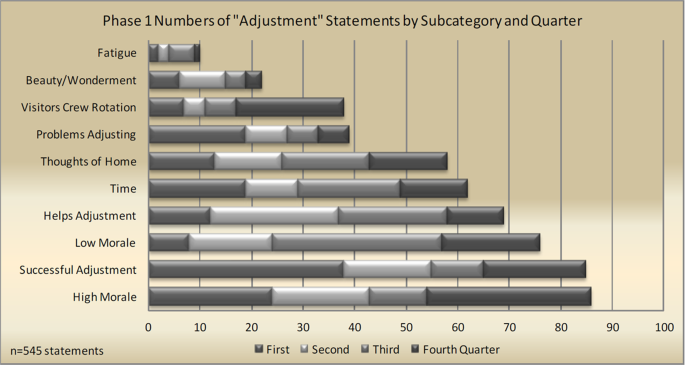
Example bar graph showing distribution of journal entries related to general adjustment to the spaceflight enivronment during each quarter of an ISS mission 61 .
Other in-flight investigations support and expand upon contributors to increased stress on-orbit, including studies documenting reductions in sleep duration 62 , 63 and evaluation of crew responses to habitability and human factors during spaceflight 64 . While no studies have assessed potentially relevant mechanisms for behavioral or other reported symptoms, a recently completed investigation suggests neurostructural changes may be occurring in the spaceflight environment 56 . Magnetic resonance imaging scans were conducted on astronauts pre- and post-flight on both long-duration missions to the ISS or short-duration Shuttle missions. Assessments from a subgroup of participants ( n = 12) showed a slight upward shift of the brain after all long-duration flights but not after short-duration flights ( n = 6), and they also showed narrowing of cerebral spinal fluid spaces at the vertex after all long-duration flights ( n = 6) and in 1 of 6 crew after short-duration flights. A retrospective analysis of free water volume in the frontal, temporal, and occipital lobes before versus after spaceflight suggests alterations in free water distribution 65 . Whether there is a functionally relevant outcome as a result of such changes remains to be determined. Hence, while certain aspects of the spaceflight environment have been shown to increase some behavioral responses (e.g., reduced sleep owing to workload), the direct role of spaceflight-specific factors (such as fluid shifts and weightlessness) on behavioral outcomes or functional performance has not yet been established.
Future long-duration missions will pose threats to behavioral health and performance, such as extreme confinement in a small volume and communication delays, that are distinct from what is currently experienced on missions to the ISS. Analog research is concurrently underway to help further characterize the likelihood and consequence of an adverse behavioral outcome, and the effectiveness of potential countermeasures. Ground analogs, such as the Human Exploration Research Analog (HERA) at NASA Johnson Space Center, provide a test bed where controlled studies of small teams for periods up to 45 days, can be implemented (Fig. 10 ). HERA can be used to provide scenarios and environments analogous to space (e.g., isolation and confinement, communication delays, space food, and daily tasks and schedules) to investigate their effects on behavioral health, human factors, exploration medical capabilities, and communication and autonomy. Research in locations such as Antarctica also offer a unique opportunity to conduct research in less controlled but higher fidelity conditions. In general, these studies show an increased risk in deleterious effects such as decreased mood and increased stress, and in some instances, psychiatric outcomes (see the BMed Evidence Report).
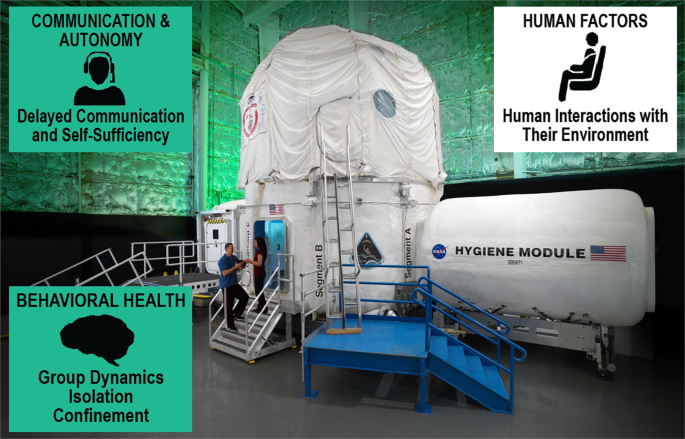
HERA is used to simulate environments and mission scenarios analogous to spaceflight to investigate a variety of behavioral and human factors issues. Images courtesy of NASA.
In 2014, Basner and colleagues 62 completed an assessment of crew health and performance in a 520-day mission at an isolation chamber in Moscow at the Institute for Biomedical Problems (IBMP). During this simulated mission to Mars, the crew of six completed behavioral questionnaires and additional testing weekly. One of six (20%) crew reported depressive symptoms based on the Beck Depression Inventory in 93% of mission weeks, which reached mild-to-moderate levels in >10% of mission weeks. Additional indications of changes in mood were observed via the Profile of Mood States. Additionally, two crewmembers who had the highest ratings of stress and physical exhaustion accounted for 85% of the perceived conflicts, and other crew demonstrated dysregulation in their circadian entrainment and sleep difficulties. Two of the six crewmembers reported no adverse behavioral symptoms during the missions 62 . Building on this work, the NASA HRP and the IBMP have ongoing studies in the SIRIUS project, a series of long-duration ground-analog missions for understanding the effects of isolation and confinement on human health and performance ( http://www.nasa.gov/analogs/nek/about ).
Finally, more recent research in the HERA analog at Johnson Space Center is underway to assess not only individual, psychiatric outcomes but also changes in team dynamics and team performance over time (Fig. 10 ). A recent publication reported that conceptual team performance (e.g., creativity) seems to decrease over time, while performance requiring cognitive function and coordinated action improved 66 . While results from additional team studies in HERA are currently under review, the Teams Risk Evidence Report ( https://humanresearchroadmap.nasa.gov/Evidence/reports/Team.pdf ) provides a thorough overview of the evidence surrounding team level outcomes.
In summary, evidence from spaceflight and spaceflight analogs suggests that the BMed Risk poses a high likelihood and high consequence risk for exploration. Given the possible synergistic effects of prolonged isolation and confinement, radiation exposure, and prolonged weightlessness, mitigating such enhanced risks faced by future crews are of highest priority to the NASA HRP.
Inadequate food and nutrition
Historically, nutrition has driven the success—and often the failure—of terrestrial exploration missions. For space explorers, nutrition provides indispensable sustenance, provides potential countermeasures to some of the negative effects of space travel on human physiology, and also presents a multifaceted risk to the health and safety of astronauts ( https://humanresearchroadmap.nasa.gov/Evidence/other/Nutrition-20150105.pdf ).
At a minimum, the need to prevent nutrient deficiencies is absolute. This was proven on voyages during the Age of Sail, where scurvy—caused by vitamin C deficiency— killed more sailors than all other causes of death. On a closed (or even semi-closed) food system, the risk of nutrient deficiency is increased. On ISS missions, arriving vehicles typically bring some fresh fruits and/or vegetables to the crew. While limited in volume and shelf-life, these likely provide a valuable source of nutrients and phytochemicals every month or two. One underlying concern is that availability of these foods may be mitigating nutrition issues of the nominal food system, and without this external source of nutrients on exploration-class missions, those issues will be more likely to surface.
As a cross-cutting science, nutrition interfaces with many, if not all, physiological systems, along with many of the elements associated with space exploration, including the spacecraft environment (Fig. 11 ). Thus, beyond the basics of preventing deficiency of specific nutrients, at best, nutrition can serve as a countermeasure to mitigate risks to other systems. Conversely, at worst, diet and nutrition can exacerbate risks to other physiological systems and crew health. For example, many of the diseases of concern as related to space exploration are nutritionally modifiable on Earth, including cancer, cardiovascular disease, osteoporosis, sarcopenia, and cataracts.
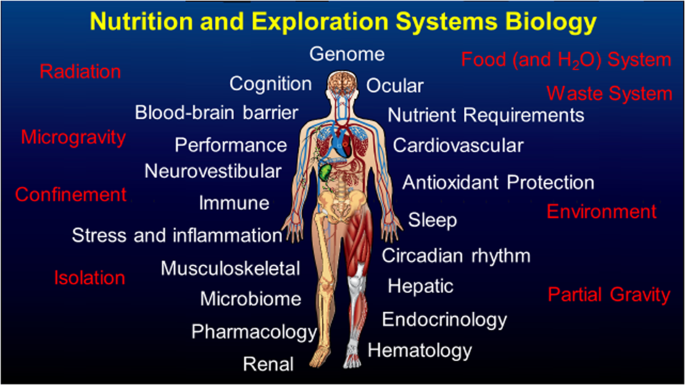
Many of the physiological systems and performance characteristics that are touched by nutrition are shown in white text, while the unique elements of spacecraft and space exploration are shown in red text.
The NASA Nutritional Biochemistry Laboratory approaches astronaut health with both operational and research efforts. These efforts aim to keep current crews healthy while working to understand and define optimal nutrition for future crews, to maximize performance and overall health while minimizing damaging effects of spaceflight exposure.
A Clinical Nutrition Assessment is conducted for ISS astronauts dating back to ISS Expedition 1 67 , 68 , which includes pre- and post-flight biochemical analyses conducted on blood and urine samples, along with in-flight monitoring of dietary intake and body mass. The biochemical assessments include a wide swath of nutritional indicators such as vitamins, minerals, proteins, hematology, bone markers, antioxidant markers, general chemistry, and renal stone risk. These data are reported to the flight surgeon soon after collection for use in the clinical care of the astronaut. Initial findings from the Clinical Nutritional Assessment protocol identified evidence of vitamin D deficiency, altered folate status, loss of body mass, increased kidney stone risk, and more 69 , 70 . These initial findings led to several research efforts (described below), including the Nutritional Status Assessment flight project, and research in the Antarctic on vitamin D supplementation 71 , 72 .
In addition to in-flight dietary intake monitoring, research to understand the impact and involvement of nutrition with other spaceflight risks such as bone loss and visual impairments, and interaction with exercise and spacecraft environment, are performed by the Nutrition Team using both flight and ground-analog research efforts. Tracking body mass is a very basic but nonetheless indispensable element of crew health 73 . Loss of body mass during spaceflight and in ground analogs of spaceflight is associated with exacerbated bone and muscle loss, cardiovascular degradation, increased oxidative stress, and more 70 , 73 , 74 . Historically, it was often assumed that some degree of body mass loss was to be expected, and that this was a typical part of adaptation to microgravity. Fluid loss is often assumed to be a key factor, but research has documented this to be a relatively small contributor, of approximately 1% of weight loss being fluid 74 , 75 . While on average, crewmembers on ISS missions have lost body mass over the course of flight, not all do 74 . Importantly, those that did not lose body mass managed to maintain bone mineral density (discussed below) 76 .
Bone loss has long been a concern for space travelers 77 , 78 , 79 , 80 , 81 . It has been shown that an increase in bone resorption was the likely culprit and that bone formation was largely unchanged in microgravity or ground analogs 77 , 78 , 79 . The search for a means to counteract this bone loss, and this hyper-resorptive state specifically, has been extensive. The potential for nutrition to mitigate this bone loss was identified early but studies of increasing intakes of calcium, or fluoride, or phosphate, were unsuccessful 74 , 77 , 79 , 82 , 83 , 84 .
Exercise provides a multisystem countermeasure, and heavy resistive exercise specifically provides for loading of bone to help mitigate weightlessness-induced bone loss.
In evaluating the data from astronauts using the first “interim” resistive exercise device (iRED) on ISS compared to a later, “advanced” resistive exercise device (ARED) (Fig. 12 ), it was quickly realized that exercise was not the only difference in these two groups of astronauts. ARED crews had better dietary intakes (as evidenced by maintenance of body mass) and better vitamin D status as a result of increased dose of supplementation and awareness of the importance of these supplements starting in 2006 76 . Bone mineral density was protected in these astronauts 76 , proving that diet and exercise are a powerful countermeasure combination. Follow-on evaluations showed similar results and further that the effects of microgravity exposure on bone health in men and women were similar 85 despite differences in pre-flight bone mass.
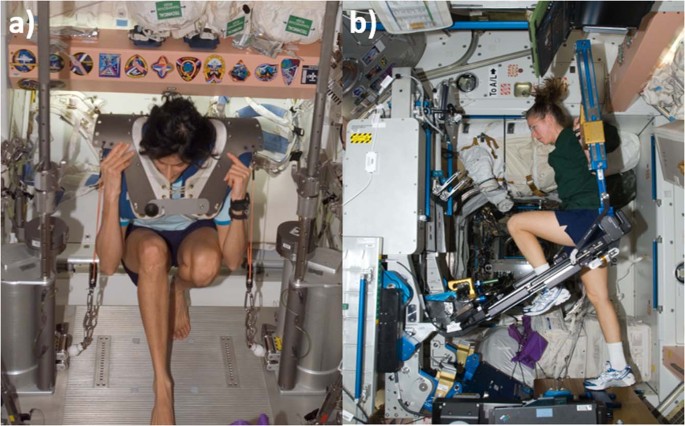
Sunita Williams exercising on the iRED ( a ), and on a later mission, Sandy Magnus exercises on the much improved ARED device ( b ). Images courtesy of NASA.
From a purely nutrition perspective, ISS and associated ground analog research has identified several specific dietary effects on bone health. Fish intake, likely secondary to omega-3 fatty acid intake, is beneficial for bone health 86 . Conversely, high intakes of dietary protein 87 , 88 , iron 89 and sodium 90 are detrimental to bone. The mechanism of the effect of protein and sodium on bone are likely similar, with both contributing to the acidogenic potential of the diet, leading to bone dissolution 91 , 92 . This effect was recently documented in a diet and bone health study on ISS, where the acidogenic potential of the diet correlated with post-flight bone losses 93 . The data from terrestrial research, along with the more limited spaceflight research, clearly identifies nutrition as important in maintenance of bone health and in the mitigation of bone loss. While initial evaluations of dietary quality and health are underway at NASA, much work remains to document the full potential of nutrition to mitigate bone loss and other disease processes in space travelers.
Another health risk with nutrition underpinnings is SANS, which was described earlier. When this issue first arose, an examination of data from the aforementioned ISS Nutrition project was conducted. This analysis revealed that affected crewmembers had significantly higher circulating concentrations of homocysteine and other one-carbon pathway metabolites when compared to non-cases and that these differences existed before flight 53 . Many potential confounding factors were ruled out, including: sex, kidney function, vitamin status, and coffee consumption, among others. After identifying differences in one-carbon biochemistry, the next logical step was to examine the genetics—single-nucleotide polymorphisms (SNPs)—involved in this pathway as possible causes of the biochemical differences, but perhaps also their association with the astronaut ocular pathologies. An initial study examined a small set of SNPs—five to be exact—and when the data were statistically modeled, it was found that B-vitamin status and genetics were significant predictors of many of the observed ophthalmic outcomes in astronauts 94 . Interestingly, the same SNPs identified in astronauts to be associated with ophthalmic changes after flight were associated with greater changes in total retina thickness after a strict head-down tilt with 0.5% CO 2 bed rest study 54 . A follow-on study is underway to evaluate a much broader look at one-carbon pathway and associated SNPs, potentially to help better characterize this relationship.
A hypothesis was developed to plausibly link these genetics and biochemical differences with these ophthalmic outcomes, as there is no existing literature regarding such a relationship. This multi-hit hypothesis posits that one-carbon pathway genetics is an indispensable factor, and that the combination with one or more other factors (e.g., fluid shifts, carbon dioxide, radiation, endocrine effects) lead to these pathologies. This has been detailed in a hypothesis paper 95 and in a recent review 96 . In brief, the hypothesis is that genetics and B-vitamin status contribute to endothelial dysfunction, as folate (and other B-vitamins) play critical roles in nitric oxide synthesis and endothelial function. A disruption in nitric oxide synthesis can also lead to an activation of matrix metalloproteinase activation, increasing the turnover and breakdown of structural elements of the sclera, altering retinal elasticity and increasing susceptibility to fluid shifts to induce ophthalmic pathologies like optic disc edema and choroidal folds 54 . This is likely exacerbated cerebrally due to limitations of transport of B-vitamins across the blood-brain barrier. In or around the orbit, endothelial dysfunction, oxidative stress, and potentially individual anatomical differences contribute to leaky blood vessels, and subsequent edema. This can impinge on cerebrospinal fluid drainage from the head, increasing those fluid pressures, which can impinge upon the optic nerve and eye itself, yielding the aforementioned ophthalmic pathologies. These are hypotheses proposed as starting points for further research. Given the irrefutable biochemical and genetic findings to date, this research should be a high priority to either prove or dismiss these as contributing factors in SANS to mitigate that “red” risk.
Another intriguing element from this research is that there is a clinical population that has many of the same characteristics of affected astronauts (or characteristics that they are purported to have), and that is women with polycystic ovary syndrome (PCOS) 95 , 96 . Women with PCOS have higher circulating homocysteine concentrations (as do their siblings and fathers), and also have cardiovascular pathology, including endothelial dysfunction. Studies are underway between NASA and physicians at the Mayo Clinic in Minnesota to evaluate this further. If validated, women with PCOS might represent an analog population for astronaut ocular issues, and research to counteract this could benefit both populations 87 . This research may lead to the identification of one-carbon pathway genetic influences on cardiovascular function in astronauts (and women with PCOS). This information will not be used in any sort of selection process, for several reasons, but as a means to identify countermeasures. Given the effects are intertwined with vitamin status, and likely represent higher individual vitamin requirements, targeted B-vitamin supplementation is the most obvious, and lowest risk, countermeasure that needs to be tested. There is tremendous potential for nutrition research to solve one of the key risks to human health on space exploration missions.
To summarize, nutrition is a cross-cutting field that has influence on virtually every system in the body. While we need to understand nutrition to avoid frank deficiencies, we need to understand how optimizing nutrition might also help mitigate other spaceflight-induced human health risks. Examples of this are myriad, ranging from effects of dietary intake on cognition, performance, and morale, inadequate intake on cardiovascular performance, excess nutrient intakes, leading to excess storage and increased oxidative stress, nutrient insufficiencies, leading to bone loss, insufficient fruit and vegetable intake on bone health, radiation protection, and cardiovascular health, to name a just few. Throughout history, nutrition has served, or failed, many a journey to explore. We need to dare to use and expand our twenty-first century knowledge of nutrition, uniting medical and scientific teams, to enable future exploration beyond LEO, while simultaneously benefitting humanity.
The NASA Human Research Program is focused on developing the tools and technologies needed to control the high priority “red” risks to an acceptable level—a great challenge as the risks do not exist in the vacuum of space as standalone entities. They are inherently interconnected and represent the intersection points where the five hazards of spaceflight overlap, and nature meets nurture. This is the space exposome: the total sum of spaceflight and lifetime exposures and how they relate to individual genetics and determine the whole-body outcome. The space exposome will be an important unifying concept as the hazards and risks of spaceflight are evaluated in a systems biology framework to fully uncover the emergent effects of the extraterrestrial experience on the human body. This framework will provide a path forward for mitigating detrimental health and performance outcomes that may stand in the way of successful, long-duration space travel, especially as NASA plans for a return to the Moon, to stay, and beyond to Mars.
Wild, C. P. The exposome: from concept to utility. Int. J. Epidemiol. 41 , 24–32 (2012).
Article PubMed Google Scholar
Crucian, B. E. et al. Immune system dysregulation during spaceflight: potential countermeasures for deep space exploration missions. Front. Immunol. 9 , 1–21 (2018).
Article CAS Google Scholar
Cassell, A. M. Forward to the Moon: NASA’s Strategic Plan for Human Exploration (NASA Ames Research Center ARC-E-DAA-TN73512, 2019).
Romero, E. & Francisco, D. The NASA human system risk mitigation process for space exploration. Acta Astronaut. 175 , 606–615 (2020).
Article Google Scholar
Simonsen, L. C., Slaba, T. C., Guida, P. & Rusek, A. NASA’s first ground-based Galactic Cosmic Ray Simulator: enabling a new era in space radiobiology research. PLOS Biol. 18 , e3000669 (2020).
Article CAS PubMed Central PubMed Google Scholar
Norbury, J. W. et al. Galactic cosmic ray simulation at the NASA Space Radiation Laboratory. Life Sci. Space Res. (Amst.) 8 , 38–51 (2016).
NCRP. Report No. 183—Radiation Exposure in Space and the Potential for Central Nervous System Effects: Phase II . (National Council on Radiation Protection, 2019).
Slaba, T., Mertens, C. J. & Blattnig, S. R. Radiation Shielding Optimization on Mars . (NASA/TP–2013-217983, 2013).
Simonsen, L. C. & Nealy, J. E. Radiation Protection for Human Missions to the Moon and Mars . (NASA-TP-3079, 1991).
Durante, M. & Cucinotta, F. A. Heavy ion carcinogenesis and human space exploration. Nat. Rev. Cancer 8 , 465–472 (2008).
Article CAS PubMed Google Scholar
Li, M. et al. Health risks of space exploration: targeted and nontargeted oxidative injury by high-charge and high-energy particles. Antioxid. Redox Signal. 20 , 1501–1523 (2014).
Sridharan, D. M., Chappell, L. J., Whalen, M. K., Cucinotta, F. A. & Pluth, J. M. Defining the biological effectiveness of components of High-LET track structure. Radiat. Res. 184 , 105–119 (2015).
Rose, Li,Y. et al. Mutational signatures in tumours induced by high and low energy radiation in Trp53 deficient mice. Nat. Commun. 11 , 394 (2020).
Datta, K., Suman, S., Kallakury, B. V. S. & Fornace, A. J. Exposure to heavy ion radiation induces persistent oxidative stress in mouse intestine. PLoS ONE 7 , e42224 (2012).
Kumar, S., Suman, S., Fornace, A. J. & Datta, K. Space radiation triggers persistent stress response, increases senescent signaling, and decreases cell migration in mouse intestine. Proc. Natl Acad. Sci. USA 115 , E9832–E9841 (2018).
Article CAS PubMed PubMed Central Google Scholar
National Academies of Sciences, Engineering, and Medicine of Sciences. A Midterm Assessment of Implementation of the Decadal Survey on Life and Physical Sciences Research at NASA . (The National Academies Press, 2018).
La Tessa, C., Sivertz, M., Chiang, I.-H., Lowenstein, D. & Rusek, A. Overview of the NASA space radiation laboratory. Life Sci. Space Res. (Amst.) 11 , 18–23 (2016).
Schimmerling, W. Genesis of the NASA space radiation laboratory. Life Sci. Space Res. (Amst.) 9 , 2–11 (2016).
Ozasa, K., Cullings, H. M., Ohishi, W., Hida, A. & Grant, E. J. Epidemiological studies of atomic bomb radiation at the radiation effects research foundation. Int. J. Radiat. Biol. 95 , 879–891 (2019).
Boice, J. D. et al. The past informs the future: an overview of the million worker study and the mallinckrodt chemical works cohort. Health Phys. 114 , 381–385 (2018).
Richardson, D. B. et al. Site-specific solid cancer mortality after exposure to ionizing radiation. Epidemiology 29 , 31–40 (2018).
Article PubMed Central PubMed Google Scholar
Kamiya, K. et al. Long-term effects of radiation exposure on health. Lancet 386 , 469–478 (2015).
Cucinotta, F. A., Kim, M.-H. Y. & Chappell, L. J. Space Radiation Cancer Risk Projections and Uncertainties–2012 . Vol. 186 (2013).
Hanahan, D. & Weinberg, R. A. Hallmarks of cancer: the next generation. Cell 144 , 646–674 (2011).
Barcellos-Hoff, M. H. et al. Concepts and challenges in cancer risk prediction for the space radiation environment. Life Sci. Space Res. (Amst.) 6 , 92–103 (2015).
Barcellos-Hoff, M. H. & Mao, J.-H. HZE radiation non-targeted effects on the microenvironment that mediate mammary carcinogenesis. Front. Oncol. 6 , 57 (2016).
Sridharan, D. M. et al. Understanding cancer development processes after HZE-particle exposure: roles of ROS, DNA damage repair and inflammation. Radiat. Res. 183 , 1–26 (2015).
Sylvester, C. B., Abe, J.-I., Patel, Z. S. & Grande-Allen, K. J. Radiation-induced cardiovascular disease: mechanisms and importance of linear energy transfer. Front. Cardiovasc. Med. 5 , 5 (2018).
Article PubMed Central CAS PubMed Google Scholar
Darby, S. C. et al. Risk of ischemic heart disease in women after radiotherapy for breast cancer. N. Engl. J. Med. 368 , 987–998 (2013).
Little, M. P. et al. Systematic review and meta-analysis of circulatory disease from exposure to low-level ionizing radiation and estimates of potential population mortality risks. Environ. Health Perspect. 120 , 1503–1511 (2012).
ICRP. ICRP statement on tissue reactions and early and late effects of radiation in normal tissues and organs-threshold doses for tissue reactions in a radiation protection context. ICRP Publication 118. Ann. ICRP 41 , 1–322 (2012).
Google Scholar
Cucinotta, F. A., Kim, M.-H. Y., Chappell, L. J. & Huff, J. L. How safe is safe enough? Radiation risk for a human mission to Mars. PLoS ONE 8 , e74988 (2013).
Hughson, R. L., Helm, A. & Durante, M. Heart in space: effect of the extraterrestrial environment on the cardiovascular system. Nat. Rev. Cardiol. 15 , 167–180 (2018).
Kreuzer, M. et al. Low-dose ionising radiation and cardiovascular diseases-Strategies for molecular epidemiological studies in Europe. Mutat. Res. Rev. Mutat. Res. 764 , 90–100 (2015).
Elgart, S. R. et al. Radiation exposure and mortality from cardiovascular disease and cancer in early NASA astronauts. Sci. Rep. 8 , 8480 (2018).
Boerma, M. An introduction to space radiation and its effects on the cardiovascular system. THREE , 1–12 (2016).
Camacho, P., Fan, H., Liu, Z. & He, J.-Q. Small mammalian animal models of heart disease. Am. J. Cardiovasc. Dis. 6 , 70–80 (2016).
CAS PubMed Central PubMed Google Scholar
Ko, K. A. et al. Developing a reliable mouse model for cancer therapy-induced cardiovascular toxicity in cancer patients and survivors. Front. Cardiovasc. Med. 5 , 1–13 (2018).
Parihar, V. K. et al. Cosmic radiation exposure and persistent cognitive dysfunction. Sci. Rep. 6 , 34774 (2016).
Parihar, V. K. et al. Persistent nature of alterations in cognition and neuronal circuit excitability after exposure to simulated cosmic radiation in mice. Exp. Neurol. 305 , 44–55 (2018).
Hinkle, J. J., Olschowka, J. A., Love, T. M., Williams, J. P. & O’Banion, M. K. Cranial irradiation mediated spine loss is sex-specific and complement receptor-3 dependent in male mice. Sci. Rep. 9 , 18899 (2019).
Liu, B. et al. Space-like 56Fe irradiation manifests mild, early sex-specific behavioral and neuropathological changes in wildtype and Alzheimer’s-like transgenic mice. Sci. Rep. 9 , 12118 (2019).
Raber, J. et al. Combined Effects of Three High-Energy Charged Particle Beams Important for Space Flight on Brain, Behavioral and Cognitive Endpoints in B6D2F1 Female and Male Mice. Front. Physiol. 10 , 1–15 (2019).
Rosi, S. The final frontier: transient microglia reduction after cosmic radiation exposure mitigates cognitive impairments and modulates phagocytic activity. Brain Circ. 4 , 109–113 (2018).
Kiffer, F., Boerma, M. & Allen, A. Behavioral effects of space radiation: a comprehensive review of animal studies. Life Sci. Space Res. (Amst.) 21 , 1–21 (2019).
Whoolery, C. W. et al. Multi-domain cognitive assessment of male mice shows space radiation is not harmful to high-level cognition and actually improves pattern separation. Sci. Rep. 10 , 2737 (2020).
Mader, T. H. et al. Optic disc edema, globe flattening, choroidal folds, and hyperopic shifts observed in astronauts after long-duration space flight. Ophthalmology 118 , 2058–2069 (2011).
Macias, B. et al. Anterior and posterior ocular structures change during long-duration spaceflight and one year after landing. Invest. Ophthalmol. Vis. Sci. 59 , 722 (2018).
Lee, A. G. et al. Spaceflight associated neuro-ocular syndrome (SANS) and the neuro-ophthalmologic effects of microgravity: a review and an update. NPJ Microgravity 6 , 1–10 (2020).
Brunstetter, T. J. & Tarver, W. J. Spaceflight Associated Neuro-ocular Syndrome (SANS): Current Clinical Insight & Questions of Interest (Translational Research Institute for Space Health - The Red Risk School, 2018).
Lee, J. K. et al. Head down tilt bed rest plus elevated CO 2 as a spaceflight analog: effects on cognitive and sensorimotor performance. Front. Hum. Neurosci. 13 , 1–11 (2019).
Lee, A. G., Mader, T. H., Gibson, C. R. & Tarver, W. Space flight-associated neuro-ocular syndrome. JAMA Ophthalmol. 135 , 992–994 (2017).
Zwart, S. R. et al. Vision changes after spaceflight are related to alterations in folate- and vitamin B-12-dependent one-carbon metabolism. J. Nutr. 142 , 427–431 (2012).
Zwart, S. R. et al. Association of genetics and B vitamin status with the magnitude of optic disc edema during 30-day strict head-down tilt bed rest. JAMA Ophthalmol. 137 , 1195–1200 (2019).
Patel, N., Pass, A., Mason, S., Gibson, C. R. & Otto, C. Optical coherence tomography analysis of the optic nerve head and surrounding structures in long-duration international space station astronauts. JAMA Ophthalmol. 136 , 193–200 (2018).
Roberts, D. R. et al. Effects of spaceflight on astronaut brain structure as indicated on MRI. N. Engl. J. Med. 377 , 1746–1753 (2017).
Van Ombergen, A. et al. Brain ventricular volume changes induced by long-duration spaceflight. Proc. Natl Acad. Sci. USA 116 , 10531–10536 (2019).
Alperin, N., Bagci, A. M. & Lee, S. H. Spaceflight-induced changes in white matter hyperintensity burden in astronauts. Neurology 89 , 2187–2191 (2017).
Kramer, L. A. et al. Intracranial effects of microgravity: a prospective longitudinal MRI Study. Radiology 295 , 640–648 (2020).
Dinges, D. F. et al. PVT on ISS: reaction self-test (RST) from 6-month missions. (Human Research Program Investigators’ Workshop, 2017).
Stuster, J. Behavioral Issues Associated with Isolation and Confinement: Review and Analysis of Astronaut Journals (NASA Human Research Program NASA/TM-2010-216130, 2016).
Basner, M. et al. Psychological and behavioral changes during confinement in a 520-day simulated interplanetary mission to mars. PLoS ONE 9 , e93298 (2014).
Barger, L. K. et al. Prevalence of sleep deficiency and use of hypnotic drugs in astronauts before, during, and after spaceflight: an observational study. Lancet Neurol. 13 , 904–912 (2014).
Greene, M. et al. ISS Habitability Data Collection and Preliminary Findings (Houston Human Factors and Ergonomic Society , 2018).
Lee, J. K. et al. Spaceflight-associated brain white matter microstructural changes and intracranial fluid redistribution. JAMA Neurol. 76 , 412–419 (2019).
Larson, L. et al. Team performance in space crews: Houston, we have a teamwork problem. Acta Astronaut. 161 , 108–114 (2019).
NASA Johnson Space Center. Nutritional Status Assessment for Extended-duration Space Flight . (NASA JSC Document #JSC-28566, Revision 1, 1999).
Smith, S. M. et al. Nutritional status assessment in semiclosed environments: ground-based and space flight studies in humans. J. Nutr. 131 , 2053–2061 (2001).
Smith, S. M., Zwart, S. R., Block, G., Rice, B. L. & Davis-Street, J. E. The nutritional status of astronauts is altered after long-term space flight aboard the International Space Station. J. Nutr. 135 , 437–443 (2005).
Smith, S. M., Zwart, S. R., Kloeris, V. & Heer, M. Nutritional Biochemistry of Space Flight . (Nova Science Publishers, 2009).
Smith, S. M., Gardner, K. K., Locke, J. & Zwart, S. R. Vitamin D supplementation during Antarctic winter. Am. J. Clin. Nutr. 89 , 1092–1098 (2009).
Zwart, S. R. et al. Response to vitamin D supplementation during Antarctic winter is related to BMI, and supplementation can mitigate Epstein-Barr Virus Reactivation. J. Nutr. 141 , 692–697 (2011).
Zwart, S. R. et al. Body mass changes during long-duration spaceflight. Aviat. Space Environ. Med. 85 , 897–904 (2014).
Smith, S. M., Zwart, S. R. & Heer, M. Human Adaptation to Spaceflight: the Role of Nutrition . (NASA Johnson Space Center #NP-2014-10-018-JSC, 2014).
Leach, C. S. et al. Regulation of body fluid compartments during short-term spaceflight. J. Appl. Physiol. 81 , 105–116 (1996).
Smith, S. M. et al. Benefits for bone from resistance exercise and nutrition in long-duration spaceflight: evidence from biochemistry and densitometry. J. Bone Miner. Res. 27 , 1896–1906 (2012).
Smith, S. M. et al. Fifty years of human space travel: implications for bone and calcium research. Annu. Rev. Nutr. 34 , 377–400 (2014).
Sibonga, J. D. et al. Adaptation of the skeletal system during long-duration spaceflight. Clin. Rev. Bone Miner. Metab. 5 , 249–261 (2008).
Smith, S. M., Heer, M. & Zwart, S. R. in Nutrition and bone health, 2nd edn . (eds. Holick, M. & Nieves, J.) 687–705 (Springer, 2015).
Sibonga, J. D., Spector, E. R., Johnston, S. L. & Tarver, W. J. Evaluating bone loss in ISS astronauts. Aerosp. Med. Hum. Perform. 86 (suppl. 1), 38–44 (2015).
LeBlanc, A. D., Spector, E. R., Evans, H. J. & Sibonga, J. D. Skeletal responses to space flight and the bed rest analog: a review. J. Musculoskelet. Neuronal Interact. 7 , 33–47 (2007).
CAS PubMed Google Scholar
Schneider, V. S. et al. The Prevention of Bone Mineral Changes Induced by Bed Rest: Modification by Static Compression Simulating Weight Bearing, Combined Supplementation of Oral Calcium and Phosphate, Calcitonin Injections, Oscillating Compression, the Oral Diphosphonate Disodium Etidronate, and Lower Body Negative Pressure (Final Report) . (NASA CR-141453, 1974).
Maheshwari, U. R. et al. Comparison of fluoride balances during ambulation and bed rest. Proc. West. Pharmacol. Soc. 24 , 151–153 (1981).
Baecker, N., Frings-Meuthen, P., Smith, S. M. & Heer, M. Short-term high dietary calcium intake during bedrest has no effect on markers of bone turnover in healthy men. Nutrition 26 , 522–527 (2010).
Smith, S. M. et al. Men and women in space: bone loss and kidney stone risk after long-duration spaceflight. J. Bone Miner. Res. 29 , 1639–1645 (2014).
Zwart, S. R., Pierson, D., Mehta, S., Gonda, S. & Smith, S. M. Capacity of omega-3 fatty acids or eicosapentaenoic acid to counteract weightlessness-induced bone loss by inhibiting NF-kappaB activation: from cells to bed rest to astronauts. J. Bone Miner. Res. 25 , 1049–1057 (2010).
Heer, M. et al. Effects of high-protein intake on bone turnover in long-term bed rest in women. Appl. Physiol. Nutr. Metab. 42 , 537–546 (2017).
Zwart, S. R. et al. Amino acid supplementation alters bone metabolism during simulated weightlessness. J. Appl. Physiol. 99 , 134–140 (2005).
Zwart, S. R., Morgan, J. L. & Smith, S. M. Iron status and its relations with oxidative damage and bone loss during long-duration space flight on the International Space Station. Am . J. Clin. Nutr. 98 , 217–223 (2013).
Frings-Meuthen, P. et al. High sodium chloride intake exacerbates immobilization-induced bone resorption and protein losses. J. Appl. Physiol. 111 , 537–542 (2011).
Frings-Meuthen, P., Baecker, N. & Heer, M. Low-grade metabolic acidosis may be the cause of sodium chloride-induced exaggerated bone resorption. J. Bone Miner. Res. 23 , 517–524 (2008).
Heer, M. et al. Increasing sodium intake from a previous low or high intake affects water, electrolyte and acid-base differently. Br. J. Nutr. 101 , 1286–1294 (2009).
Zwart, S. R. et al. Dietary acid load and bone turnover during long-duration spaceflight and bed rest. Am. J. Clin. Nutr. 107 , 834–844 (2018).
Zwart, S. R. et al. Genotype, B-vitamin status, and androgens affect spaceflight-induced ophthalmic changes. FASEB J. 30 , 141–148 (2016).
Zwart, S. R. et al. Astronaut ophthalmic syndrome. FASEB J. 31 , 3746–3756 (2017).
Smith, S. M. & Zwart, S. R. Spaceflight-related ocular changes: the potential role of genetics, and the potential of B vitamins as a countermeasure. Curr. Opin. Clin. Nutr. Metab. Care 21 , 481–488 (2018).
Cucinotta, F. A. & Durante, M. Cancer risk from exposure to galactic cosmic rays: implications for space exploration by human beings. Lancet Oncol. 7 , 431–435 (2006).
Download references
Acknowledgements
This review was supported in part by a grant to Dr. Patel from the Translational Research Institute for Space Health (TRISH) from the Baylor College of Medicine (The Red Risk School). It was also supported by funding through NASA Human Health and Performance Contract #NNJ15HK11B (Z.S.P., S.R.Z., J.L.H.) and NASA directly (T.J.B., W.J.T., A.M.W., S.M.S., J.L.H.).
Author information
Authors and affiliations.
KBR, Houston, TX, USA
Zarana S. Patel
NASA Lyndon B. Johnson Space Center, Houston, TX, USA
Zarana S. Patel, William J. Tarver, Alexandra M. Whitmire, Sara R. Zwart & Scott M. Smith
U.S. Navy, NASA Lyndon B. Johnson Space Center, Houston, TX, USA
Tyson J. Brunstetter
University of Texas Medical Branch at Galveston, Galveston, TX, USA
Sara R. Zwart
NASA Langley Research Center, Hampton, VA, USA
Janice L. Huff
You can also search for this author in PubMed Google Scholar
Contributions
Drs. Z.S.P. and J.L.H. compiled and edited the overall manuscript and drafted the radiation risk overviews. Drs. T.J.B. and W.J.T. drafted the SANS risk overview, Dr. A.M.W. drafted the behavioral health risks overview, and Drs. S.R.Z. and S.M.S. drafted the nutrition risk overview. Data are available upon request.
Corresponding author
Correspondence to Zarana S. Patel .
Ethics declarations
Competing interests.
All of the authors declare that they have no “competing interests” related to funding, person, or financial interest. Although the authors work directly (T.J.B., W.J.T., A.M.W., S.M.S., J.L.H.) as employees or indirectly as contractors (Z.S.P., S.R.Z.) for NASA, the views and opinions expressed here are those of the authors and do not necessarily reflect the views of NASA or the United States government.
Additional information
Publisher’s note Springer Nature remains neutral with regard to jurisdictional claims in published maps and institutional affiliations.
Rights and permissions
Open Access This article is licensed under a Creative Commons Attribution 4.0 International License, which permits use, sharing, adaptation, distribution and reproduction in any medium or format, as long as you give appropriate credit to the original author(s) and the source, provide a link to the Creative Commons license, and indicate if changes were made. The images or other third party material in this article are included in the article’s Creative Commons license, unless indicated otherwise in a credit line to the material. If material is not included in the article’s Creative Commons license and your intended use is not permitted by statutory regulation or exceeds the permitted use, you will need to obtain permission directly from the copyright holder. To view a copy of this license, visit http://creativecommons.org/licenses/by/4.0/ .
Reprints and permissions
About this article
Cite this article.
Patel, Z.S., Brunstetter, T.J., Tarver, W.J. et al. Red risks for a journey to the red planet: The highest priority human health risks for a mission to Mars. npj Microgravity 6 , 33 (2020). https://doi.org/10.1038/s41526-020-00124-6
Download citation
Received : 09 July 2020
Accepted : 30 September 2020
Published : 05 November 2020
DOI : https://doi.org/10.1038/s41526-020-00124-6
Share this article
Anyone you share the following link with will be able to read this content:
Sorry, a shareable link is not currently available for this article.
Provided by the Springer Nature SharedIt content-sharing initiative
This article is cited by
Secretome from ipsc-derived mscs exerts proangiogenic and immunosuppressive effects to alleviate radiation-induced vascular endothelial cell damage.
- Kshama Gupta
- Ralph B. Perkerson
- Takahisa Kanekiyo
Stem Cell Research & Therapy (2024)
Physiological evidence of stress reduction during a summer Antarctic expedition with a significant influence of previous experience and vigor
- Lucie Ráčková
- Tomáš Pompa
- Julie Bienertová-Vašků
Scientific Reports (2024)
Dynamic changes in perivascular space morphology predict signs of spaceflight-associated neuro-ocular syndrome in bed rest
- Sutton B. Richmond
- Rachael D. Seidler
- Juan Piantino
npj Microgravity (2024)
Refractive shifts in astronauts during spaceflight: mechanisms, countermeasures, and future directions for in-flight measurements
- Kelsey Vineyard
- Andrew G. Lee
Muscle stiffness indicating mission crew health in space
- Britt Schoenrock
- Paul E. Muckelt
- Dieter Blottner

Quick links
- Explore articles by subject
- Guide to authors
- Editorial policies
Sign up for the Nature Briefing: Cancer newsletter — what matters in cancer research, free to your inbox weekly.
- About the Hub
- Announcements
- Faculty Experts Guide
- Subscribe to the newsletter
Explore by Topic
- Arts+Culture
- Politics+Society
- Science+Technology
- Student Life
- University News
- Voices+Opinion
- About Hub at Work
- Gazette Archive
- Benefits+Perks
- Health+Well-Being
- Current Issue
- About the Magazine
- Past Issues
- Support Johns Hopkins Magazine
- Subscribe to the Magazine
You are using an outdated browser. Please upgrade your browser to improve your experience.
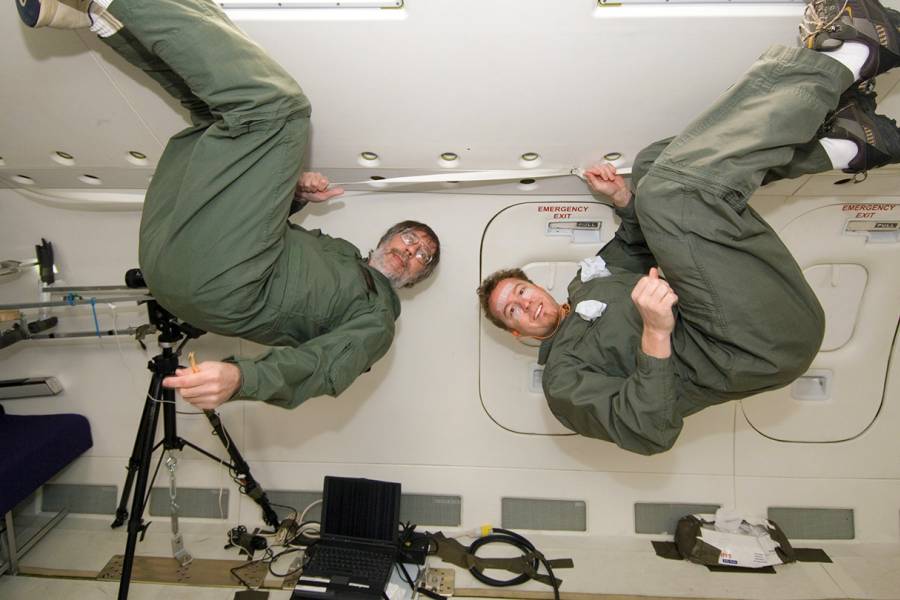
Credit: Courtesy of Mark Shelhamer
Making space travel safer
As nasa prepares to send humans back to the moon and beyond, mark shelhamer and fellow hopkins scientists work to ensure that future space travelers survive and thrive out there.
By Laura Wexler
O n July 20, 1969, Mark Shelhamer watched the televised broadcast of the Apollo astronauts landing on the moon along with 600 million other folks on Earth—including his mother, who worried Neil Armstrong would take his famous leap only to sink into the moon, buried by lunar dust. Shelhamer was 10 years old, full of excitement and awe—and with exactly zero concern for any harm to Armstrong or his fellow Apollo crew members.
Fifty years later, there is arguably more momentum for human space travel than at any time since that day in 1969. NASA has pledged to send astronauts back to the moon by 2024—not just to visit, but to create a permanent human settlement and a launch pad to Mars in 2033. Commercial companies Virgin Galactic and Blue Origin plan to hurtle civilians into suborbital space for a glimpse of Earth and a taste of zero gravity by year-end. And in March, a SpaceX spacecraft completed a successful test mission, making it likely the company will begin shuttling American astronauts to the International Space Station this summer. In the entire history of human spaceflight, only 571 people have been to space, and only 12 have stepped on another planetary body. That number is about to grow exponentially.
Image credit : Bryce Wymer
These developments delight Shelhamer, who, at 60, retains his boyish zeal for human spaceflight. But they also deeply concern him. In 2013, he took a leave from the School of Medicine, where he's an associate professor of otolaryngology, to serve as chief scientist of NASA's Human Research Program . In that post, he got up close and personal with exactly how the harsh conditions of space imperil the fragile human corpus. Bones and muscles weaken. The immune system goes haywire. Without the pull of gravity, fluid pools in the head, causing damage to the structure of the eye. And, as recently discovered, time in space changes humans at their most fundamental level: their genes.
Of all the threats to health and human performance on long space voyages, NASA has identified two as the most serious: exposure to space radiation and the behavioral risks of being trapped with a small group of people in a tin can, far from home. As chief scientist, Shelhamer oversaw research to understand and mitigate those risks. As he puts it, "NASA wants to send people to the moon and Mars without killing them, or them killing each other."
Now that he's returned to Hopkins, Shelhamer is enlisting his colleagues to help NASA do exactly that: use their expertise to help prepare humans for life far beyond the Earth's protective atmosphere.
"It's about preventive medicine, making sure the crew is as healthy as they can be when they start, and trying to detect things before they become problems," he says. "It's about medicine and engineering, about using statistics to make decisions based on probability. It's much more than just figuring out how many Band-Aids and pills to take to Mars."
I n 1981, when the space shuttle Columbia first shot into space, Shelhamer was an engineering student at Drexel University so obsessed with space travel that he stayed up all night reading technical reports from the Apollo, Mercury, and Gemini missions. "It's like a good magic trick," he says, referring to the Apollo missions. "The more I learned, the more amazed I was that it could even be done." He assumed his passion for space would be just a hobby, until he discovered Massachusetts Institute of Technology's Man Vehicle Laboratory (now the Human Systems Laboratory), which was seeking graduate students to investigate how the brain's vestibular system—the part of the ear that senses the speed and direction of the body's movement and regulates balance—adapts to gravity changes.
Image caption: Shelhamer, inverted in the aisle of NASA's zero-gravity aircraft
Image credit : Courtesy of Mark Shelhamer
Since then, Shelhamer has devoted much of his professional career to studying the body's vestibular adaptations in space. He's participated as a graduate student in experiments that were sent up on two Spacelab flights and clocked 80 flights on NASA's parabolic aircraft, aka the vomit comet, which simulates zero gravity. One of those flights was in the company of his wife, Jennifer Wiseman, the senior project scientist for the Hubble Space Telescope at NASA's Goddard Space Flight Center, whom he met at MIT. They have a long-running, but friendly, rivalry over which type of spaceflight should be higher priority. He argues for manned and she for unmanned.
In 2013, when a friend forwarded Shelhamer the posting for the chief scientist job and urged him to apply, Shelhamer thought it was crazy. There was no way he was qualified. And when NASA offered him the two-year position, he planned to turn it down because it meant moving to Houston while Wiseman stayed in Maryland—and he didn't want to be away from her. "I was pacing outside our house and I came in and told my wife I'd decided not to do it," he says. "She said, 'Look, space has always been a part of our lives. It's what we do. Our marriage is strong, we'll get through this.'" She also reminded him: "You'll be overseeing the experiments on the space station. How cool is that?"
It was very cool. After years of being immersed in his specialized niche of human spaceflight research, Shelhamer suddenly had a holistic view of NASA's entire human research program from the highest level.
But the chief scientist job was stressful. Shelhamer had never been a manager before. There were too many meetings, and too few chances to engage in the deep intellectual satisfaction of doing science. And, he says, he became convinced that the health risks of human spaceflight have to be studied as a system of cross-disciplinary, interrelated factors, not as individual problems. "The thing that's going to kill someone in space is going to be an interaction of separate problems," he says. "You can have the individual problems solved, but there's a domino effect and the next thing you know someone is dead."
Since returning to his faculty position at Hopkins in 2016, Shelhamer has continued with his research. He has an eight-year NASA grant to monitor the vestibular adaptations of astronauts spending up to a year on the ISS. But he spends most of his time on his new mission, which is to create a Center for Space Life Sciences at Hopkins. "I'm essentially trying to create a miniature NASA human research program here," he says. "With a world-class medical school, strong engineering program, the [Johns Hopkins] Applied Physics Laboratory, and the School of Arts and Sciences, we can hit the major human health and performance issues, and do it in an integrative cross-disciplinary way." The center Shelhamer envisions would build upon the university's existing space studies program Space@Hopkins , directed by astrophysicist Charles L. Bennett , but focus specifically on human and biological space science.
Without the resources or authority to create such a center from the top down, Shelhamer is building support from the ground up, relying on financial support from the Whiting School of Engineering's Commercial and Government Program Office and a lot of gumshoe detective work to identify scientists whose research could relate to human spaceflight. Part Don Quixote, part carnival barker, part fixer, he spends hours each day calling and emailing scientists across Hopkins. "I have this conversation with everyone I can find: 'Hey, there's a NASA grant solicitation ... I can help you tap into a new funding source,'" he says.
It's not an easy sell. Funding is tight. NASA's budget for human health and performance research is minuscule compared to that of the NIH. Impact is small. Why would a scientist want to investigate health issues that affect a handful of astronauts when there are diseases that affect millions here on Earth? And, all research has to be tied to a health risk. "Doing science for NASA is not like doing basic science. It's risk mitigation to keep people safe in space."
Yet for Shelhamer, these challenges are trumped by an unwavering belief in the value of human space travel. "Human spaceflight is inspiring in a unique way," he says. "It expands the human experience."
O n a rainy Tuesday afternoon in February, in the basement of a research building on the East Baltimore campus, Shelhamer has gathered six Hopkins scientists, who've never met, to discuss space radiation. He begins by introducing Catherine M. Davis and Robert Hienz , researchers in the Division of Behavioral Biology in the Department of Psychiatry and Behavioral Sciences in the School of Medicine, as "the only people in the room to get paid by NASA for radiation work." Davis and Hienz investigate the effects of radiation on the brain by studying the cognitive performance of rats exposed to a radiation dose comparable to what humans would sustain during a two-year space voyage. Nearly half the rats exposed to radiation in the study, which was published in the March 2014 issue of Radiation Research , showed attention lapses and delays in reaction time for months afterward, but the rest were seemingly unaffected, says Davis. This tells us there might be individualized susceptibility to radiation. Human translation: Some people may be more harmed by space radiation than others. "If we can understand the biological mechanism behind the changes from radiation," Davis says, "it could inform a countermeasure—whether pharmacological or cognitive—that could protect astronauts on missions to the moon or Mars, or help them recover when they return."
Davis has barely finished explaining her work when Adam Kaplin , an assistant professor of psychiatry and behavioral sciences, says, "I'm sorry, I can't wait any longer. Have you looked at inflammatory markers?"
Davis shakes her head. Mike Wang, a graduate student in neuroimmunology and adjunct faculty at the School of Arts and Sciences who works with Kaplin, says, "I'm about to explode. It's amazing how much what you're saying dovetails with what we're doing."
Kaplin and his team study the relationship between neuroinflammation and depression in patients with multiple sclerosis. Though it might seem MS would have little to do with astronauts, Kaplin says radiation exposure causes complicated damage all over the body. "MS is a very good model for looking at what the nervous system will do when it's constantly unhappy in a whole-body way," he says.
Kaplin has never done human spaceflight research before. But just a week prior to this basement meeting, he presented at a conference hosted by the Translational Research Institute for Space Health, known as TRISH, which funds research to preserve astronaut physical and mental wellness during deep space exploration missions. And simultaneously, Wang began wondering how Kaplin's work could help protect his brother, a mechanical engineering student and Air Force airman who is on a path to become an astronaut. "In digging through the literature about the brain under exposure to extreme environments, I realized our lab has a lot to offer," says Wang. "Everything about space threatens to increase neuroinflammation."
As his colleagues discuss the harmful effects of radiation, Radamés J.B. Cordero sits in the back of the room, listening intently before explaining that melanin, a natural material found in all kingdoms of life that's known to protect organisms from high levels of ionizing radiation, could shield humans from radiation in the first place. "People living on Mars could eat melanin capsules, which could provide internal shielding for the gut and organs," says Cordero, a research associate in the Molecular Microbiology and Immunology Department at Johns Hopkins Bloomberg School of Public Health. "Melanin could also be used as a structural material in the shuttles, habitats, and spacesuits to provide external protection."
Melanin could also be used as a renewable, organic heat source, he says. In a study published last summer in Current Biology , Cordero and his team showed that black melanotic fungi heated twice as fast and twice as hot as white fungi when exposed to radiation. "We already knew melanin was efficient in absorbing radiation," he says. "But this study was the first time that we could control many of the confounding variables and show how effective melanin is at capturing heat." Another big plus for melanin: It's easily transportable. "You could bring a tiny Q-tip of melanin and it will grow and replicate in space," Cordero says.
In the front of the room, Shelhamer beams. These are exactly the kinds of cross-disciplinary conversations he wants to foster and support through his Center for Space Life Sciences—and exactly the kinds of collaborations he believes can successfully address the health risks of human spaceflight. In the coming weeks and months, he'll guide these researchers in applying for funding for human spaceflight research, drawing on his NASA experience to help them navigate the system. He's also working with ophthalmology Professor Neil Bressler and engineering Professor Phillipe Burlina on a proposal to analyze retinal imaging data from astronauts on the ISS to detect early onset of medical conditions related to "spaceflight-associated neuroocular syndrome," or SANS.
But Shelhamer isn't only recruiting Hopkins faculty into the human spaceflight field. He's also building interest in students. Currently, he mentors Serena Tang, a rising senior majoring in neuroscience and physics, who is working with him on a study funded by an undergraduate research award and a NASA grant. Tang had never considered human spaceflight research until she heard Shelhamer present a lecture in 2016, and now she's "99% sure" she wants a career in the field. So does medical student Ben Johnson, who, along with fellow Johns Hopkins medical student David Mampre, created a student interest group devoted to aerospace medicine.
"I find aerospace medicine to be extremely fascinating because it touches on almost every aspect of medicine, from neurology to nutrition, and requires you to rethink the subject in the context of outer space and extreme conditions," says Johnson, who is currently on leave from Hopkins studying for degrees in neuropsychology and space physiology in Europe as a Marshall Scholar. "Between zero gravity, radiation, and extended times in space, every mundane issue on Earth is transformed into something exciting and new."
When Johnson and Mampre invited Shelhamer to be the adviser for their group, they figured it was a long shot. He had been chief scientist for NASA after all. Turns out Shelhamer had been hoping for such an invitation. The group has hosted speakers and visited the Hubble Telescope mission control center where, thanks to his wife, Shelhamer has an "in." Like Shelhamer, Johnson and Mampre believe that student interest in human spaceflight research will grow as private space companies forge forward and the push to reach Mars heightens.
"The goal of medicine is to prolong life," Mampre says. "Space medicine is the epitome of that goal: extending life beyond Earth."
I f radiation is the most serious risk to human health on long space voyages, the effects on cognition and mood are a close second. "We're talking about a small number of people, in a small space, at a long distance, for a long duration. And no chance to turn around," says Shelhamer. That means the potential for extreme boredom, homesickness, depression, and interpersonal conflict, issues that may seem minor compared to the threat of cancer or vision problems but aren't. Depressed crew members can't perform tasks, make decisions, or work together to survive in an inhospitable environment.
Image caption: NASA astronaut and twins study participant Scott Kelly gives himself a flu shot in September 2015 while on NASA’s one-year mission aboard the International Space Station.
Image credit : NASA
Shelhamer is working with APL scientists Ariel Greenberg and John Gersh on a proposal to investigate personalized mixed/augmented/virtual reality environments and activities that could offer sensory and task experiences, like exercise and ship maintenance, and help improve social cohesion through games like a virtual treasure hunt.
He's also working with Mike Rosen, a human factors psychologist in the School of Medicine's Armstrong Institute for Patient Safety and Quality , to develop tools to identify individuals who function most effectively as part of a team in a stressful situation. With funding from NASA, Rosen is currently running a study that uses a variety of unobtrusive biosensors—wrist monitors, location sensors, and a speech analysis app—to monitor two groups of astronaut analogs working in stressful situations: crew members spending 45 days living in a simulated Mars environment inside NASA's Human Exploration Research Analog, known as HERA, at Johnson Space Center, and physician teams in an intensive care unit at Johns Hopkins Hospital. The biosensors collect physiological data on each subject as they go through their days, dealing with long work hours, potential crises, and lots of decision-making. Shelhamer and his students will help decipher the data to identify relationships between different physiological responses and potential early signals of a breakdown in the group dynamic. Since a subject can't "game" his or her physiological responses over a long period of time, Rosen believes the study could be helpful in determining which of NASA's astronaut candidates will function best in a team setting.
"For these longer missions NASA is planning, everything gets more important. You want to pick people where the risk of interpersonal conflict is minimized, people who can survive and thrive as part of a social unit. Not stir up trouble," says Rosen. "Picking an astronaut crew is much less like picking an airline crew or combat crew than picking a family."
In other words, it's complicated. Like everything to do with human spaceflight.
I n 2015, Shelhamer was serving as chief scientist when NASA launched the " twins study ," in which astronaut Scott Kelly was monitored during 340 days aboard the ISS while his identical twin Mark underwent the same measures back on Earth. The study presented an extraordinary chance to understand the effects of space on the human body. Because Scott and Mark Kelly share identical DNA, any changes in Scott could be attributed to his time in space. Ten research teams from across the country analyzed the Kelly brothers' stools, urine, and blood to look for changes in metabolism, immune response, gut biome, and genetic makeup. Hopkins geneticist and Bloomberg Distinguished Professor Andrew Feinberg led a team that analyzed the Kelly brothers' blood for changes in levels of DNA methylation , the process by which cells "turn on and turn off" gene expression.
Image caption: Feinberg (left) and Rizzardi spent a week aboard NASA's vomit comet, a modified Boeing jet that simulates the weightlessness of the space station
Image credit : Johns Hopkins Medicine
Astronauts on the ISS are accustomed to drawing their own blood samples, which are frozen and transported back to Earth. But since frozen blood doesn't yield good quality DNA for genomic testing, Feinberg's team had to develop a procedure by which Scott Kelly could separate the cells in his blood while on the ISS. To do that, Feinberg and Lindsay Rizzardi, a senior scientist at HudsonAlpha Institute for Biotechnology who was then a postdoctoral fellow working with Feinberg, spent two days aboard NASA's vomit comet learning how to separate blood in zero gravity. "A digital display above the cockpit displayed what the gravity was," says Rizzardi. "Andy was watching it, and when it got to zero he told me and I had 25 seconds to use the pipette to transfer the cells in the blood from one tube to another."
For Feinberg, floating in zero G was the culmination of a dream. In 1979, he applied "on a lark" to become an astronaut along with 7,000 others. He was part of a group of 70 that made it to the second round. "But there wasn't another recruitment for three years," he says, "and in the interim I discovered altered DNA methylation in cancer and decided I'd rather work on that." While Feinberg was giddily doing "superman poses" on the parabolic flights, Rizzardi says she was trying not to throw up—and failing. She and Feinberg tested a portable genetic sequencer, proving that positive displacement pipettes work in space—and becoming the first people to sequence genes in zero gravity.
Once the methodology was set, the challenge was coordinating blood draws with the Russian's Soyuz spacecraft schedule. Scott Kelly would draw his sample on the same day the spacecraft returned to Kazakhstan. From there, it was flown to Houston, transported to the lab at Johnson Space Center, processed, frozen, and shipped to Johns Hopkins. The entire trip took more than 36 hours, Rizzardi says. Not quite one-day Amazon Prime delivery, but close.
Feinberg and Rizzardi expected to find significant changes in Scott's DNA methylation during his time in space, but the data didn't reflect that. Yes, there were fluctuations, but they were in the range of normal. While Rizzardi says the data can be viewed as "a boring negative result, it's pretty cool," she says. "Humans are resilient. It was reassuring." Feinberg would like to do more research for NASA. "It was really great to be part of what is the greatest science project of all time: the project to turn us from a terrestrial species to an interterrestrial species," he says.
The other research teams in the twins study reported far more attention-getting changes in Scott's body during his time in space. His immune system was disrupted, his telomeres lengthened, his cognitive function declined, and the health of his eyes degraded. Most of these changes were temporary, and returned to normal when Scott got back to Earth. But a subset of his genes related to immune function and DNA repair did not bounce back. Researchers believe this is due to damage from space radiation.
Like so much of the research related to human spaceflight, the twins study yielded more questions than answers. But it did provide an answer to one key question: Are humans ready for long-duration space voyages?
Not yet, Shelhamer says.
There's more data to collect, more hypotheses to formulate, more interventions to create, whether it's giving astronauts melanin capsules, or bespoke XR experiences, or medicines to reduce inflammation. But, says Shelhamer, it needs to happen soon. "If we're sending people to Mars in a few decades, we've got to get moving," he says.
So he calls, he emails, he gives his pitch for human spaceflight research to his Hopkins colleagues. All in the hope that decades from now people will watch the first astronauts step on Mars, awed and amazed and assured they are safe.
Laura Wexler is a Baltimore-based nonfiction writer.
Posted in Science+Technology
Tagged nasa , space , outer space , space@hopkins
Related Content
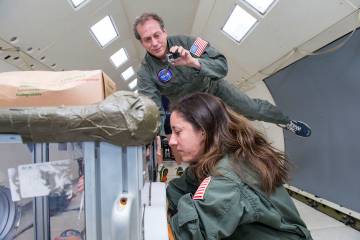
Study looks at how astronaut's body changed in space
You might also like, news network.
- Johns Hopkins Magazine
- Get Email Updates
- Submit an Announcement
- Submit an Event
- Privacy Statement
- Accessibility
Discover JHU
- About the University
- Schools & Divisions
- Academic Programs
- Plan a Visit
- my.JohnsHopkins.edu
- © 2024 Johns Hopkins University . All rights reserved.
- University Communications
- 3910 Keswick Rd., Suite N2600, Baltimore, MD
- X Facebook LinkedIn YouTube Instagram
6 types of objects that could cause space debris apocalypse
Cold War-era junk dominates the list of hazardous orbiting objects.
The space around our planet is getting cluttered. Thousands of satellites and millions of out-of-control fragments of space debris hurtle high above our heads, threatening to collide. Here are the objects that experts fear the most.
In just the past month, the goings-on in near-Earth space have twice made headlines and prompted experts to call for action. On Jan. 27, space debris researchers looked on in horror as two huge pieces of space junk — a decades-old upper stage of a Russian rocket and a long-defunct Russian satellite — came within 20 feet (6 meters) or so of each other. The incident, described as a close call "worst case scenario," could have spawned thousands of dangerous debris fragments that would have stayed in orbit for centuries. Then, a report released on Feb. 6 revealed that in early January a mysterious Russian satellite broke apart into 85 fragments large enough to be tracked from Earth.
Both of these incidents happened in areas that experts refer to as bad neighborhoods , regions of low Earth orbit too high above the planet to benefit much from the cleaning effects of its atmosphere. Both of these incidents involved objects that are at the top of space debris experts' list of hazards. Here we review what type of stuff the experts fear the most.
Related: How fallen space junk could aid the fight against orbital debris
1. Russian SL-16 rocket bodies, aka Zenit upper stages
Surprisingly, it's not the hundreds or even thousands of new spacecraft put up by megaconstellation operators such as OneWeb or SpaceX that have the highest chance of bringing on orbital doom. It's the old stuff — spent rocket stages and large, chunky satellites — launched during the Cold War era and into the early 2000s.
"Constellations may have hundreds to thousands of satellites, but they are quite good at orchestrating themselves," Darren McKnight, a senior technical fellow at private debris monitoring firm LeoLabs, told Space.com in an interview. "They have a propulsion system that makes them very agile, and they can make collision-avoidance maneuvers. The derelict objects, on the contrary, have no ability to maneuver away from each other."
Among these old derelict objects, the SL-16, a giant 9.9-ton (9 metric tons), 36-foot-long (11 meters) upper stage of Russia's Zenit rocket, is the source of the greatest apprehension.
LeoLabs currently monitors 18 of these rocket stages that circle Earth in one of the "bad neighborhoods" at the altitude of around 520 miles (840 kilometers). From this altitude, it will take centuries for the debris to come down. In the meantime, the rockets continue crossing paths with thousands of other defunct spacecraft and millions of debris fragments.
"They're like a big yellow school bus without a driver, without brakes," McKnight said. "And there is a cumulative risk. It would not be unexpected to have one of these rocket stages be involved in a collision very soon."
The sheer size of these rockets means that a collision would produce an enormous amount of space debris fragments that would turn the bad neighborhood into an even worse one, possibly triggering the Kessler syndrome , a dreaded scenario of unstoppable cascades of collisions such as the one depicted in the 2013 Oscar-winning movie "Gravity."
"If you worry about scenarios such as the Kessler syndrome, the probabilities are dominated by two big things hitting each other, because that would generate by far the most debris that then can trigger a chain reaction," Jonathan McDowell, an astronomer and astrophysicist at the Harvard–Smithsonian Center for Astrophysics and a leading space debris expert, told Space.com.
McDowell added that the rocket stage problem, while not unique to Russian technology, has to do with the launcher design that Russia's predecessor, the Soviet Union, frequently went for. Most rockets used by Europe, the U.S. and even China rely on massive first stages that fall back to Earth shortly after launch and use a comparatively small upper stage to deposit their payload in orbit.
"The U.S., for example, would typically use the Centaur upper stage, which uses liquid hydrogen," McDowell said. "This fuel provides higher miles per gallon. And so a smaller rocket can do the same job. The Russians were using kerosene or hydrazine, which are lower energy chemical propellants that needed a bigger rocket for the same job."
Darren McKnight is a Senior Technical Fellow at LeoLabs, a private California-based firm mapping orbital traffic. McKnight is a member of the International Academy of Astronautics' Space Debris Committee, where he contributes to the development of position papers on the topic of space debris mitigation. He is interested in developing technical solutions for managing the space debris problem and encouraging sustainable practices in space utilization.
McKnight holds a Bachelor's Degree in Engineering Sciences from the United States Air Force Academy, a Master's in Mechanical Engineering from the University of New Mexico and a Doctorate in Aerospace Engineering from the University of Colorado.
2. Russia's SL-8 rocket stages and cold-war spy satellites
The near miss of Jan. 27 involved another type of Russian rocket upper stage — the 1.54-ton (1.4 metric tons) SL-8. This rocket stage, used by Russia in its smaller rocket family called Kosmos, delivered between the 1960s and 1990s about 145 spy and communication satellites to the altitude of 605 miles (975 km), according to McKnight. The satellites, each with a mass of 1,760 pounds (800 kilograms) and no longer in use, are still polluting this part of near-Earth space, and so are the rockets that launched them.
"These objects have been lingering there for decades," said McKnight. "If they were all launched in 1990, the probability of one of them to experience a collision in 2023 would be around 20%. We have nearly experienced it [on Jan. 27]. And in situations like these, you can only cross your fingers and hope."
The satellite involved in the recent near-miss was also a property of Russia — a 1,760-pound (800 kilograms) Cosmos 2361 espionage satellite launched in 1998 on a Zenit rocket.
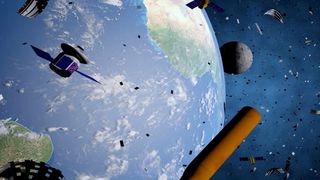
Jonathan McDowell is an astronomer and astrophysicist at the Harvard–Smithsonian Center for Astrophysics. His main research focus is on black holes, quasars and sources of high-energy X-ray radiation in distant galaxies. He is a member of the team behind NASA's X-ray observatory Chandra, but has also gained prominence as a leading space debris expert. McDowell is the author and editor of Jonathan's Space Report, an e-mail-distributed newsletter documenting satellite launches.
McDowell has a Bachelor's Degree in Mathematics from Cambridge University in the U.K. and a PhD in Astrophysics also from Cambridge.
3. Chinese anti-satellite missile test fragments
In 2007, the bad neighborhood where the larger SL-16 rocket stages reside became the location of one of the worst debris-creating events in history — a Chinese anti-satellite missile test that targeted one of the nation's own defunct weather satellites. The anti-satellite missile hit the 1,650-pound (750 kg) Fēngyún spacecraft, orbiting at the altitude of 537 miles (865 km), at the speed of 18,000 mph (29,000 kph), shattering it into thousands of fragments. The fragments, like balls on a billiard table, scattered in all directions upon impact, polluting near-Earth space hundreds of miles away from Fēngyún's original orbit.
Some of these fragments, McKnight said, were detected as high as 1,060 miles (1,700 km) and as low as 217 miles (350 km) above Earth's surface. Suffice to say that the bulk of this debris travels in the same bad neighborhood as the 9.9-ton SL-16 rocket stages, which have no way of avoiding it.
Out of the 3,500 pieces of Fēngyún debris that were large enough to be tracked by Earth-based radars shortly after the incident, 2,800 still hurtle completely out of control around the planet, threatening everything in their path.
"Debris from this single event was probably responsible for about 15% of the conjunctions [close approaches to other objects] that occurred last year," McKnight said. "Every 15 minutes, we issue conjunction messages involving fragments from this collision."
Overall, McKnight added, LeoLabs issued 400,000 conjunction alerts in 2022, warning spacecraft operators when other space objects were on a trajectory to pass too close to their spacecraft.
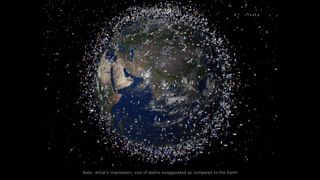
4. Earth-observing satellites Envisat and Landsat
The defunct European Earth-observing satellite Envisat circles the planet at the altitude of 480 miles (800 km), which is below the two main bad neighborhoods. Due to its sheer size, however, the satellite occupies a prominent spot on the list of worrisome objects.
At about 8.8 tons (8 metric tons), Envisat, which died a premature death in 2012, is one of the largest pieces of space junk in orbit, and a large stain on the reputation of the European Space Agency (ESA), which prides itself for its leadership in space sustainability.
NASA, too, has its share of defunct Earth-observing debris. Since the 1970s, the American space agency has launched nine generations of its Landsat satellites , only two of which are still operational. Weighing between one and three tons, the Landsat satellites orbit the Earth at altitudes between 430 and 560 miles (700 and 900 km). None of the already out of service satellites were successfully deorbited at the end of their lifetimes.
The U.S. National Atmospheric and Oceanic Administration (NOAA) has also left quite a bit of space clutter behind. Since the 1960s, NOAA has flown two dozen of polar-orbiting weather satellites that circle Earth at altitudes between 430 and 560 miles (700 and 900 km). 17 of these satellites, weighing between one and three tons each, are now dead but continue on their paths crossing the high-risk neighborhoods.

5. The Hubble Space Telescope
The iconic Hubble Space Telescope may still have a decade or more of life in it but it has the potential to turn into a troubling piece of debris once its mission is over.
At 12.4 tons (12.2 metric tons), the veteran universe observer is heavier than both Envisat and the dreaded SL-16 rocket stages. Hubble orbits relatively low, about 332 miles (535 km) above Earth's surface, and so would likely take only a few years to spiral back to Earth. Due to its size, however, the telescope would unlikely burn up completely in Earth's atmosphere during the re-entry. Sizeable chunks of the telescope's scorched body would likely land on the planet's surface, enticing souvenir collectors but also quite possibly causing damage to aircraft in the air or humans and infrastructure on the ground.
NASA says on its website that it plans to "safely de-orbit or dispose of Hubble" at the end of the telescope's lifetime. The problem is, however, that the telescope has no on-board propulsion system that could lower its altitude in a controlled fashion at the end of its mission and guide it to a safe splashdown in the ocean.
Various ideas have been proposed, including boosting the telescope into a higher altitude using SpaceX Dragon spacecraft, or bringing it down with a yet non-existent space transportation vehicle .
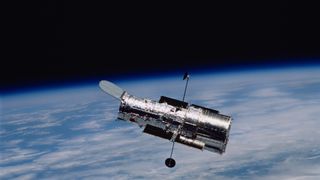
6. Too many constellation satellites
— Getting space junk under control may require an attitude shift — What goes up must come down: Study looks at risk of orbital debris casualties — Who's going to fix the space junk problem?
Experts somewhat differ in their views on the risks posed by satellite megaconstellations such as SpaceX's Starlink and the network operated by OneWeb. These constellations drive the massive increase in the numbers of orbiting satellites that we have witnessed in the past decade and will continue to see in the coming years.
According to LeoLabs , in the first 50 years after the launch of the world's first satellite, the Soviet Union's Sputnik 1 in 1957, 10,000 objects, dead and alive, had accumulated in low Earth orbit. Then the new space revolution arrived, and, within merely 14 years, the number doubled. As of late 2022, there were more than 21,000 objects in this heavily used region of space, LeoLabs reported.
Hugh Lewis, a British space debris expert and professor of astronautics at the University of Southampton in England, told Space.com that SpaceX — the world's largest satellite operator, with over 3,500 active spacecraft in orbit as of February 2023 — deserves praise for its attitude to managing collision risk. The company's autonomous collision avoidance system enables satellites to make a maneuver every time it registers a passing object with a 1 in 100,000 collision probability. In comparison, NASA only dodges stuff that has a collision likelihood of 1 in 10,000.
Hugh Lewis is a Professor of Astronautics at the University of Southampton in the U.K. and a co-director of the Centre of Excellence in In-situ and Remote Intelligent Sensing. He has worked in the fields of space debris and space sustainability for more than 20 years and is the author of the DAMAGE space debris model. Hugh represents the U.K. Space Agency at meetings of the Inter-Agency Space Debris Coordination Committee (IADC) where he chairs Working Group 2 (which is focused on space debris modeling).
Hugh has also represented the U.K. Space Agency at Scientific and Technical Sub-Committee meetings of the United Nations Committee on the Peaceful Uses of Outer Space (COPUOS) as an expert on space debris, space operations and space situational awareness.
Still, Lewis said, with SpaceX's aim to deploy up to 42,000 Starlink satellites, over 10 times more than it currently has in orbit, and with other operators lining up to enter the market, even that low probability has a statistically high probability of producing a collision over time.
"The residual risk is potentially an issue, as the number of close approaches continues to rise," Lewis said. "As the number of maneuvers they make continues to increase, maybe in spite of all these efforts, they will still get involved in a collision. With a higher number of low probability events, there is a higher probability collectively that a collision will occur."
McDowell said that, while SpaceX alone may be able to manage its Starlink constellation with a high level of reliability, once multiple such constellations share the same orbital region, the situation will be akin to managing traffic in a major city.
"Five or 10 years from now, we may have anywhere between 20,000 and 100,000 satellites in orbit," McDowell said. "And I am very skeptical that such a number can be operated safely. It only takes one company to enter a wrong number into their database and have bad data, and suddenly, all of your safety calculations are no longer valid and you end up with a collision."
Whatever happens, we are surely going to hear more about space debris and satellite collisions in the coming years.
Correction: This article has been corrected on Feb. 20. It originally stated that the Hubble Space Telescope will be deorbited using its own fuel.
Follow Tereza Pultarova on Twitter @TerezaPultarova . Follow us on Twitter @Spacedotcom and on Facebook .
Join our Space Forums to keep talking space on the latest missions, night sky and more! And if you have a news tip, correction or comment, let us know at: [email protected].
Get the Space.com Newsletter
Breaking space news, the latest updates on rocket launches, skywatching events and more!
Tereza is a London-based science and technology journalist, aspiring fiction writer and amateur gymnast. Originally from Prague, the Czech Republic, she spent the first seven years of her career working as a reporter, script-writer and presenter for various TV programmes of the Czech Public Service Television. She later took a career break to pursue further education and added a Master's in Science from the International Space University, France, to her Bachelor's in Journalism and Master's in Cultural Anthropology from Prague's Charles University. She worked as a reporter at the Engineering and Technology magazine, freelanced for a range of publications including Live Science, Space.com, Professional Engineering, Via Satellite and Space News and served as a maternity cover science editor at the European Space Agency.
NASA astronaut photographs SpaceX's private Polaris Dawn capsule reentry from ISS (photo)
SpaceX's private Polaris Dawn astronauts will return to Earth early Sunday. Here's how to watch live online
Did a star escape cannibalism by its dead 'monster' white dwarf companion?
- dlwmtech Hubble has no fuel. It has no engines or thrusters of any kind and is therefore at the mercy of orbital mechanics. Please research your facts before writing articles like this. Reply
- dlwmtech There are no plans at this time for NASA to conduct or fund a dedicated Hubble servicing mission. (as per the web site). Reply
- View All 2 Comments
Most Popular
- 2 Scientists spot ancient 'smiley face' on Mars — and it could contain signs of life
- 3 Auroras galore! Severe geomagnetic storm sparks stunning northern lights across US (photos)
- 4 Don't miss the Harvest Moon Supermoon lunar eclipse tonight! Here's what to expect
- 5 IDW's 'Star Trek: Lore War' will bring back Data's evil brother in 2025 comics crossover event
How Space Radiation Threatens Lunar Exploration
Scientists are studying the possible impacts of the hazard on astronauts who will travel to the moon
Mrigakshi Dixit, Supercluster
:focal(800x602:801x603)/https://tf-cmsv2-smithsonianmag-media.s3.amazonaws.com/filer_public/8a/e0/8ae05280-34c4-42e0-ae3d-ce11718d9d2d/art001e001999_orig_web.jpg)
NASA is preparing to return astronauts to the lunar surface. And this time with more ambitious goals.
Those missions, which had a successful kickoff with Artemis-1 , will establish the groundwork for months-long human habitation on the Lunar surface. Proposed base camps will present unique opportunities to test technology, unravel scientific secrets about the Moon's past and present, search for the presence of water, and more.
But before our sci-fi Moonbase becomes a reality, astronauts must perform a variety of tasks on the lunar surface, including site exploration, construction, and resource extraction. For all of these tasks and the operations in between, space radiation poses a threat to the space farers performing them.
Between 1968 and 1972, the Apollo missions carried a dozen astronauts to the Moon and back. But all of these missions were brief — the longest lasted only about 12 days. We’ve been there before, but the effects of space radiation are still little-known, and understanding their effects on the human body is vital for months-long missions.
A Fusillade of Powerful Particles
Earth's magnetic field and atmosphere shield it from dangerous radiation and safeguard life on the planet. The outer worlds that humanity has targeted are incredibly hostile by comparison. Even an hour without adequate protection could be lethal, as charged particles pass constantly through human skin. This paints a bleak picture for future exploration.
Even our Moon is a hazardous, desolate place — devoid of atmosphere, and lacking protection from a constant rain of radiation emitted by our Sun. Apart from the Sun, astronauts are also subjected to other sources of radiation on the Moon.
First to consider are the galactic cosmic rays (GCR) released by exploding stars out in deep space. And then there are particles created in the lunar soil, as a result of the interactions between solar energetic particles from the Sun and galactic cosmic rays. Solar particles are less energetic than galactic cosmic rays, “but when there is a solar particle event, then their flux can be much higher than that of galactic cosmic rays,” said Robert F. Wimmer-Schweingrube from the University of Kiel in Germany.
In the annals of human spaceflight, August 1972 is unforgettable. A series of intense solar flares exploded intermittently for more than a week. A solar flare is an outburst of charged particles from the Sun’s turbulent surface. There are five classes: A, B, C, M, and X, ranging in size from the smallest to the most dangerous. The intense solar storm of 1972, which was an X-class flare, originated from a sunspot named MR 11976.
The crew of Apollo 16 had landed on Earth in April, and the final Apollo 17 trip was scheduled for December. A potential disaster was narrowly avoided. Astronauts stepping onto the lunar surface would have died from radiation, and the storm's fury was felt on Earth as well — it disrupted the energy and communication grids in several parts of North America.
Dangerous Passage
Space radiation poses a concern not just on the surface, but on the round-trip journey. Around Earth, there are hazardous radiation rings, the Van Allen Belts, consisting of highly charged particles captured by the planet’s magnetic fields. The more time spent passing through these belts, the greater the risk of radiation poisoning.
There are two radiation rings. The first one starts at a height of 600 km and extends to 6,000 km. The second deadly ring stretches from between 10,000 and 65,000 kilometers above Earth. The intensity of the latter only gets worse as solar storms rage. Thankfully the Space Station remains untouched and shielded in low-Earth Orbit at 230 miles, but though our lunar spacecraft are designed to shield their crew, the flood of lethal particles can still seep inside.
So how did earlier Apollo missions manage to navigate this challenging area? Speed. The past Apollo missions followed a tight trajectory to avoid the most radioactive part of the belts and traversed at a high speed. Scientists determined the optimal speed for crew-carrying spacecraft to be roughly 25,000 km/h with a total transit period of 68.1 minutes .
Radioactive Baker’s Yeast
In this new space age, the dread of radiation still looms. And new answers are needed. The Artemis-1 mission carried mannequins and other biological experiments to study exposure.
Yeast cells flown on the mission require little upkeep for factors like water, temperature, or nutrients. Yeast acts as a model organism in DNA damage studies, and its response has been well studied. A near-perfect analog for human genes is the baker's yeast ( Saccharomyces cerevisiae ). This single-celled microorganism can give information on how living organisms cope with dangerous cosmic radiation.
The experiment tries to unravel complicated space radiation-related puzzles. What effects do charged particles have on DNA, cells, and tissues in humans? What degree of DNA damage is there? Which genes were radiation-resistant?
Peter Guida, a biologist with NASA explains in a statement : “DNA bases (adenine, guanine, cytosine, and thymine) can also be knocked out. The cell will make an attempt to repair these damages. Sometimes it’s effective and sometimes it’s not, and sometimes it can be misrepaired. Genes that have been misrepaired can become mutations, and the accumulation of these mutations over time can potentially lead to cancer.”
To study this accumulation, a collection of bar-coded yeast cells traveled to the Moon and back. Yeast cells were supposed to grow and divide throughout the mission after the samples have been launched to space and activated remotely by the addition of water.
With Orion’s return to Earth, scientists from the University of British Columbia will retrieve the samples to carry out a laboratory study. Once the genes have been identified, scientists could use this information to develop drugs or treatments that can tolerate radiation shocks and reduce the likelihood of adverse health effects.
Meanwhile, another deep-space biology experiment will carry more yeast samples to orbit around the Sun for about six to nine months. BioSentinel — a shoebox-sized CubeSat — which also hitched a ride on Artemis-1. A new biosensor is used in the experiment to examine how living yeast cells respond and adapt to prolonged exposure. Scientists will track the experiment in real time via NASA’s Deep Space Network.
How Much is Too Much?
The 1972 event is sometimes used as a reference point to comprehend the "what ifs" of sending astronauts to the Moon. The astronauts would have experienced radiation sickness, at minimum, if they had been exposed to those lethal radiation doses.
According to NASA, the standard radiation dose for a person on Earth is about 0.0036 Sv/ year (0.36 rad) . The Apollo astronauts received an average radiation dose on the skin of 0.38 rad — equivalent to two head CT scans. Overall, Apollo 14 received the skin dose of 1.14 rad , which was the highest. All this during missions not longer than 12 days.
The daily radiation dose on the surface of the Moon could be substantially higher during a longer mission, and it is impossible to quantify from Earth. To find out how high, the Lunar Lander Neutron and Dosimetry (LND), onboard the Chinese lunar lander Chang’E 4 , traveled to the Moon. LND recorded the first-ever measurements of radiation levels on the Moon.
According to estimates, astronauts in a spacesuit would be exposed to around 60 microsieverts of radiation every hour. Overall, the radiation level exposure could shoot up to 150 times higher than on Earth.
Have you ever wondered about the acceptable space radiation exposure limit for humans? "We don't really know," according to co-author of the LND study, Dr Wimmer. “We don't yet have experience with deep space radiation, there are different ways that radiation affects our body and different parts of our body.”
Female Body More Vulnerable
Without any protection, astronauts are more likely to have both acute and chronic health problems, such as cataracts and heart diseases. Additionally, they may suffer from short-term radiation illness, and risks of cancer development in long-term.
Based on a person's age and gender, NASA has estimated career exposure limits. Presumably, early-career astronauts could have higher health risks in their later years due to radiation exposure. And studies have suggested that females could be more vulnerable to radiation.
“Females have a much higher risk of cancer from radiation due to the additional risks to the breast (one of the highest), ovarian, and uterine cancers. For males, the risk of prostate cancer appears from radiation exposure, however, it has a low mortality probability,” said Professor Francis Cucinotta, an expert in radiation biology from the University of Nevada in Las Vegas, in an email response to Supercluster.
That’s why NASA has flown an experiment to understand the implications of radiation on the female body, for the first time. As NASA works to send a female astronaut to space, this experiment is crucial.
The Artemis-1 mannequins — named Zohra and Helga — have been designed to measure and test the effect of radiation on internal organs. The damage encountered by internal organs depends on energy absorbed, particle density, and time spent outside the protective habitat.
34 detectors and more than 5,000 sensors were placed all over these mannequins to measure radiation levels during Orion's flight. The mannequins, which are made of epoxy resins, replicate an adult female's bones, soft tissues, and organs.
One of the mannequins wore AstroRad, a brand-new radiation vest. The vest's main purpose is to protect sensitive organs against solar particle events. Through this test flight, scientists will learn more about the belt's efficiency as well as how it protects internal organs by contrasting the two subjects. The experiment is known as the Matroshka AstroRad Radiation Experiment (MARE). Radiation sensors incorporated into Orion monitored radiation levels throughout the flight, especially in areas where they are at their highest.
Research from this experiment is expected to be published soon.
Lunar Shielding
Artemis’ Orion has been designed with an array of features to protect both humans and hardware in a worst-case scenario. A stowage bag or other material found onboard might be used to construct a temporary radiation shelter inside the spacecraft.
As per NASA, the crew might need to stay in this storm shelter for at least a day. Extreme space weather would not prevent the crew from carrying out "critical mission activities," though, thanks to the protective radiation vests.
During periods of severe solar activity, astronauts might potentially construct a shielded habitat using local resources, such as lunar soil, dirt, and rocks. For instance, walls about one meter thick can be built by 3D printing building blocks from lunar dust (regolith).
“Another way to construct a shielded habitat is to simply "pile dirt" onto a solid construction that can support its weight,” suggests Dr. Wimmer. In addition, it would be useful to forecast space weather and issue early storm warnings for stays longer than a month.
The first Artemis mission is considered an initial success as we await published results from various experiments. If things go well with the next few crewed Artemis missions, NASA will soon be preparing for humanity’s next radiation challenge: Mars.
Get the latest Science stories in your inbox.
July 7, 2011
The 10 Most Dangerous Moments in Space Shuttle and Station History
Astronauts are even braver than you think. Here's a list of NASA's closest calls during the history of the agency's shuttle program
By Dave Mosher
NASA's shuttle program, set to make its final flight later this week, has resulted in the death of 14 astronauts. But it could have been a lot worse. The agency’s fleet of 100-ton orbiters faced numerous imminent threats for more than 30 years, both on the Earth and traveling at 28,000 kilometers per hour a slice above its surface. Some are well-documented, but many drew little public attention, let alone scrutiny.
Dangers ranged from faulty equipment to orbital debris to human error—but the bottom line is that space travelers faced risks far greater than the space agency likely cared to publicize. The International Space Station (ISS), which orbital crews traveling via the shuttle (as well as Russian Soyuz spacecraft) spent the past 13 years constructing, will continue to face such issues long after Atlantis launches and closes the books on NASA's shuttle program.
If anyone can speak to the tensest moments in the history of the two historically linked wonders of engineering, it would be former shuttle chief Wayne Hale and astronaut Leroy Chiao . Hale worked on the space shuttle’s propulsion systems in the late 1970s and eventually oversaw 41 missions as a Mission Control flight director. He later stepped up as manager of the space shuttle program, a position he held until he retired a year ago. Chiao, meanwhile, rode three space shuttle flights under Hale’s watch, lived in space for a total of 229 days and ventured outside of the space station six times within the confines of a bulky space suit for carefully choreographed spacewalks. "It’s hard to pick the closest calls," Hale says. "There were surprises every day because the space shuttle and space station are such extraordinarily delicate and complex systems. Everything may look very calm and unexciting on TV, but let me tell you, my heart raced every time a mission was going on and I was in the control center. You had to be ready for anything and everything."
On supporting science journalism
If you're enjoying this article, consider supporting our award-winning journalism by subscribing . By purchasing a subscription you are helping to ensure the future of impactful stories about the discoveries and ideas shaping our world today.
With NASA’s last functioning orbiter preparing to part ways with the ISS and the final frontier forever, Scientific American chatted with Hale and Chiao about their experiences from the ground and in orbit. We stroll here through some of the closest calls in the space shuttles’ and ISS’s intertwined careers.
» View a Slide Show of the Top 10 Most Dangerous Moments in Shuttle History
Advertisement
Insight and Space
We must accept more risks if we want space travel to take off.
Going to space is already one of the most dangerous things a person can do, but we will need to take far more risks than we do in order to push space exploration forward
By Leah Crane
10 January 2018

FLYING to space is just about the most dangerous thing a person can do. That’s part of the reason nobody has ventured past the International Space Station since the Apollo programme ended in 1972. But as government agencies like NASA and firms including SpaceX start to talk about putting humans on the moon and beyond , it is time to rethink how we approach risking lives in space.
NASA will only approve a spacecraft for human use if there is less than a 1 in 270 chance of crew fatalities over the course of its mission. That is still incredibly high.…
Sign up to our weekly newsletter
Receive a weekly dose of discovery in your inbox! We'll also keep you up to date with New Scientist events and special offers.
To continue reading, subscribe today with our introductory offers
No commitment, cancel anytime*
Offer ends 10 September 2024.
*Cancel anytime within 14 days of payment to receive a refund on unserved issues.
Inclusive of applicable taxes (VAT)
Existing subscribers
More from New Scientist
Explore the latest news, articles and features

Current laws cannot protect civilians in space if something goes wrong

SpaceX's Polaris Dawn crew set to attempt the riskiest spacewalk yet

Stranded ISS astronauts reveal the US space programme is not in crisis

Two NASA astronauts may be stuck on the space station until February
Popular articles.
Trending New Scientist articles
An official website of the United States government
The .gov means it's official. Federal government websites often end in .gov or .mil. Before sharing sensitive information, make sure you're on a federal government site.
The site is secure. The https:// ensures that you are connecting to the official website and that any information you provide is encrypted and transmitted securely.
- Publications
- Account settings
- Browse Titles
NCBI Bookshelf. A service of the National Library of Medicine, National Institutes of Health.
Institute of Medicine (US) Committee on Creating a Vision for Space Medicine During Travel Beyond Earth Orbit; Ball JR, Evans CH Jr., editors. Safe Passage: Astronaut Care for Exploration Missions. Washington (DC): National Academies Press (US); 2001.
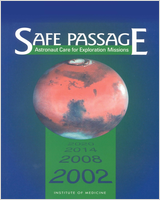
Safe Passage: Astronaut Care for Exploration Missions.
- Hardcopy Version at National Academies Press
2 Risks to Astronaut Health During Space Travel
…we must assume that for a long time to come (although not forever), weightlessness will be an obligatory condition of space flight. For this reason, all aspects of this issue must be considered from the point of view of the possibility of functioning in microgravity.
G.I.Meleshko, Y.Y.Shepelev, M.M.Averner, and T.Volk, 1994
Over the life of the U.S. space program, generations of astronauts have learned how to live and work in weightlessness. Humans evolved in gravity; how the body would function in its absence or near absence was an unanswered question. Would it be possible to eat and drink in microgravity? Would it be possible to perform complex tasks? The early answers were affirmative. Thus, selected fit and healthy humans have been sent into space for three decades and have functioned well (Lane and Schoeller, 2000).
Although humans have adapted to weightlessness, readapting to Earth's gravity is problematic. Exposure to microgravity affects the body in many ways. Some effects are severe and long lasting, such as loss of bone mineral density. Others are minor and temporary, such as facial puffiness due to fluid shifts (Nicogossian et al., in press). It is unlikely that all effects of microgravity are known, and surprises may yet be in store as humans venture longer and farther into space. This chapter is about human physiological adaptation to space travel. In it, the Institute of Medicine (IOM) Committee on Creating a Vision for Space Medicine During Travel Beyond Earth Orbit examines what is known about the effects of microgravity and space travel on the human body. This is the starting point for generating priorities in clinical research and health care for space travel beyond Earth orbit.
In developing this chapter, the committee has relied heavily on briefings and published information from the study's sponsor, published scientific articles, and two recent National Research Council (NRC) reports. The first report, A Strategy for Research in Space Biology and Medicine in the New Century (SSB and NRC, 1998a), provided a science-based assessment of the most important biomedical research topics in 1998 to be pursued over the next decade. The second report, Review of NASA's Biomedical Research Program (SSB and NRC, 2000), examined the National Aeronautics and Space Administration's (NASA's) biomedical research enterprise 2 years later and measured it against the plan set forth in the earlier report. The IOM committee endorses the findings and recommendations of both NRC reports.
The current report extends the vision of the two previous NRC reports to clinical research and clinical care in space. This chapter responds to the portion of NASA's charge to the IOM committee to “conduct an independent assessment of the current status of scientific knowledge” relevant to providing optimal health care for astronauts traveling beyond Earth orbit. In so doing, the chapter describes the effects of weightlessness and space travel on the physiology and functioning of the human body. It discusses the evidence on which the findings are based, the steps that need to be taken, and the research challenges and opportunities that lie ahead.
Most of what is known about the effects of microgravity on the human body has been learned on short missions into space. NASA is now looking ahead to longer-duration space missions, initially in Earth orbit and later into deep space. Over the next decade, a number of astronauts will have 3-to 6-month tours of duty aboard the International Space Station (ISS). These may be followed by extended stays on the Moon or exploration-class missions to Mars, or both. Before the United States and its international space partners commit to any such plans, however, there needs to be a better and fuller understanding of the risks to astronaut well-being and the safety of long-duration space travel in and beyond Earth orbit.
The chapter presents numerous examples of the effects of exposure to microgravity and space travel on human physiology ( Box 2–1 ). The examples are by no means exhaustive, however. The material in this chapter is arranged by organ system, with those for which the physiological effects are best documented presented first. The chapter also includes a discussion of future methods for the monitoring of astronauts' health status—an important aspect of detecting, understanding, and countering the untoward physiological changes that may affect astronaut well-being and mission performance.
BOX 2–1
Some Major Human Physiological Changes Resulting from Extended Travel in Earth Orbit. Musculoskeletal System Loss of bone mineral density
Finally, the chapter includes a discussion of the comprehensive, long-range approach to clinical research that NASA needs to consider implementing to best protect human health and safety during long-duration space travel. Historically, NASA has faced difficulty in conducting clinical research in space medicine. One problem is the small numbers of research subjects (astronauts) available for study. The overriding reason, however, is that microgravity cannot be duplicated on Earth; it can only be approximated. The terrestrial means of research on bone mineral density loss in microgravity are bed rest, immersion in water, or immobilization. All have their own disadvantages. The opening era of the permanent presence of humans in Earth orbit on the ISS in October 2000, however, provides an enduring test bed that will eventually help provide an understanding of human physiology in microgravity.
Countermeasures to Solve Physiological Adaptations to Space
Faced with the necessity to maintain astronauts' health during periods of exposure to microgravity and other extreme conditions of spaceflight, NASA has pursued the development of preventive and counteracting measures (i.e., countermeasures) to guard against or reverse the potential pathophysiological effects of space travel. A variety of countermeasures have been used in longer-duration spaceflights (Mikhailov et al., 1984; Bungo et al., 1985; Greenleaf et al., 1989; Fortney, 1991; Arbeille et al., 1992; Cavanagh et al., 1992; Charles and Lathers, 1994; Hargens, 1994; Convertino, 1996b). The American and Russian space programs use different strategies. Some examples of countermeasures that had been developed as of 2000 include subcutaneous injections of erythropoietin to prevent decreases in erythrocyte mass and vigorous in-flight exercise regimens to reduce loss of bone mineral density. So far, countermeasures appear to be largely ineffective, but the data are sparse (Bungo et al., 1985; Buckey et al., 1996b; Convertino et al., 1997; Lane and Schoeller, 2000).
NASA's general approach to the development of countermeasures was presented to the IOM committee at the Johnson Space Center (Paloski, 2000; Sawin, 2000). The rationale ( Figure 2–1 ) outlined a number of steps that have been incorporated into NASA's Countermeasure Evaluation and Validation Project, which can be summarized as follows:
FIGURE 2–1
Countermeasure (CM) evolution. Source: Paloski, 2000.
conduct research to understand the basic nature of the physiological problem,
formulate a countermeasure strategy based upon that physiological understanding,
test the countermeasure and demonstrate its efficacy on the ground, and
validate the countermeasure in space.
It has been difficult for NASA to design and test effective countermeasures, and no single countermeasure has yet to be validated as clinically efficacious. The potential for better design and evaluation of countermeasures improved dramatically on October 30, 2000, with the arrival of the first multinational astronaut crew to inhabit space as residents on the ISS. The ISS offers NASA and its international partners a longer-term orbiting clinical research laboratory in microgravity to investigate—and ultimately prevent—the adverse changes in human physiology described in the pages that follow. To assume that a terrestrial model duplicates the physiological effects of microgravity is a logical flaw that could lead to reliance on ineffective countermeasures. The plan outlined by NASA therefore demands that a significant amount of physiological research be conducted on the ISS and immediately following long-duration space missions on the ISS. The amount of research required, the duration of the research, and the extensive nature of the research will have to be considered in the planning phases of ISS missions.
This chapter also discusses new and future methods for the diagnosis and monitoring of astronaut health status in space and NASA's health risk assessment and management process that includes countermeasure development. The chapter concludes with a discussion of the comprehensive long-range approach to clinical research that NASA needs to consider to prepare for successful long-duration missions with humans beyond Earth orbit.
- MUSCULOSKELETAL SYSTEM
Loss of Bone Mineral Density in Microgravity
Changes in bone mineral density, muscle mass, and muscle function are the best-documented physiological effects of human space travel. The loss of bone mineral density in microgravity is well documented (Vico et al., 2000). Serious acute consequences of bone mineral density loss (i.e., fracture and the formation of renal stones) as well as long-term morbidity may complicate long-duration space travel beyond Earth orbit. Working in microgravity within a spacecraft, during extravehicular activity, and upon a low-gravity moon or planet presents many increased risks for bone fracture and the necessity for wound healing. From a practical viewpoint, virtually nothing is known about how microgravity will affect fracture management and healing during long-duration space missions. For example, is it better to cast, internally fixate, externally fixate, or electrically stimulate a fracture sustained on Mars? The committee was unable to locate data from studies with animals or humans or from basic, translational, or clinical studies on these clinical treatments issues; but knowledge about such clinical treatments issues will be important to sustain human health and performance should a bone fracture occur during space travel beyond Earth orbit.
At the basic science level, little is known about the fundamental mechanisms underlying the loss of bone mineral density in microgravity; hence, scant progress has been made on the development of effective countermeasures. This must be an extremely high priority before long-duration space travel can be deemed reasonably safe with regard to the risk of fractures, the associated increased risk of renal stones, and basic skeletal support.
Small numbers of subjects and, in many cases, incomplete data have hindered clinical studies, resulting in a lack of reliable databases (SSB and NRC 1998b; Lane et al., 1999; Lane and Schoeller, 2000). Thus, it is difficult, if not impossible, to generate reliable conclusions that can be applied to individual astronauts. A recent review (Smith et al., 1999) focusing on calcium metabolism after a 3-month space mission showed an approximately 50 percent increase in the level of calcium absorption accompanied by a 50 percent increase in the levels of both calcium excretion and bone resorption, as determined by calcium kinetics and bone marker analyses, respectively. Subjects lost approximately 250 milligrams of bone calcium per day during space travel in Earth orbit and appeared to regain it at a slower rate after their return to Earth. There is a suggestion from limited studies of bone density markers in serum and urine, which are used to approximate the relative rates of bone formation in relation to rates of bone resorption, that an uncoupling of the two processes led to an imbalance, with bone resorption predominating (Caillot-Augusseau et al., 1998). Again, because of the small numbers of subjects, this conclusion cannot be generalized and may not be applicable to all astronauts.
As shown in Table 2–1 , mainly weight-bearing bones (spine, neck, femur, trochanter, and pelvis) lost bone mineral density during space missions in Earth orbit: on average, greater than 1 percent per month for cosmonauts on the Russian Mir space station. In contrast, there was no significant loss from bones in the upper extremity (arm).
TABLE 2–1
Average Bone Mineral Density Loss on Mir .
Additional measurements ( n =40) that include shorter-term (<3 weeks) U.S. space shuttle flights show that loss of bone mineral density begins within a few days and continues for the longest period measured (1 year) without showing signs of leveling off. It is noteworthy that the standard deviations in all studies are high, which may indicate wide variations in the responses of individuals. This suggests that there may be substantial phenotypic (and presumably genotypic) variations in susceptibility to microgravity-induced bone mineral density loss. If shown to be true, this concept would have important implications for the selection of crewmembers for long-duration missions (e.g., are menopausal female astronauts or specific male or female astronauts phenotypically at greatly enhanced risk?).
The collection and analysis of clinical data for a comprehensive database to determine whether individuals with phenotypes that make them “resistant” to and “at risk” for space travel-induced bone mineral density loss exist represent but one set of important challenges for NASA that has been identified. Understanding these patterns in relation to basic patterns of up-and downregulation of gene arrays as a result of exposure to microgravity could lead to the development of specific interventions to prevent microgravity-induced bone mineral density loss.
Associated with the bone mineral density loss is a rather consistent hypercalciuria, which increases the risk of formation of renal stones (Schneider et al., 1994). Importantly, this limits pharmacological options such as treatment with normal dietary supplements (e.g., calcium and vitamin D).
Reversibility, Genetic Variability, and Mechanism of Bone Mineral Density Loss
Although data are limited, it appears that changes in calcium metabolism and bone mineral density are reversible. There are suggestions, however, that reversal of the changes is slower than their evolution and that the rate and extent of reversal are highly variable (Vico et al., 2000). A mission to Mars, for example, would involve a period of low or nearly zero gravity during space travel, a second period of time in gravity well lower than that on Earth while the expedition was on the surface of Mars, a third period of time again spent in low gravity during the return flight, and the ultimate return to Earth's gravity. How these sequential changes in gravity loading will influence bone mineral density loss is unknown. It is possible that they may exacerbate and accelerate the incidence of Earth-based diseases such as osteoporosis. As such, it may be appropriate to consider terrestrial referenced 6- and 9-year windows of disease incidence instead of the disease incidence for a 3-year period.
Limitations in data collection and analysis, the small sizes of databases, the lack of precise bone mineral density measurements (which have a 1 to 2 percent coefficient of variation), and the very high natural variations of markers of bone mineral density turnover all contribute to the difficulty of obtaining reliable data that would be useful for clinical decision making for space travel. Therefore, the most reliable and efficient clinical studies must probably use individual astronauts as their own controls. The etiology of bone mineral density loss is multifactorial and likely polygenic, like most common diseases. The basis for or the implications of individual variability is not known, further complicating interpretation of the limited clinical data. Long-duration space missions in Earth orbit offer the opportunity to obtain crucial data by careful clinical research. These data could then be used to generate hypotheses and to guide measures to protect subsequent astronauts from unnecessary morbidity and even death.
Additional factors that may affect the relative risk of bone mineral density loss during space missions are bone mass as measured by bone densitometry and bone turnover rates as measured by markers of bone density in serum and urine determined before the initiation of a space mission. Although the selection of astronauts with higher bone masses may not prevent bone mineral density loss, it may prevent the consequences of decreased bone mineral density; that is, bones with higher mineral densities may be at decreased risk of fracture. Thus, because of unknown genetic components and the variability among astronauts with regard to the rate of bone mineral density loss, it might be increasingly important to identify individuals whose bodies are able to resist bone mineral density loss on prolonged space missions (Vico et al., 2000). This can be accomplished only by extensive premission, intramission, and postmission analyses of bone mineral density and markers of bone mineral density turnover in serum. It may be possible to identify individuals who are less prone to the effects of microgravity on bone mineral metabolism and bone mineral density loss. This knowledge not only might have implications for space travel, but it also may well provide important information about diseases such as osteoporosis.
A number of animal models, including models of unloading, have been used to simulate weightlessness (SSB and NRC, 1998a; Lane and Schoeller, 2000). It is unknown whether such models reflect the physiology of humans during space travel. Rats have been used in microgravity experiments, but the results of those experiments may be of limited value given the poor correlation between rat bone metabolism and the bone architecture in humans (SSB and NRC, 1998a, 2000). The development of land-based animal models for investigation of the pathophysiology and pharmacotherapeutics of bone mineral density loss during space missions beyond Earth orbit will require more knowledge of bone mineral density loss in humans. Although the advantage of using experimental and natural animal models, for example, hibernating bears (Harlow et al., 2001), is evident—in that it allows more focused investigation into basic molecular and cellular mechanisms—successes from the study or development of such models will likely lag behind the need to test the effectiveness of therapeutic interventions in humans during space missions beyond Earth orbit. The use of immobilized human subjects on Earth as models may have its place. However, the high priority for the evaluation of the effectiveness of countermeasures in the microgravity environment renders such models less valuable in the short term.
The technology for the accurate testing of bone mineral density is improving and is becoming increasingly miniaturized. It will probably become necessary to assess bone mineral density changes during space missions both in and beyond Earth orbit with reasonable precision for clinical research purposes. It is anticipated that this technology will be useful in assessments of the need for and testing of the effectiveness of specific interventions during space travel. In addition, it is anticipated that better documentation of the validity of bone mineral density markers in evaluations of the mechanisms of bone mineral density loss would also provide a means for optimization of highly targeted interventions. Therefore, the development of a means to measure such markers in the long-duration space mission environment should be a high priority in conjunction with an aggressive NASA countermeasure research program. Better measures of bone integrity, for example, three-dimensional assessments, not just bone mineral density, are also needed. Ultimately, intramission tests should be the indicators that guide specific therapies.
Clinical Research Opportunities in Astronaut Physiology and Health
Clinical Research Opportunity 1. Establishing the course of changes in bone mineral density and markers of bone mineral density turnover in serum and urine before, during, and after space travel.
Clinical Research Opportunity 2. Developing a capacity for real-time measurement of bone mineral density and enhanced three-dimensional technology to assess the risk of fracture during space travel.
Because of the significant current research effort into the prevention and treatment of osteoporosis, new techniques that better assess bone mineral density turnover and fracture susceptibility can be anticipated within the next decade. These techniques should be evaluated, adapted if necessary, and incorporated into NASA's clinical research program.
Clinical Research Opportunity 3. Identifying human phenotypes and genotypes resistant to space travel-induced bone mineral density loss.
This may involve analysis of both data from large phenotypic databases and genetic factors as they become available. Recent data suggest a wide spectrum in both the level of acute bone mineral density loss and return to normal bone density upon the return to Earth (Vico et al., 2000).
Clinical Research Opportunity 4. Tailoring therapeutic interventions (i.e., countermeasures such as diet, exercise, and medications) as a high priority and then validating the promising countermeasures in studies with astronauts during exposure to microgravity.
Pharmacological countermeasures deserve special emphasis. They may need to be tailored to an individual's response, and ongoing monitoring of effectiveness may be required during long-duration space travel beyond Earth orbit. For most of the clinical studies, astronauts must be their own controls, which again requires the ability to conduct comprehensive analyses of bone-related metabolic parameters during space travel.
Effects of Microgravity on Skeletal Muscle
During space travel, the primary effects of microgravity on skeletal muscles include the deterioration caused by the lack of gravity on slow-twitch muscles, with conversion from slow to fast muscle fiber type; and decreased fiber size in rats (Riley et al., 1990; Jennings and Bagian, 1996). Young rats subjected to 18 days of hind-limb unloading developed an abnormal gait that persisted, suggesting permanent damage to the neuromuscular pathway (Walton et al., 1997). Significant atrophy has been observed in human muscle after only 5 days in space, but the time course of deterioration has not been established. Moreover, it is not known when or whether a plateau might be reached. In addition, the foot-drop posture in microgravity shortens the extensor compartment and appears to accelerate loss of the thick filament (Edgerton et al., 1995).
Most of these primary changes to skeletal muscle during space travel appear to represent simple deconditioning without apparent pathology and can be considered appropriate adaptations for functioning in a low-workload microgravity environment. However, an abrupt return to gravity imposes high workloads on weakened muscles and post-space travel pathologies: muscle fatigue, weakness, incoordination, and delayed-onset muscle soreness. In rats, changes in microcirculation occur during space travel as a result of the cephalad fluid shift, and reloading-induced edema and ischemic tissue necrosis may occur upon the return to Earth's gravity (Riley et al., 1996). In addition, adaptation to the lower workload in microgravity may render muscle tissue more prone to structural failure when it is reloaded.
A variety of exercise-based protocols have been used, but none have been adequately validated and none have proved to be more than modestly effective. Cycle ergometry has successfully been used to ameliorate cardiovascular aerobic deconditioning but did not prevent muscle deterioration. However, bicycle ergometry and treadmill exercises counteract the tendency to attain the foot-drop posture in microgravity that shortens the extensor range and that appears to contribute to accelerated loss of the thick filament (Edgerton et al., 1995; Widrick and Fitts, 1997).
The Task Force on Countermeasures: Final Report (NASA, 1997) concluded that existing cycling, rowing, and treadmill exercise protocols did not maintain muscle mass or a positive nitrogen balance. A significant contributing factor to this loss of muscle protein may be inadequate nutrition during space travel. To correct this, lower-body negative pressure coupled with resistance exercises should be tested as a means of maintaining the microcirculation and muscle strength (Koslovskaya et al., 1990). NASA funded a lower-body negative-pressure investigation in 1999 to study a countermeasure that uses developments in advanced technology. In addition, the possibility of pharmacological intervention apparently has not been explored, and better monitoring and recording of the history of muscle use and condition (e.g., specific exercise and nutrition history) during space travel need to be established to reduce uncontrolled parameters.
- CIRCULATORY AND PULMONARY SYSTEMS
Orthostatic Hypotension
The single most significant problem associated with the cardiovascular and pulmonary systems as a consequence of microgravity appears to be orthostatic hypotension, a fall in blood pressure and the associated dizziness, syncope, and blurred vision that can occur when one stands up or simply stands motionless in one position. In the context of space travel, a major cause of orthostatic hypotension is the persistent lowering of peripheral vascular resistance during space travel, and more than two-thirds of all astronauts experience orthostatic hypotension when they reenter Earth's gravity (Buckey et al., 1996a,b). In other words, orthostatic hypotension is a physiological adaptation to microgravity that readapts after exposure to gravity. Resetting of the baroreceptor reflex occurs over a period of several days, depending upon the individual, the duration of space travel, and the individual's fluid status (Fritsch-Yelle et al., 1994). Symptoms can be uncomfortable or annoying, or both, but life-threatening complications have not been reported.
It is generally accepted that there is at least a general relationship between the duration of exposure to microgravity and the duration of the period of recovery from the orthostatic hypotension. However, few data are available concerning the severity of orthostatic hypotension, and the available information concerning the relationship between the duration of exposure to microgravity and the degree and duration of orthostatic hypotension is inadequate. No information is yet available on how orthostatic hypotension might be affected by the 0.4G gravity on Mars compared with how it is affected by the 1G gravity on Earth. It seems reasonable to assume, however, that on an exploration-class mission to Mars, orthostatic hypotension would represent a major problem if emergency procedures were to require the crew to move about immediately after landing.
Clinical Research Opportunity 5. Considering artificial gravity and pharmacological interventions as solutions to orthostatic hypotension.
Other Effects on the Cardiovascular System
The cardiovascular system undergoes several other physiological adaptations to microgravity. During weightlessness, there is a loss of hydrostatic pressure, especially in the lower extremities. Fluid shifts from extravascular to intravascular spaces and toward the upper part of the body (Thornton et al., 1987; Leach et al, 1996). This provokes objective and subjective symptoms, especially in the first days of space travel. The baroreceptors in the carotid arch sense a relative central hypervolemia and induce neurohormonal mechanisms that lead to diuresis and hypovolemia. Central venous pressure drops from the normal range of 7 to 10 mm Hg to 0 to 2 mm Hg (Kirsch et al., 1984; Buckey et al., 1996a).
The prolonged reduction in central venous pressure during exposure to microgravity resets the baroreceptors to a lower operating point; this in turn limits plasma volume expansion during attempts to increase fluid intake. Ground-based and in-flight experiments have demonstrated that restoration and maintenance of plasma volume before the return to Earth's gravity and an upright posture may return the central venous pressure to normal levels and reset the baroreceptor reflex (Convertino, 1996a). Microgravity also produces a decrease in renal and femoral vascular resistance, with maintenance of cerebral flow at rest. During orthostatic testing, lower-limb vascular resistance does not compensate for the fluid shift (Arbeille et al., 1996).
The changes in intravascular volume during space travel lead to corresponding changes in stroke volume and cardiac output. For example, corresponding decreases in stroke volume and cardiac output have been observed over a range of atrial pressures. Echocardiographic experiments performed during space shuttle flights showed an average decrease in stroke volume of 15 percent, measured after a period of 3 days of adaptation to weightlessness (Pantalos et al., 1998). The heart rate is generally unchanged. Thus, although the cardiovascular system demonstrates many changes during space travel, to date few have appeared to be severe enough to affect human health or performance during space travel. NASA has, however, identified potentially serious cardiac dysrhythmias, impaired cardiovascular responses to orthostatic stress, diminished cardiac function, manifestation of previously asymptomatic cardiovascular disease, and impaired cardiovascular responses to exercise (Levine et al., 1996) as potentially serious risks during space travel (see Table 2–2 later in this chapter).
TABLE 2–2
Critical Path Roadmap Project: Critical Risks. SOURCE: Charles, 2000.
These alterations in cardiac function could also present serious risks to astronaut health during long-duration space travel. However, the incidence and the severity of the dysfunction in each of these categories during short-and long-duration space missions are unknown. Currently available data (SSB and NRC, 1998c, 2000) have not been critically peer reviewed and do not convince the committee that cardiovascular risks should be labeled “serious” at this time. Substantial new research is required to define the degree of risk, the likelihood and severity of cardiac alteration, and reasonable therapeutic options for long-duration space travel.
Effects of Microgravity on the Pulmonary System
Thus far, no significant problems have been identified on the basis of the observed changes in pulmonary physiology in microgravity. Reported observations include a change in the pattern of ventilation in microgravity that results in decreased tidal volume and an increased frequency of ventilation (Prisk et al., 1995b, West et al., 1997). There is decreased dead space with normal oxygen uptake and an improved carbon dioxide diffusion capacity (Prisk et al., 1995a,b). The overall improvement in lung function cannot be completely explained by what had been supposed to be gravity-induced ventilation/perfusion ratio inequalities, raising fundamental questions about normal gas exchange physiology (Prisk et al., 1993, 1995a; Lauzon et al., 1998). Two potential risks to pulmonary function are dysbarism and a patent foramen ovale, although the latter is really a potential end risk to the nervous system. NASA is aware of these potential risks to astronaut health and is actively investigating what measures, if any, are needed to decrease the risks.
- ALIMENTARY SYSTEM
Nutrition in Space
NASA has conducted extensive research on nutrition issues pertaining to spaceflight and has conducted such studies in collaboration with academic specialists (Lane and Schoeller, 2000). Despite 35 years of nutrition research, however, weight loss, dehydration, and reduced appetite continue to challenge NASA food scientists (Lane and Schoeller, 2000).
Space Motion Sickness
One of the most common conditions requiring pharmacological treatment in a microgravity environment is space motion sickness (SMS) (Putcha et al., 1999). SMS is a syndrome consisting of headache, malaise, disorientation, nausea, or vomiting. Putcha and colleagues (1999) reported that 47 percent of unit doses of medication given during space missions were for the treatment of SMS. These usually consisted of promethazine with or without dextroamphetamine, although the frequency of drug administration and the routes of administration were not reported.
The etiology of SMS is not known, although fluid redistribution (Simanonok and Charles, 1994) and alterations in bowel motility (Harris et al., 1997) are factors that have been implicated. Although SMS is largely considered a “minor” disorder, its effects are serious enough that extravehicular activity is prohibited during the first 3 days of a mission to avoid the possibility of vomiting and aspiration into the space suit (Simanonok and Charles, 1994). Given the high frequency of occurrence of SMS, its ability to affect an astronaut's function, and the high frequency of use of medication with potential adverse effects that affect function, SMS is an area for clinical investigation on longer ISS missions.
Many astronauts who develop symptoms of SMS also seem to develop a transient gastrointestinal ileus, diagnosed by an absence of bowel sounds. Although motility may remain decreased throughout flight and bacterial populations may change, data from short-term spaceflights do not suggest that this leads to significant medical problems (Lane and Schoeller, 2000). The etiology is unclear. Microgravity-induced movement of the abdominal contents within the abdominal cavity, simulating a surgical ileus, may be responsible. Another possibility is neurohumoral mediation.
Individuals who lack bowel sounds during the first 48 hours in space and who attempt to ingest food will often vomit, just as postoperative patients do. The simplest and most effective treatment appears to be patience. Those individuals who wait until they adjust to zero gravity and develop audible bowel sounds before they ingest solid food seem to do well. Most crewmembers on spaceflights resolve the ileus spontaneously within 48 hours, and adequate hydration should be maintained during that time, particularly if there is no intake of solid food. This gastrointestinal problem appears to be self-limiting, and overtreatment with laxatives may cause diarrhea, which can be a difficult problem to deal with in the space environment. No additional predictable problems with ileus would be expected on long-term spaceflights. Valuable information may be gathered from astronauts with extended stays on the ISS, and further clinical data may be obtained from studies investigating the etiology of SMS.
Clinical Research Opportunity 6. Investigating the relationship between space motion sickness and absent bowel sounds including pharmacological and adaptive countermeasures.
- NERVOUS SYSTEM
Useful data on neurovestibular function, sleep (circadian rhythms), eyehand coordination, fine and gross motor functions, and visual perception and reorientation have been collected in real-time, post-space travel studies and from studies with animals. However, little or no readily accessible data are available on sensation and proprioception. Some data are available, however, from isolated and confining analog situations describing predictors of behavior during long-duration missions (Palinkas et al., 1998).
Neurovestibular Function
Several studies have been performed to assess the effects of microgravity, nonvertical positioning, and simulated gravitational environments (short-arm centrifuge) on the neurovestibular system. These studies have focused on the adaptation to—and the relationship between—the visual system and body position during travel in space (Cohen et al., 1995). Countermeasures have been designed to test the effects of the centrifuge apparatus or body tilt on postural stability and possibly orthostatic tolerance (Black et al., 1999). Disconjugate gaze occurs and persists for weeks after space travel (Markham and Diamond, 1999). Markham and Diamond discuss the use of medication (promethazine) for SMS, including its impact on alertness, the mechanism of delivery, and possible antidotes (amphetamines) for drowsiness. No results of controlled trials, dose-response trials, or comparative efficacy studies have been published. Recent NASA Neurolab studies, however, deemphasize the potential importance of overt neurovestibular disturbance during space travel.
Sleep and Circadian Rhythm
Evidence is accumulating that sleep is disrupted during space travel and that the circadian rhythm is disrupted ( Box 2–2 ). This may be mediated through the neurovestibular system. Data from Mir suggest that the duration of sleep is reduced, that sleep is not as deep, and that in other ways sleep may be physiologically different from the sleep experienced on Earth (Putcha et al., 1999). Possible explanations include the low levels of light in the spacecraft, changes in light-dark cycles, and the misalignment of work-rest shifts with light cycles.
BOX 2–2
Altered Sleep Patterns as Example of Multifactorial Problems Arising During Space Travel. Impairment of normal sleep patterns can erode cognitive performance and vigilance during spaceflight (Berry, 1969). Astronauts experience sleep disruption, as shown (more...)
Long-duration space travel may produce even more aberrant sleep disruptions and associated abnormalities. These can result from disruption of the hypothalamic-pituitary axis, with the resultant release of growth hormone, and changes in cortisol peaks and valleys. Disruptions of the circadian rhythm may result in abnormal stress responses, diminished performance because of fatigue, and mood and behavioral changes (Mullington et al., 1996). Although astronauts frequently use sleep medication, it has been only modestly effective in correcting the insomnia. Use of melatonin as a possible countermeasure has been discussed, but assessment of effective medication for sleep has not been undertaken in a methodical way. Electroencephalographic changes have been recorded with prolonged wake-fulness, and these correlate with neurobehavioral performance capability (Dijk et al., 1992; Dinges et al., 1997).
Clinical Research Opportunity 7. Building a coordinated clinical research program that addresses the issues of neurological safety and care for astronauts during long-duration space travel.
Clinical Research Opportunity 8. Performing pharmacological trials with dose-response and pharmacokinetic measures to assess the efficacies and toxicities of medications commonly used to treat sleep disturbances during space travel.
Clinical Research Opportunity 9. Considering clinical trials on the use of growth hormone and other countermeasures and developing devices to control ambient light and the core temperature at appropriate levels during space travel to reduce sleep disturbances.
Eye-Hand Coordination and Sustained Gross Motor Activity
There is evidence of the degradation of task performance over time during space travel (Manzey and Lorenz, 1998). The tasks studied have included fine motor function, eye-hand coordination (including documentation of the inability to pilot a vehicle for days after landing from short flights), and gross motor activity, especially extravehicular activity. Explanations for this deterioration of performance include difficulty in vigilance, sensory input diminution, and changes in visual acuity (Billica, 2000; Marshburn, 2000a). Neurological recovery of balance and mobility requires 1 to 3 days after short space missions and 10 to 30 days after longer missions.
Few data that can shed light on the causes of these observations are available. Astronauts commonly complain of sluggishness, impaired cognition, and disorientation. In fact, the most frequently identified symptom during space travel is fatigue or asthenia. Some of this may be related to sleep-circadian rhythm disturbance; some of it may have to do with the functioning of the stimuli from the peripheral to the central nervous system. An important issue is sustained performance during long-duration missions in space. Pharmacological countermeasures have addressed sleep but not vigilance or performance-enhancing strategies. Shift assignments have been used to provide more autonomy and more rest and relaxation, with some success. Concerns remain about the possible sequelae of changes in visual acuity, vigilance, balance, and muscular function.
- PERIPHERAL NERVOUS SYSTEM
Published reports and presentations to the committee made little mention of sensorimotor status during or upon the return from space missions, yet sensorimotor status is an important component of muscle activation. The lack of stimulation may be contributing to the decreased muscle mass and possibly the asthenia and fatigue that occur during spaceflight. Devices that stimulate sensory input (vibrators, pneumatic pumps) could be studied to better understand the role that sensorimotor status might play in muscle activity.
Because nervous system health is important to crew health and mission success, data could be collected from studies on the ISS on the efficacies of pharmacological agents in improving nervous system performance. Systematic study of sensorimotor status in microgravity is important to understanding the contributions of neurological and behavioral factors to human performance in deep space.
- REPRODUCTIVE SYSTEM
The committee was unable to find many data on the effects of microgravity on the reproductive system. This is understandable, given that space missions thus far have been of relatively short duration. As the lengths of missions are extended, however, and outposts in the solar system occupied by humans become a possibility, the study of the effects of space travel on human reproductive physiology, the risks associated with exposure of the gametes to radiation, and the study of reproduction in space are warranted.
Effects of Radiation on Gametes
Effects on male gametes.
Spermatogonia are among the most radiosensitive cells in the body. Exposure to radiation at levels as low as 10 REM (roentgen equivalent in man) has been known to cause reduced levels of sperm production (ICRP, 1969), and exposure to levels of 50 REM may cause temporary sterility. A single exposure sufficient to produce permanent azospermia would be fatal to the individual. Exposure to a lower dose of radiation over a protracted period of time, however, would not be lethal but could produce sterility (Jennings and Santy, 1990). Although infertility is an important issue, the long-term genetic consequences of exposure of the gonads to radiation are of greater concern to many.
Effects on Female Gametes
Unlike the testis, which constantly replaces spermatogonia, the ovary has a fixed supply of oocytes that have been present since birth. Because the oocytes do not actively undergo mitotic division and since they possess effective enzymatic repair systems, the ovary is more resistant to radiation-induced genetic effects; however, the effect of radiation on oocytes is cumulative. A single dose of 300 to 400 rads has been sufficient to eliminate oocytes from the ovaries as well as estrogen production. When the exposure is fractionated, there is increased tolerance over a single dose, and primary oocytes show a degree of recovery from the accumulated radiation damage (ICRP, 1969). Assessment of the effects of space travel on the reproductive endocrine system and on ovulatory function should be ongoing, and NASA should consider offering preflight gamete cryopreservation for men and women who may wish to reproduce after a long-duration space mission.
Clinical Research Opportunity 10. Determining whether radiation exposure during space travel causes genetic damage or altered fertility in men and women and, for women, premature ovarian failure.
Human Reproductive Physiology in Space
Male reproductive physiology.
Although little is known about the effects of space travel on the hypophyseal-pituitary-gonadal axis, some evidence for reversible testicular dysfunction has been found. Reductions in testosterone levels have been reported during flight and postflight in both rats and humans (Plakhuta-Plakutina, 1977; Tigranjan et al., 1982; Deaver et al., 1992). Since testosterone secretion by the Leydig cells in the testis is stimulated by luteinizing hormone, a decrease in testosterone levels may indicate a disturbance in the hypophyseal-pituitary-gonadal axis. If this is the case, one might expect abnormalities of germinal epithelial function and, thus, diminished sperm production as well.
Clinical Research Opportunity 11. Determining female and male reproductive hormone levels during space travel.
Female Reproductive Physiology
At birth, women possess all the gametes that they will ever have. Thus, as women age, so do their gametes, and advanced oocyte age is associated with infertility. Many women, including women who are astronauts, delay childbearing until after they have completed their education and have achieved some of their career objectives. The average age of women selected into an astronaut class is 32 years, and many have not had children. Of 99 female finalist candidates examined during five selection cycles between 1989 and 1997, only 18 had been pregnant. Once they are admitted into the space program, given the constraints of training on a pregnancy, female astronauts commonly further delay childbearing until after the completion of one or two spaceflights. As a result, female astronauts are often in their 40s when they attempt pregnancy (Jennings and Baker, 2000).
Retrograde menstrual flow is considered an etiologic factor in the development of endometriosis and consequent infertility (Sampson, 1927; Scott et al., 1953; Jennings and Baker, 2000). Many women experience some retrograde menstruation that, at Earth's gravity, is usually confined to the pelvis. However, in microgravity there is concern that the level of retrograde menstrual flow might be increased and that instead of being confined to the pelvis it would disperse throughout the abdominal cavity. Abdominal symptoms, shoulder pain, or an obvious reduction in the amount of menstrual flow has not been observed among women during spaceflights. However, retrograde menstrual flow has not been subjected to systematic study (Seddon et al., 1999).
Because of the short durations of space missions so far, coupled with the pulsatile nature of hormone secretion by the hypophyseal-pituitary-ovarian axis, the effect of space travel on ovulatory function has not been studied (Seddon et al., 1999; Strollo, 1999). The effects on the menstrual cycle of stress and exercise during space travel also have not been studied (Seddon et al., 1999). On Earth, stress and exercise can be associated with anovulation, and continuous estrogen exposure can be associated with endometrial hyperplasia and excessive vaginal bleeding. Alternatively, stress and excessive exercise can be associated with hypogonadotropic hypogonadism, resulting in reduced estrogen levels and amenorrhea. The latter condition is associated with decreased bone mineral density. The effect of microgravity, in addition to the effects of stress and an exercise program necessary to maintain cardiovascular and musculoskeletal well-being on long-duration flights, may increase the risk of developing one of these conditions. Exogenous hormone therapy in the form of oral contraceptives or some other therapy may be both preventive and therapeutic.
Clinical Research Opportunity 12. Determining the effect of microgravity on menstrual efflux and retrograde menstruation.
Sex Differences
The National Space Biomedical Research Institute held a workshop on sex-related issues in spaceflight research and health care in August 1999 (Seddon et al., 1999). Focusing on sex-related issues, the group reviewed existing demographics and epidemiological information, identified areas of needed research, and identified ways to accelerate research on the ground and in space to ensure the health of space crews and to provide the best medical care to diverse crewmembers.
The report from the workshop indicates that in most areas there are insufficient data from which to draw valid conclusions about sex-specific differences in physiological responses among astronauts. One of the reasons for the lack of data is the relatively small female astronaut population compared with the size of the male astronaut population, which precludes performance of a study with sufficient statistical power for adequate analyses. In addition, in many areas, the individual differences in physiological responses among members of the same sex are as great or greater than those among individuals of different sexes. This adds to the difficulty in doing the analysis, which occurs in many areas of research involving astronaut health because of the small sample sizes. This is an important research problem in clinical trials with small numbers of participants, such as those involving astronauts (IOM, 2001e).
Other than orthostatic hypotension after space shuttle missions, in which women have a greater likelihood of presyncope during postmission “stand” tests than men (Fritsch-Yelle et al., 1996), the workshop panel members identified few areas in which there were differences by sex. The report points out that there are no data for several systems (postmenopausal bone loss, iron intake, muscle strength, and endurance) in which one might expect sex differences to exist. The report lists other areas in which the prediction of sex differences is not possible and for which no data exist but that are worthy of study. These include susceptibility to decompression sickness, pharmacokinetics and pharmacodynamics, immune function, sensitivity to radiation, and psychosocial adaptation. These are important areas of concern that are also addressed elsewhere in this report.
In addition to identifying areas of concern for female astronaut health care, including pregnancy and the pharmacodynamics of oral contraceptives, the panel looked at issues dealing with the human-machine interface that may affect women during space travel. Apparently, existing equipment, including extravehicular activity suits and shuttle egress suits, and task design preclude some individuals from performing some tasks (Seddon et al., 1999). A stated goal described in the workshop report of Seddon and colleagues (1999) is assurance that all individuals selected to be astronauts are able to perform all tasks associated with the job, regardless of their size or sex. The panel asked that a firm commitment be made to achieving this goal. The present IOM committee supports that recommendation.
Clinical Research Opportunity 13. Collecting clinical data for both men and women when anatomically possible and physiologically sensible for all individuals in the space program and, on a regular basis, subjecting the data to analysis for sex-related differences.
- URINARY SYSTEM
Renal stone formation secondary to bone calcium mobilization and excretion in the urine are well-identified concerns of space travel, with an expected incidence of 0 to 5 percent. The effects of microgravity on the urinary system also include changes in urodynamics (unknown incidence) and urinary hesitancy (reported in seven cases). Significant changes in the pH of urine and in urine calcium and citrate levels increase the risk of renal stone formation.
Countermeasures for urinary problems are primarily oriented toward the prevention of nephrolithiasis through adequate hydration. The recommended daily fluid intake volume for astronauts during spaceflight is greater than 2.5 liters (Lane and Schoeller, 2000). Therefore, the availability of a more than adequate supply of water must be ensured so that crewmembers do not hesitate to drink adequate volumes of water to prevent the formation of renal calculi. This may necessitate daily monitoring of water consumption levels, as adequate in-mission treatment of calculi during extended missions may be impossible. As ultrasound devices become smaller, it is possible that an ultrasound or other imaging device will be standard medical equipment for all long-duration space missions. This would make it possible and desirable to perform intramission screening for nephrolithiasis to identify those requiring increased hydration levels to prevent the growth of calculi.
As effective countermeasures for the problem of bone mineral density loss in microgravity are developed, it must be ensured that the solutions to the problem do not result in significantly increased rates of renal stone formation secondary to alterations in calcium metabolism.
- PHYSIOLOGICAL MONITORING
NASA has recognized not only the need to measure various parameters to evaluate astronauts during space travel but also the need to store blood and urine for future analysis upon the return to Earth (SSB and NRC, 2000). Both are important requirements for the clinical research program for long-duration space travel. Because of the unique environmental stresses of space travel (gravity forces, radiation), when a new technology is developed, there must be an adequate lead time to test the new technology in the space environment. With the evolution of new technology, NASA will continually be challenged to evaluate the newest methods and instruments in a microgravity environment. For example, the rapid application of nanotechnology, nonivasive biosenors, new imaging techniques, and informatics will provide diagnostic and treatment assessment capabilities vastly different from those available today. Validation of new technologies in the space medicine clinical research program and a transition to the routine application of those technologies in the space medicine clinical research program must be high priorities and continuous challenges for NASA.
Monitoring During Space Travel: Development of Technology
Priority should be given to the development of high-resolution, highprecision, yet minimally invasive or noninvasive methods for the monitoring of important physiological parameters and for biological imaging during all periods of space travel. Technologies are evolving rapidly and will dramatically alter monitoring capabilities during space missions. Technology may be used to minimize the intrusiveness of testing by developing means of obtaining transcutaneous measurements or substituting urine or saliva samples for blood samples. Examples of technologies under commercial development are noninvasive blood glucose monitoring kits and kits for the determination of complete blood counts. The application of nanotechnology to human fluid analysis, genomic analyses, and pharmacogenetics will also likely be routine aspects of future space travel. NASA's hosting of periodic international nanotechnology conferences to bring engineers and biologists together and the agency's collaborative initiative in cell biology with the National Cancer Institute are appropriate means of gaining wider expertise to understand and deal with methods that can be used to monitor risks to human health during future expeditions beyond Earth orbit.
Research Opportunity 14. Giving priority to high-resolution, high-precision, yet minimally invasive or noninvasive methods for the monitoring of physiological parameters and for imaging of the human body during space travel.
- A STRATEGY FOR A SPACE MEDICINE CLINICAL RESEARCH PROGRAM
The Critical Path Roadmap project is NASA's integrated, cross-disciplinary strategy to assess, understand, mitigate, and manage the risks associated with long-term exposure to the space environment. Initiated during 1997 and 1998, it is an iterative approach of review, analysis, and deliberations among intramural and extramural investigators focused on a worst-case scenario: long-duration, highly autonomous interplanetary missions such as a human expedition to Mars. The project consists of seven elements (risks, risk factors, critical questions, risk mitigation, the Critical Path Roadmap project, requirements, and deliverables [countermeasures]), as illustrated in Box 2–3 . Fifty-five risks have been identified and stratified ( Table 2–2 ). The goal is to identify and validate clinical interventions (countermeasures) for half of the risks by 2006 and for all of the risks by 2010 (Charles, 2000). Continuing revision of the Clinical Path Roadmap is available at http://criticalpath.jsc.nasa.gov .
BOX 2–3
Elements of the Critical Path Roadmap Project. ✓ Risks: Likelihood of an undesirable event occurring as a result of exposure to the space environment. Risk assessment includes the probability of the risk's occurrence, the severity of the consequences (more...)
Eleven discipline risk areas have been identified:
- advanced life support;
- environmental health;
- radiation effects;
- human performance;
- cardiovascular alterations;
- food and nutrition;
- muscle alterations and atrophy;
- immunology, infection, and hematology;
- neurovestibular adaptation; and
- space medicine.
These risk areas have been grouped into four categories:
- environmental and technological,
- human behavior and performance,
- human health and physiology, and
- medical care capabilities.
It is expected that clinical research will be an integral component in the successful prevention or mitigation of the risks to astronaut health in each of the discipline risk areas. The Critical Path Roadmap project, with its clinical research program on countermeasures, is NASA's mechanism for the development of priorities and validation of the means of mitigating the risks that humans may be expected to encounter during exploration-class missions into deep space. As a mechanism for gathering information, the Critical Path Roadmap project is an appropriate model for clinical research in space medicine, with use of the ISS as the critical platform for clinical research in space medicine and for NASA to validate countermeasures in the space travel environment as it prepares to go beyond Earth orbit ( Figure 2–2 ). NASA has, however, not integrated a prospective and continually reevaluated understanding of clinical research on astronaut health into the Critical Path Roadmap project in any of the information that it provided to the committee or that the committee was able to find. It should be noted that the environment on Mars, at 0.4G and with some atmosphere, is different from that of the spacecraft. Whether the presence of significant gravitational pull will tend to ameliorate the adverse effects of microgravity is unknown but is worth consideration in the planning of research.
FIGURE 2–2
Countermeasure (CM) development and evolution. Sources: Feiveson, 2000; IOM, 2001e.
A Clinical Research Program for NASA
IOM has conducted a number of studies focused on various aspects of clinical research (IOM, 1998, 1999a, 2001c,d,e). Although there are many definitions of clinical research (IOM, 1994), IOM recently endorsed the broad definition of clinical research set forth by the Graelyn Conference and National Clinical Research Summit ( Box 2–4 ) and formed the Clinical Research Roundtable to periodically discuss continuing developments and needs in clinical research.
BOX 2–4
What Constitutes Clinical Research? Clinical research embraces a continuum of studies involving interaction with patients, diagnostic clinical materials or data, or populations in any of these categories: disease mechanisms; translational research; clinical (more...)
The varied, significant, and potentially harmful changes in physiology associated with space travel require health care interventions to protect the well-beings of the participating astronauts and the integrity of the mission. However, traditional clinical research with astronauts is difficult because of the small number of participants available for study, the inability to replicate microgravity and its effects on Earth, restrictions on the use of control groups, and limitations on the substitution of results from studies with animals.
A large portion of NASA's human clinical research to date has been in the form of countermeasure development and evaluation, and this research has been conducted through trials of single interventions directed at specific physiological changes. This largely precludes, however, the classic approach of comparing alternative treatments in clinical trials with adequate statistical power (adequate sample sizes for statistical analysis) to demonstrate safety and efficacy (IOM, 2001e). Individual variations in both physiological changes and responses make it even more difficult to evaluate results because of the small number of participants (i.e., astronauts). Because of these difficulties, NASA has had to select the most promising clinical intervention for its studies of countermeasures to avoid further dilution of its study group and possible ethical breaches.
In addition to this empirical approach, more basic research is sorely needed to define the mechanisms that produce the physiological changes that result from space travel, which, it is hoped, will improve the focus of countermeasure clinical trials. The present set of NASA priorities may account for the limited success of countermeasures to date. This does not imply deficiencies on the part of NASA researchers but recognizes the severe limitations under which they work.
Potential methods for improvement in clinical research with small numbers of participants are described in a recent IOM study report, sponsored by NASA, Small Clinical Trials: Issues and Challenges, which reviews study designs and statistical methods for determination of the validities and efficacies of studies with small numbers of participants (IOM, 2001e). NASA's request for the study is one example of the agency's attempt to reach out in new directions to better use the limited opportunities during space missions to conduct clinical research with astronauts.
Formation of the National Space Biomedical Research Institute and increased collaboration with the National Institutes of Health (e.g., the new initiative with the National Cancer Institute) are additional directions that will provide NASA with wider expertise.
It is not clear, however, how well clinical research design, strategies, and so forth fit into these initiatives, as clinical research with astronauts relevant to space medicine beyond Earth orbit, particularly validation of countermeasures, can largely be conducted only during space missions. There does not appear to be a clearly visible and transparent plan of who oversees, designs, reviews, and is responsible for this clinical research. NASA's organizational charts, lines of authority and responsibility, administration, and budgeting processes and its levels of accountability presented to the committee (in official NASA policy documents and during briefings by NASA officials throughout the committee's information-gathering process) describe a fragmented, nonuniform process of strategic planning and oversight that is insufficient to provide an effective means of understanding and mitigating the risks to human health from traveling in space.
A comprehensive strategic plan for the prevention and amelioration of the many potential risks to well-being during long-duration travel beyond Earth orbit and treatment of the conditions that result from those risks is vital to the future of space medicine. This requires an understanding of the relationship between human physiology and adaptation to space travel. It also requires a broad, evidence-based, collaborative, and coordinated clinical research effort to ensure that NASA has the ability to provide health care commensurate with the expectations of the medical community and society at the time of launch beyond Earth orbit. Some of the clinical research opportunities in space medicine are listed in Box 2–5 .
BOX 2–5
Clinical Research Opportunities for Astronaut Health. Musculoskeletal System Establishing the course of changes in bone mineral density and markers of bone mineral density turnover in serum and urine before, during, and after space travel.
- CONCLUSION AND RECOMMENDATION
NASA has devoted insufficient resources to developing and assessing the fundamental clinical information necessary for the safety of humans on long-duration missions beyond Earth orbit.
- Although humans have flown in space for nearly four decades, a paucity of useful clinical data have been collected and analyzed. The reasons for this include inadequate funding; competing mission priorities; and insufficient attention to research, analysis including insufficient investigator access to data and biological samples, and the scientific method.
- Although NASA's current approach to addressing health issues through the use of engineering design and countermeasures has been successful for short-duration missions, deep space is a unique environment that requires a different approach.
- A major problem of space medicine research is the small number of astronaut research participants, which requires special design and analysis of the data from clinical trials with small numbers of participants. This necessitates a strategy focused on maximizing opportunities for learning.
Recommendation
NASA should develop a strategic health care research plan designed to increase the knowledge base about the risks to humans and their physiological and psychological adaptations to long-duration space travel; the pathophysiology of changes associated with environmental forces and disease processes in space; prediction, development, and validation of preventive, diagnostic, therapeutic, and rehabilitative measures for pathophysiological changes including those that are associated with aging; and the care of astronauts during space missions.
The strategic research plan should be systematic, prospective, comprehensive, periodically reviewed and revised, and transparent to the astronauts, the research community, and the public. It should focus on
- providing an understanding of basic pathophysiological mechanisms by a systems approach;
- using the International Space Station as the primary test bed for fundamental and human-based biological and behavioral research;
- using more extensively analog environments that already exist and that have yet to be developed;
- using the research strengths of the federal government, universities, and industry, including pharmaceutical, bioengineering, medical device, and biotechnology firms; and
- developing the health care system for astronauts as a research database.
Astronaut Charles Conrad, Jr., commander of the first manned Skylab mission, undergoing a dental examination by Medical Officer Joseph Kerwin, M.D., in the Skylab 2 Medical Facility during Earth orbit on June 22, 1973. In the absence of an examination (more...)
- Cite this Page Institute of Medicine (US) Committee on Creating a Vision for Space Medicine During Travel Beyond Earth Orbit; Ball JR, Evans CH Jr., editors. Safe Passage: Astronaut Care for Exploration Missions. Washington (DC): National Academies Press (US); 2001. 2, Risks to Astronaut Health During Space Travel.
- PDF version of this title (20M)
In this Page
Recent activity.
- Risks to Astronaut Health During Space Travel - Safe Passage Risks to Astronaut Health During Space Travel - Safe Passage
Your browsing activity is empty.
Activity recording is turned off.
Turn recording back on
Connect with NLM
National Library of Medicine 8600 Rockville Pike Bethesda, MD 20894
Web Policies FOIA HHS Vulnerability Disclosure
Help Accessibility Careers
- Subscribe to BBC Science Focus Magazine
- Previous Issues
- Future tech
- Everyday science
- Planet Earth
- Newsletters
© Getty Images
Everything you need to know about space travel (almost)
We're a long way from home...
Paul Parsons
When did we first start exploring space?
The first human-made object to go into space was a German V2 missile , launched on a test flight in 1942. Although uncrewed, it reached an altitude of 189km (117 miles).
Former Nazi rocket scientists were later recruited by both America and Russia (often at gunpoint in the latter case), where they were instrumental in developing Intercontinental Ballistic Missiles (ICBMs) – rockets capable of carrying nuclear weapons from one side of the planet to the other.

It was these super-missiles that formed the basis for the space programmes of both post-war superpowers. As it happened, Russia was the first to reach Earth orbit, when it launched the uncrewed Sputnik 1 in October 1957, followed a month later by Sputnik 2, carrying the dog Laika – the first live animal in space.
The USA sent its first uncrewed satellite, Explorer 1, into orbit soon after, in January 1958. A slew of robotic spaceflights followed, from both sides of the Atlantic, before Russian cosmonaut Yuri Gagarin piloted Vostok 1 into orbit on 12 April 1961, to become the first human being in space . And from there the space race proper began, culminating in Neil Armstrong and Buzz Aldrin becoming the first people to walk on the Moon as part of NASA's Apollo programme .
Why is space travel important?
Space exploration is the future. It satisfies the human urge to explore and to travel, and in the years and decades to come it could even provide our species with new places to call home – especially relevant now, as Earth becomes increasingly crowded .
Extending our reach into space is also necessary for the advancement of science. Space telescopes like the Hubble Space Telescope and probes to the distant worlds of the Solar System are continually updating, and occasionally revolutionising, our understanding of astronomy and physics.
- Subscribe to the Science Focus Podcast on these services: Acast , iTunes , Stitcher , RSS , Overcast
But there are also some very practical reasons, such as mining asteroids for materials that are extremely rare here on Earth.
One example is the huge reserve of the chemical isotope helium-3 thought to be locked away in the soil on the surface of the Moon . This isotope is a potential fuel for future nuclear fusion reactors – power stations that tap into the same source of energy as the Sun. Unlike other fusion fuels, helium-3 gives off no hard-to-contain and deadly neutron radiation.
However, for this to happen the first challenge to overcome is how to build a base on the Moon. In 2019, China's Chang’e 4 mission marked the beginning of a new space race to conquer the Moon, signalling their intent to build a permanent lunar base , while the NASA Artemis mission plans to build a space station, called Lunar Orbital Platform-Gateway , providing a platform to ferry astronauts to the Moon's surface.
Could humans travel into interstellar space and how would we get there?
It’s entirely feasible that human explorers will visit the furthest reaches of our Solar System. The stars, however, are another matter. Interstellar space is so vast that it takes light – the fastest thing we know of in the Universe – years, centuries and millennia to traverse it. Faster-than-light travel may be possible one day, but is unlikely to become a reality in our lifetimes.
It’s not impossible that humans might one day cross this cosmic gulf, though it won’t be easy. The combustion-powered rocket engines of today certainly aren’t up to the job – they just don’t use fuel efficiently enough. Instead, interstellar spacecraft may create a rocket-like propulsion jet using electric and magnetic fields. This so-called ‘ ion drive ’ technology has already been tested aboard uncrewed Solar System probes.

Another possibility is to push spacecraft off towards the stars using the light from a high-powered laser . A consortium of scientists calling themselves Breakthrough Starshot is already planning to send a flotilla of tiny robotic probes to our nearest star, Proxima Centauri, using just this method.
Though whether human astronauts could survive such punishing acceleration, or the decades-long journey through deep space, remains to be seen.
How do we benefit from space exploration?
Pushing forward the frontiers of science is the stated goal of many space missions . But even the development of space travel technology itself can lead to unintended yet beneficial ‘spin-off’ technologies with some very down-to-earth applications.
Notable spin-offs from the US space programme, NASA, include memory foam mattresses, artificial hearts, and the lubricant spray WD-40. Doubtless, there are many more to come.
Read more about space exploration:
- The next giant leaps: The UK missions getting us to the Moon
- Move over, Mars: why we should look further afield for future human colonies
- Everything you need to know about the Voyager mission
- 6 out-of-this-world experiments recreating space on Earth
Space exploration also instils a sense of wonder, it reminds us that there are issues beyond our humdrum planet and its petty squabbles, and without doubt it helps to inspire each new generation of young scientists. It’s also an insurance policy. We’re now all too aware that global calamities can and do happen – for instance, climate change and the giant asteroid that smashed into the Earth 65 million years ago, leading to the total extinction of the dinosaurs .
The lesson for the human species is that we keep all our eggs in one basket at our peril. On the other hand, a healthy space programme, and the means to travel to other worlds, gives us an out.
Is space travel dangerous?
In short, yes – very. Reaching orbit means accelerating up to around 28,000kph (17,000mph, or 22 times the speed of sound ). If anything goes wrong at that speed, it’s seldom good news.
Then there’s the growing cloud of space junk to contend with in Earth's orbit – defunct satellites, discarded rocket stages and other detritus – all moving just as fast. A five-gram bolt hitting at orbital speed packs as much energy as a 200kg weight dropped from the top of an 18-storey building.

And getting to space is just the start of the danger. The principal hazard once there is cancer-producing radiation – the typical dose from one day in space is equivalent to what you’d receive over an entire year back on Earth, thanks to the planet’s atmosphere and protective magnetic field.
Add to that the icy cold airless vacuum , the need to bring all your own food and water, plus the effects of long-duration weightlessness on bone density, the brain and muscular condition – including that of the heart – and it soon becomes clear that venturing into space really isn’t for the faint-hearted.
When will space travel be available to everyone?
It’s already happening – that is, assuming your pockets are deep enough. The first self-funded ‘space tourist’ was US businessman Dennis Tito, who in 2001 spent a week aboard the International Space Station (ISS) for the cool sum of $20m (£15m).
Virgin Galactic has long been promising to take customers on short sub-orbital hops into space – where passengers get to experience rocket propulsion and several minutes of weightlessness, before gliding back to a runway landing on Earth, all for $250k (£190k). In late July 2020, the company unveiled the finished cabin in its SpaceShipTwo vehicle, suggesting that commercial spaceflights may begin shortly.

Meanwhile, Elon Musk’s SpaceX , which in May 2020 became the first private company to launch a human crew to Earth orbit aboard the Crew Dragon , plans to offer stays on the ISS for $35k (£27k) per night. SpaceX is now prototyping its huge Starship vehicle , which is designed to take 100 passengers from Earth to as far afield as Mars for around $20k (£15k) per head. Musk stated in January that he hoped to be operating 1,000 Starships by 2050.
10 Short Lessons in Space Travel by Paul Parsons is out now (£9.99, Michael O'Mara)
- Buy now from Amazon UK , Foyles , WH Smith and Wordery
Share this article

- Terms & Conditions
- Privacy policy
- Cookies policy
- Code of conduct
- Magazine subscriptions
- Manage preferences

IMAGES
VIDEO
COMMENTS
Here are five of the most dangerous threats astronauts will face when traveling to Mars and beyond. Cosmic radiation, energy-charged atom fragments from the sun, and supernovae outside our galaxy can give astronauts anxiety, depression, and impaired decision-making.
5 Hazards of Human Spaceflight Astronauts encounter five hazards as they journey through space. Recognizing these hazards allows NASA to seek ways that overcome the challenges of sending humans to the space station, the Moon, Mars, and beyond.
When discussing the risks presented by living in space and space travel, there are five main types, the scientists outlined in the presentation. Two types of risk, radiation and altered gravity ...
A collection of 44 new studies, largely based on a short-duration tourist trip in 2021, provides insight into the health effects of traveling to space
Most of these effects cleared up within a few months, but not all — underscoring the potential health hazards of space travel, many of which are unknown.
Space travel is dangerous Most Americans vividly recall the disasters that led to the loss of 14 astronauts' lives.
Exploration to the Moon and Mars will expose astronauts to five known hazards of spaceflight, including isolation and confinement. Watch a playlist of short videos to learn what NASA's Human Research Program is doing to protect humans in space.
However, traveling to space poses risks to the human body. Since NASA wants to send a manned mission to Mars in the 2030s, scientists need to find solutions for these hazards sooner rather than later.
Space is a dangerous place for humans with risks at every turn. This infographic depicts the perils of each phase of human spaceflight at SPACE.com.
Introduction Spaceflight is a dangerous and demanding endeavor with unique hazards and technical challenges. Ensuring the overall safety of the crew—their physical and mental health and well ...
Access to space is expanding as companies ramp up plans for space tourism, commercial space stations, and even private trips to the Moon. The need to understand the health risks is growing—but so is the opportunity for research. "Soon we'll have more data from multiple missions and multiple crews," Mason says.
Which Is More Dangerous: Outer Space or the Deep Sea? Explorers of space and the deep sea face similar dangers, but some differences make one realm safer than the other. By Syris Valentine. An ...
Space travel is still inherently dangerous. Essentially you are floating through an airless vacuum in a sealed-up container, only staying alive because of the machinery recycling your air and water.
Fifty years later, there is arguably more momentum for human space travel than at any time since that day in 1969. NASA has pledged to send astronauts back to the moon by 2024—not just to visit, but to create a permanent human settlement and a launch pad to Mars in 2033. Commercial companies Virgin Galactic and Blue Origin plan to hurtle civilians into suborbital space for a glimpse of Earth ...
Thousands of satellites and millions of out-of-control space debris fragments hurtle above our heads, threatening to collide. Here are the objects that experts fear the most.
SciShow Space takes you through perhaps the scariest part of every space mission -- re-entry. How do astronauts survive the turbulent return to Earth's atmos...
Dangerous Passage Space radiation poses a concern not just on the surface, but on the round-trip journey.
With the emergence of space tourism, space travel has materialized as a potential new, exciting frontier of business, hospitality, medicine, and technology in the coming years. However, current evidence regarding human health in space is very limited, particularly pertaining to short-term and long-term space travel.
The 10 Most Dangerous Moments in Space Shuttle and Station History Astronauts are even braver than you think. Here's a list of NASA's closest calls during the history of the agency's shuttle ...
FLYING to space is just about the most dangerous thing a person can do. That's part of the reason nobody has ventured past the International Space Station since the Apollo programme ended in 1972.
Before the United States and its international space partners commit to any such plans, however, there needs to be a better and fuller understanding of the risks to astronaut well-being and the safety of long-duration space travel in and beyond Earth orbit.
Everything you need to know about space travel (almost) - BBC Science Focus Magazine.
The Connecticut Building is one of the six New England statehouse replicas that sits along The Big E's Avenue of States, and each of the state-owned buildings showcases its food, resources and history, with specialty vendors and other tourism-related promotions during the fair's 17-day run. This year, the Nutmeg State's home base received its first major interior update in nearly 30 years ...